A quick, hard right and a needless storm of protest

This story originally appeared in the June 7, 1965 issue of Sports Illustrated. Subscribe to the magazine here.
Muhammad Ali, born Cassius Clay, retained the heavyweight championship of the world by knocking out Sonny Liston with a perfectly valid, stunning right-hand punch to the side of the head, and he won without benefit of a fix.
Although it is impossible ever to discount the possibility of a fix because of boxing's still-too-intimate connection with the underworld, there is no shred of evidence or plausibility to support the suggestion that this was anything but an honest fight, as was the previous Clay-Liston fight in Miami Beach. Today the big money is in television—not betting.
The knockout punch itself was thrown with the amazing speed that differentiates Clay from any other heavyweight. He leaned away from one of Liston's ponderous, pawing left jabs, planted his left foot solidly and whipped his right hand over Liston's left arm and into the side of Liston's jaw. The blow had so much force it lifted Liston's left foot, upon which most of his weight was resting, well off the canvas. It was also powerful enough to drop him instantly—first to his hands and knees and then over on his back. More than 17 seconds elapsed before Liston could flounder to his feet, still only partly conscious. Even some 30 seconds later, when Jersey Joe Walcott, the referee, finally stopped the fight after a wild flurry of inaccurate punches by the almost-hysterical Clay, Liston was staggering drunkenly and had to be led to his corner by Trainer Willie Reddish.
The knockout punch was only the third that the champion landed, but all of his blows were significant ones. He opened the fight by rushing across the ring and banging the surprised Liston with a hard right cross. Then, about 30 seconds before the end, he hit Liston with another strong right that may have started Sonny's downfall.
"That shot shivered Liston," said Trainer Chicky Ferrara, who had been placed in Liston's corner by Manager Angelo Dundee to guard against a recurrence of the eye burning that had left Clay semiblind in the fifth round in Miami Beach. "He blinked his eyes three times, like he was trying to clear his head, and I looked at Willie Reddish. I could see Reddish looked sick because he knew his fighter was in trouble."
For the few qualified observers who had a clear view of the knockout punch, there was no doubt about its power. Immediately after it landed, Floyd Patterson, seated at ringside in the most advantageous position to see the blow, said, in answer to a direct question: "It was a perfect right hand." José Torres, the light heavyweight champion, agreed. "A very strong right hand," he said. Indeed, for all those who had a good view of the punch—and, unfortunately, there could not have been more than 1,200—there was never any doubt as to the stunning power of the blow. it was perfectly delivered against an opponent who was moving toward it, so that the effect was of a head-on collision.
The suddenness of Clay's blow plunged everybody—fighters, officials and spectators—into a morass of confusion. Responsibility for this can be laid to an inept timekeeper and a bewildered referee. But primarily it was the fault of Muhammad Ali, who went berserk when he saw Liston on the canvas and heard the chorus of "Fake! Fake!" coming from the fans who had missed the knockout punch.
Instead of retreating to a neutral corner and allowing Referee Joe Walcott to begin his count, the frantic champion stood over Liston shouting: "Get up and fight, sucker!" Walcott repeatedly pushed and shoved Clay away from the fallen challenger, only to have the champion charge back to ring center. Absorbed in this frustrating effort, Walcott never did start a count. Nor was he able to pick one up from the timekeeper, a diminutive man whose head was barely visible above the ring and whose voice was inaudible. Liston finally struggled to his feet and Walcott, thinking the fight was still on, wiped his gloves off.
At that moment Walcott heard shouts from Nat Fleischer, publisher of The Ring Magazine, who was sitting by the timekeeper. The referee turned his back on the fighters to listen to Fleischer. Liston, still dazed but courageous, put his hands up and started toward Clay, who then began his wild attack.
Liston was fighting from instinct, moving his head from side to side to avoid Clay's blows and trying to clinch. Whatever defects he had in this fight—and principal among them were age and its concomitant slowness—Liston was no quitter. No man ever struggled more grimly through the fog of unconsciousness to regain his feet than did Liston during the 17 seconds he was on the floor, and when Walcott at last stepped between the fighters to stop them Liston was still doing his best to fight back.
There was a wonderful irrationality to Walcott's action, which was reflected in everything he said later. He stopped the fight, he admitted, only after he had been informed by Fleischer, who had no official connection with the match, that the count had reached 12. But moments earlier he obviously had been prepared to allow the bout to continue, possibly on the theory that since Clay had not gone to a neutral corner there had not been a count of 10. Immediately after he stopped the bout, however, Walcott told a reporter: "It didn't make any difference if I counted or not. I could have counted to 24. Liston was in a dream world, and the only thing that could have happened was that he'd be seriously hurt."
Watching Liston after the end, it was perfectly clear he had been badly—if not seriously—hurt. He stood vaguely for a moment, then staggered two steps backward as Reddish approached him and led him to his corner. It was about then, with the ring rapidly filling up with uninvited characters, that George Chuvalo, the Canadian heavyweight champion who had hoped to fight Liston if Sonny won, climbed through the ropes and shoved Clay, yelling, "Fix!" He was restrained, but later he said that he had seen Liston's eyes while the challenger was on the floor, and he knew that he was not in bad shape. "His eyes were darting from side to side like this," he said, darting his eyes from side to side. "When a lighter is hurt his eyes roll up."
In fact, Chuvalo was giving unwitting testimony to the power of the blow.
"Chuvalo is wrong," said Dr. Carroll L. Witten, former Kentucky State Boxing Commissioner, who has studied the reactions of knocked-out fighters. "The side-to-side movement of eyes is commonly associated with temporary unconsciousness and is one of the first things you look for. It is called nystagmus."
About half an hour after the fight, sitting on a training table and dressed in blue jeans, a gray sweat shirt and heavy brogans, Liston offered his own testimony.
"I didn't think he could hit that hard," he said, oddly cheerful. "But I couldn't pick up the count. I think," he added, apparently unaware that it was he who first resumed fighting after the knockdown, "I could have continued if I had picked up the count."
Had the fight been permitted to continue, it would have done Liston small good; Clay was in control from the opening surprise punch, and in all likelihood would have scored a second knockout.
Superficially, the fight bore some resemblance to the first meeting in Miami. Clay avoided Liston's crude rushes disdainfully, retreating steadily. But there was a major difference this time, as soon became apparent. Clay fought his own fight, which he did not do in Miami Beach. Then he had followed the instructions of Manager Angelo Dundee to the letter. Dundee's instructions in this fight were almost the same.
The secret plan
"You have got to jab Liston," Dundee had said time and again. "He'll be stalking and jabbing, and you have to get off first with your jab." But, unknown to Dundee, Clay had devised a strategy of his own. He never threw a jab during the whole minute and 57 seconds the fight lasted.
"I was sick," Dundee said later, "when I saw what Clay was doing. Liston hit him with four ineffectual lefts, and the champ was on the defensive most of the time. Liston was doing just what we had expected him to do and doing it better than he had in Miami Beach. Jabbing and stalking."
The tactics Clay actually used came to him in a dream—or so he said three weeks before the fight. "I have had this dream every night for several weeks," he told a reporter at his Massachusetts training camp. "It's awful real. What happens, at the bell I rush across the ring and tag Liston with a good right hand. That's a psychological trick old Archie Moore taught me, and it lets the Bear know right now who is in charge. I don't see in the dream if it knocks him out, but he never recovers and I go on to win in an early knockout."
Few pieces of prophecy have ever been more dramatically confirmed.
Still, it is unfortunate for Clay that the end came so abruptly and amid so much confusion. During the brief time he was in action in this fight, he showed himself a more mature, stronger and smoother fighter than the Clay who had whipped Liston 15 months before. He had none of the boyish pudginess he showed then; his body was lean and hard and powerful. The few blows Liston managed to land reached Clay as he moved easily away, and all their sting was drawn. Clay may be now—and certainly can be in time—the best heavyweight ever.
Clay was not, however, the first man to knock Liston down. In a fight on April 21, 1955 in St. Louis, Marty Marshall dropped Liston with a punch remarkably similar to the one Clay used (SI, Feb. 10, 1964). "In the fifth round," the account goes, "Marshall slipped a Liston jab to the outside and crossed a right to Sonny's jaw, à la Max Schmeling when he knocked Joe Louis down in 1936. The result was the same. Liston went down." He got up, too, with no more intention of quitting than he had against Clay, and he knocked Marshall out a round later.
In the wake of the Lewiston fight there was a somewhat predictable outcry by press and politicians for the abolition of boxing. Bills to ban the sport were planned in several state legislatures, including New York's, where Clay's next fight may take place. Elderly ex-champions, among them Jack Dempsey and Gene Tunney, proclaimed the quick victory a fatal blow to boxing. "I didn't go because I knew what would happen," said Dempsey, rather obscurely.
A promoter in San Antonio apologized to his theater TV customers and, on the basis that they had been defrauded by a "shameful spectacle," donated his take to boys' clubs. The California legislature, in session, received a resolution calling for an investigation by the state attorney general to determine if its closed-circuit televiewers had been fraudulently duped out of their money.
All of this, of course, sounds very much like the reaction after the last Clay-Liston fight, and it is doubtful that much will—or should—come of it. Within a few weeks, the question will not be the future of boxing but the future of Muhammad Ali-Cassius Clay. A week after the fight, this was as confusing as the immediate aftermath of the fight itself, if not more so. A line of willing promoters had already begun to form, each of them with some claim to having been promised the next heavyweight championship bout. Seemingly leading the pack were Harry Markson and Teddy Brenner of Madison Square Garden. "My title belongs to the world," Clay said the day after the bout. "I ain't gonna hide it. I think the next fight got to be in the Big Apple, where everybody can see it. Yankee Stadium might be good."
Chris Dundee, the brother of Angelo, says that Clay has promised him the next match. Also in the picture, although he is relatively unknown, is a Negro fight promoter from Detroit. "With Liston gone, it's Roosevelt all over, a new deal for boxing," said Diamond Jim Riley. Riley decorates himself with a Diamond Jim monogram on each cuff and the pocket of all of his shirts and wears $10,000 worth of diamonds elsewhere. He would have looked perfectly at home in the archaic splendor of the Poland Spring Inn, where Liston trained.
"Everything is flip-flop. We may see new faces all around. The champ told me he'd like to give a Negro promoter a break and I am the man." As part of the deal, Riley says, he has agreed to put Rahaman Ali (Rudy Clay), the champion's brother, on the card and pay him a sizable purse.
Then, of course, there is Intercontinental Promotions, Inc., Bob Nilon, president. "We have had excellent relations with Intercontinental," says attorney Arthur Grafton, the spokesman for the Louisville group that controls Clay. "However, we are open to the best offer. Everybody has a chance."
Clay's opponent will be either Floyd Patterson or Chuvalo, who lost to Patterson on Feb. 1 in Madison Square Garden. If this seems illogical, Clay has his reasons. Although he publicly promised Patterson the next shot at his title after Floyd's victory over Chuvalo, and repeated that promise in the ring at Lewis-ton, there is a strong possibility he will fight the tough, truculent Chuvalo instead.
In the ring Clay had told Patterson, "Floyd, you have the next shot. You are a nice fellow. You're young, too, only 30 years old. You're a fair puncher, and I think you'll make a good opponent." With that he pinned a Muhammad Ali button on the smiling Patterson.
By the next day, though, after another incident with Chuvalo at the Clay victory party, he was beginning to have second thoughts. "Chuvalo may be the best man for my next fight," Clay said. "He's tough and he's crazy. He pushed me twice after the fight, and no man does that unless he's out of his mind. He ain't gonna be so easy to knock out, and people don't like these one-rounders."
Liston has said he is willing to fight anyone to get a return match with Clay, but the myth of the invincible Liston is thoroughly exploded now, and it is doubtful that he will ever again figure in the heavyweight championship picture.
Unnoticed in the uproar following the championship bout, one of Liston's sparring partners, Amos (Big Train) Lincoln, knocked out a nondescript opponent in the first minute of the first round. Before his fight, waiting for the ring to clear so he could enter it, Lincoln was approached by a writer who had seen him work against Liston several times and hit Sonny time and again with a carefully delicate right cross.
"Could you have done what Clay did tonight?" he was asked.
"Any time for the last six weeks," Lincoln said, and climbed into the ring to use the same right hand for a quick knockout.
In Liston's final sparring session before the bout, a carefully coached Lincoln allowed himself to be well-battered, creating a spurious feeling in Liston's mind that he had reached his peak just in time for the battle.
But James Ellis, the very fast light heavyweight with whom Clay sparred, was an interested spectator. Asked at the end of the sparring session what he thought about Liston, he said, "It wouldn't be right for me to make any comment now."
But as he walked out of the room with a companion, he was overheard to say, "There ain't no way Liston can beat the champ. No way at all."
That is true not only of Liston. It is true of Patterson and Chuvalo, too.
SI's 100 Greatest Photos of Muhammad Ali
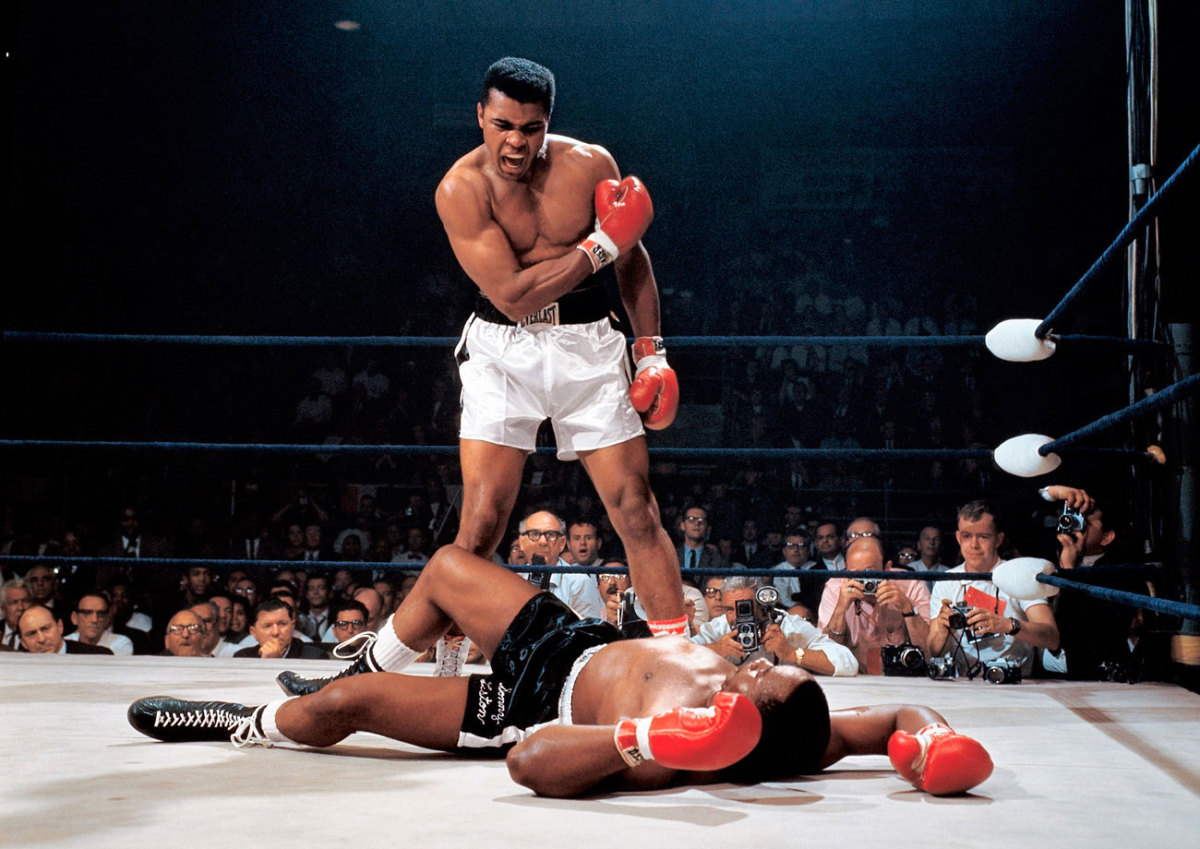
In one of the most iconic and controversial moments of his career, Ali stands over Sonny Liston and yells at him after knocking the former champ down in the first round of their 1965 rematch. Skeptics dubbed it "the Phantom Punch," but films show Ali's flashing right caught Liston flush, knocking him to the canvas. Refusing to go to a neutral corner, Ali stood over Liston and told him to "get up and fight, sucker."
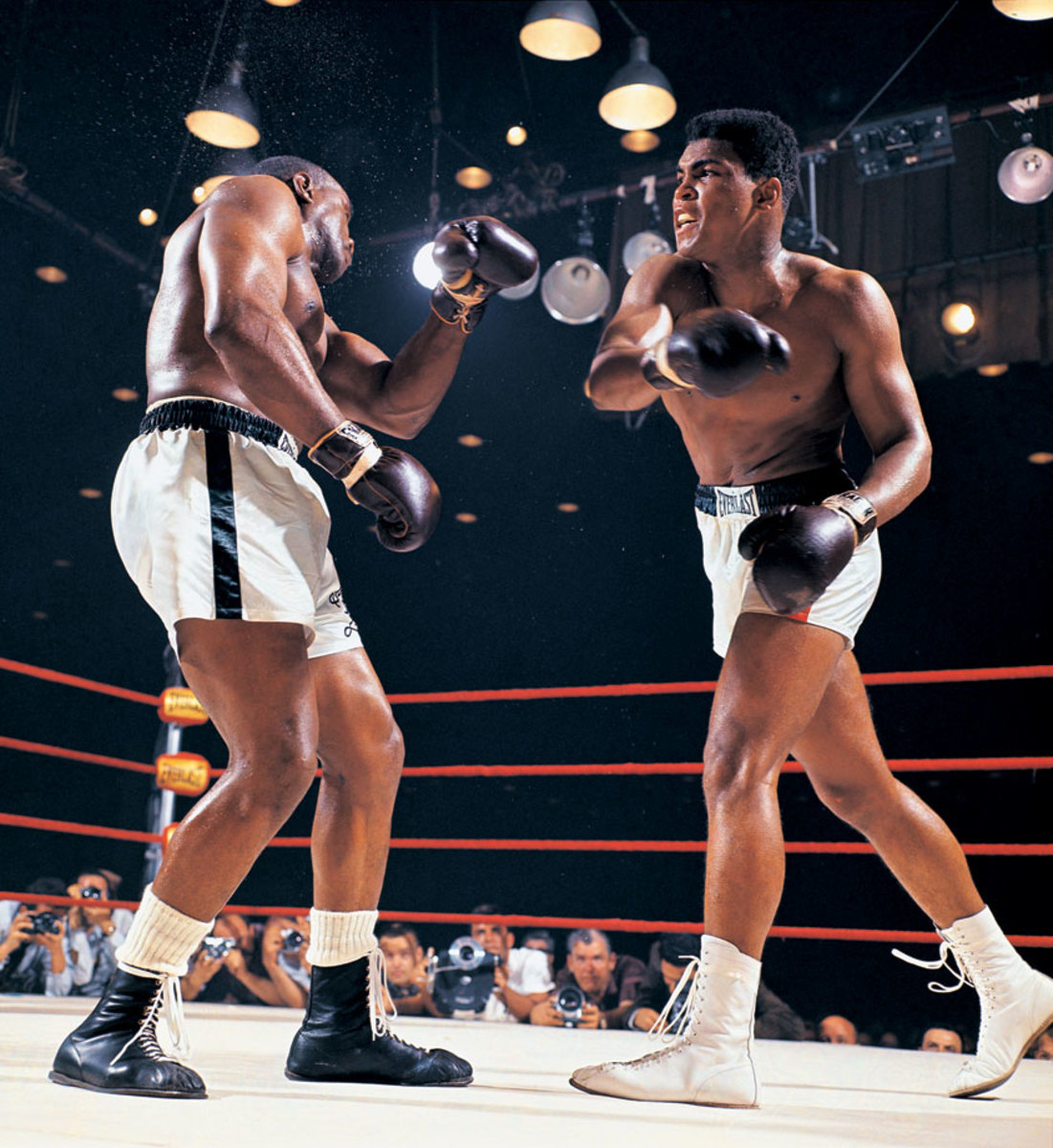
At 22-years-old, Cassius Clay (Muhammad Ali) battered the heavily favored Sonny Liston in a bout that shook the boxing world. The fight ignited the career of one of sports' most charismatic and controversial figures, whose bouts often became social and political events rather than simply sports contests. At the peak of his fame, Muhammad Ali was the best known athlete in the world. Liston, one of the most feared heavyweight champions in history, was a 1-8 favorite over the young challenger known as the Louisville Lip. But Clay, here stinging the champ with a right, used his dazzling speed and constant movement to dominate the action and pile up points.
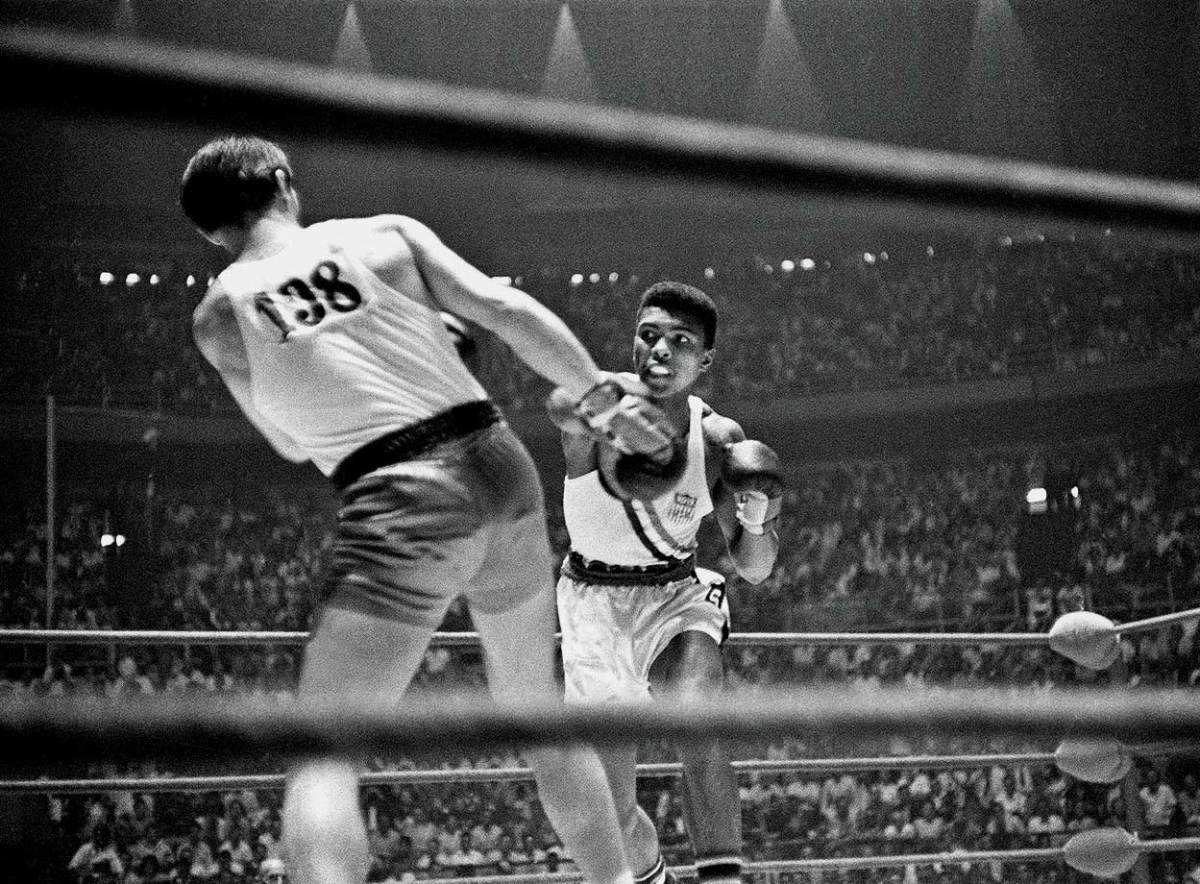
Cassius Clay punches Zbigniew Pietrzykowski of Poland during their gold medal bout at the 1960 Rome Olympics. Clay defeated Pietrzykowski 5-0 for the light heavyweight gold medal.
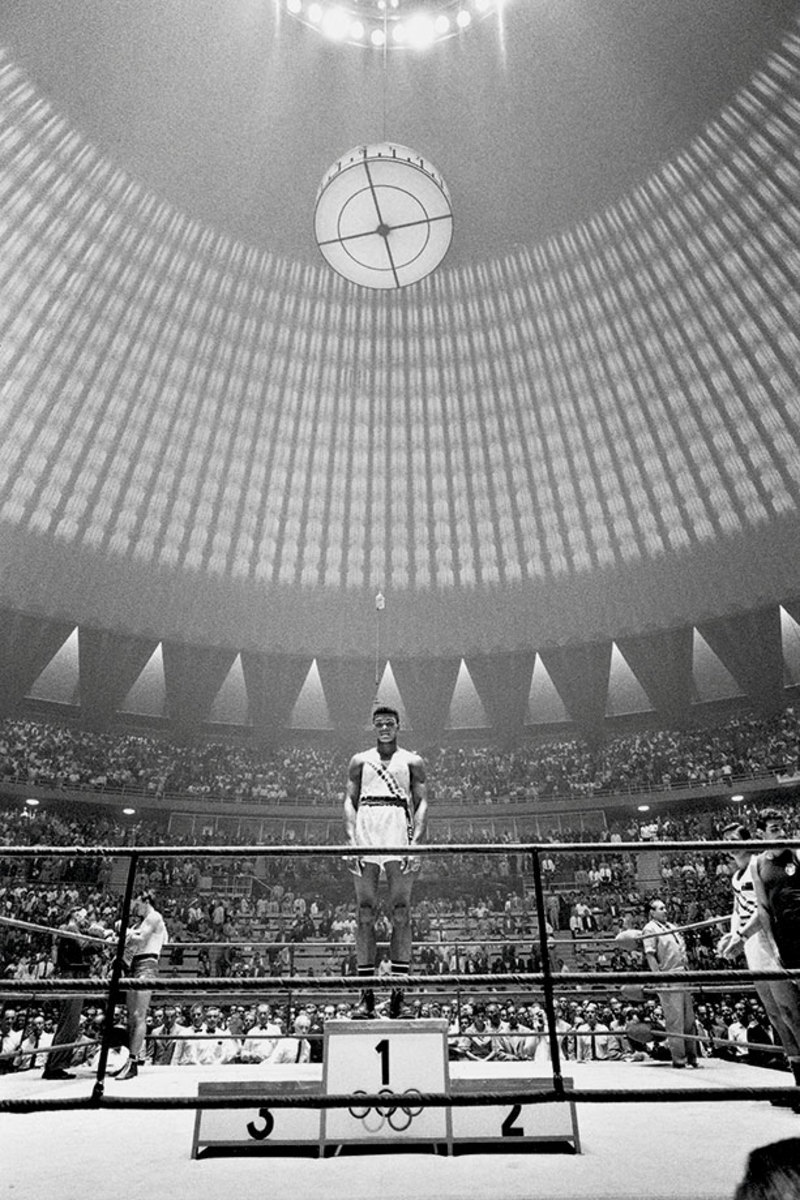
For the 18-year-old from Louisville, here atop the medal stand after his Olympic victory, all roads led from Rome. Clay finished his amateur career with a record of 100-5 and made his professional debut two months after the Games.
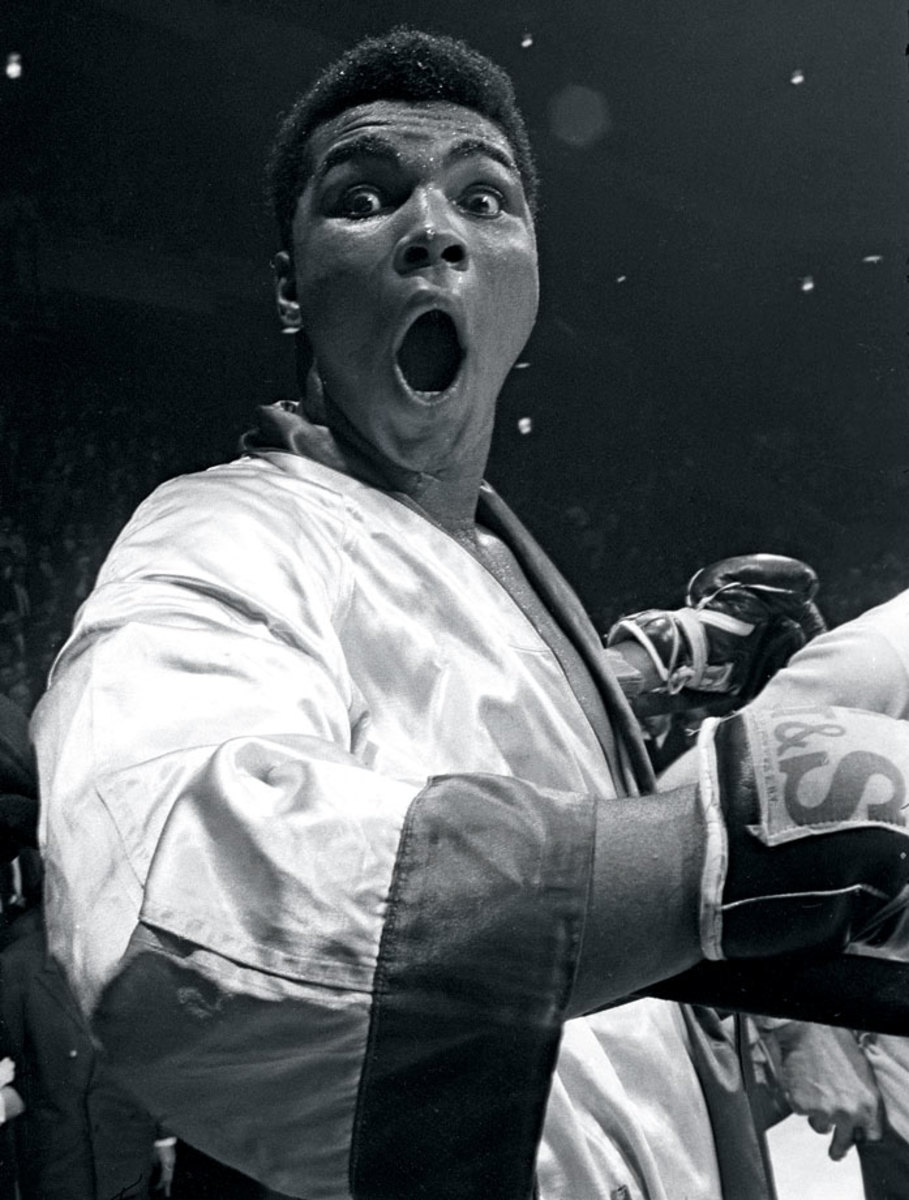
Undefeated in his first 17 pro fights, Clay mugged for the camera before the start of his 1963 bout against Doug Jones in Madison Square Garden.
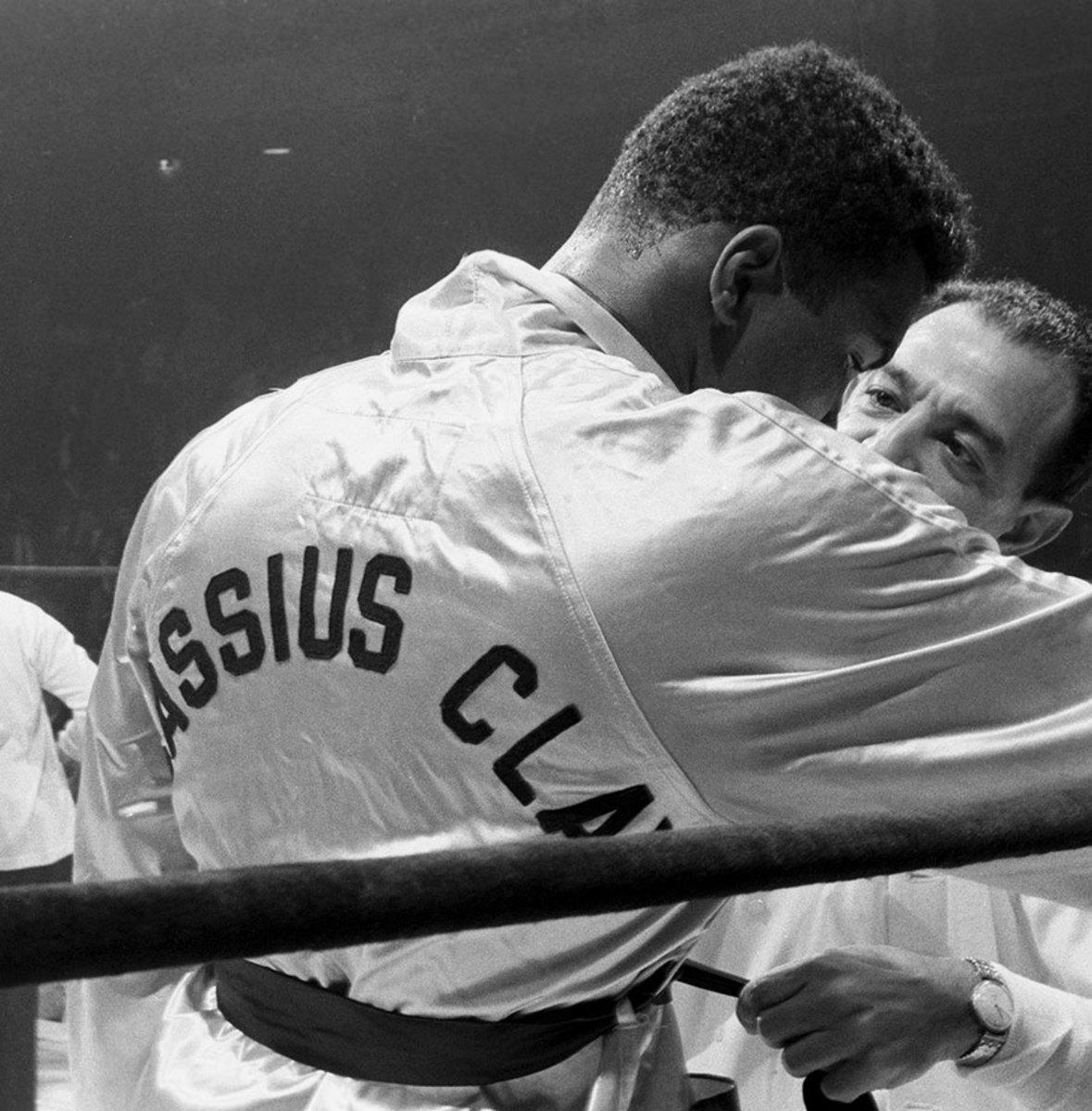
Trainer Angelo Dundee urged his young charge to get serious before the opening bell against Jones. Clay followed instructions and emerged from a tough fight with a unanimous decision victory. Three months later he would stop Henry Cooper and close out 1963 at 19-0.
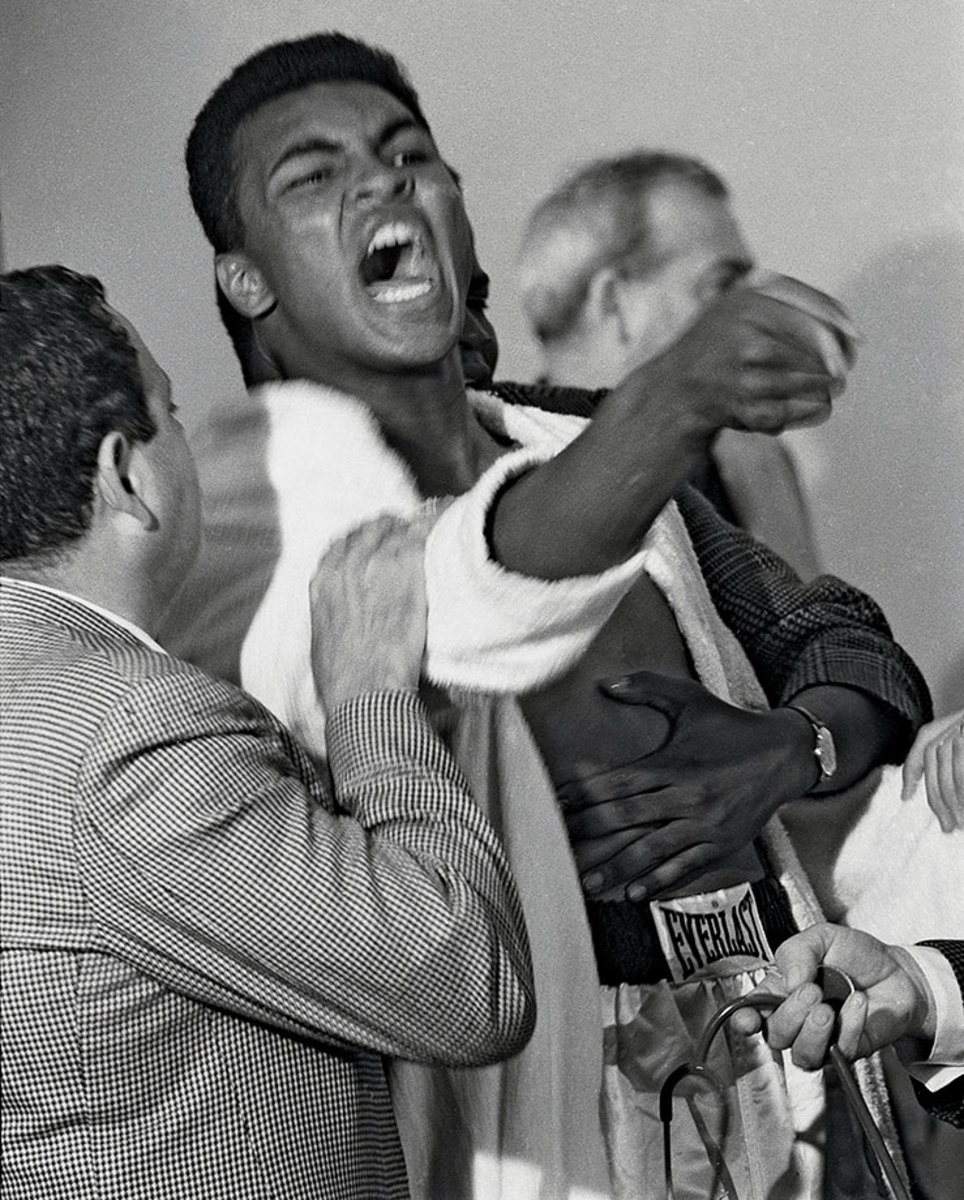
A seemingly hysterical Clay taunted Sonny Liston during the pre-fight physical for their 1964 bout. He had consistently baited the Big Bear during the lead-up to the fight, saying he was going to "use him as a bearskin rug ... after I whup him." The Miami Boxing Commission would fine Clay $2,500 for his outburst at the physical.
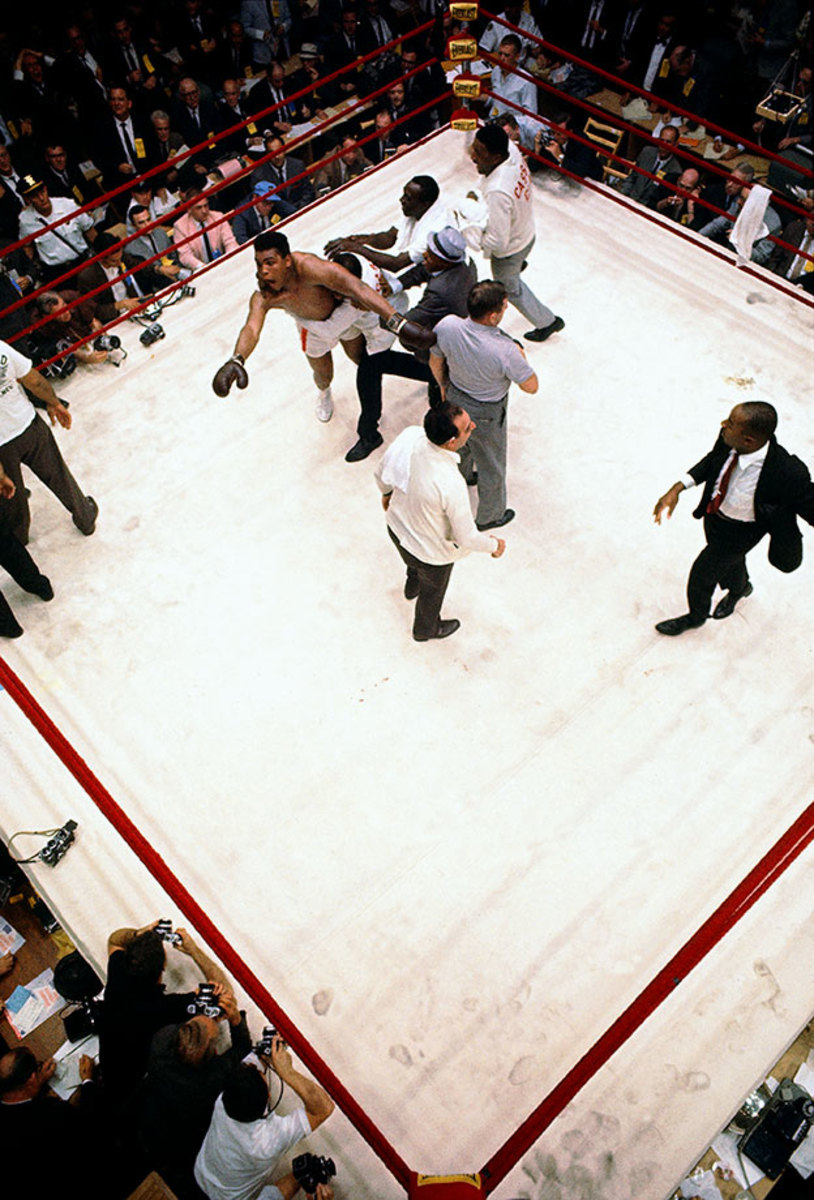
"I shook up the world!" an emotional Clay hollered to ringside reporters after his shocking defeat of Liston. And he did just that, claiming the heavyweight title at age 21 after a clearly beaten Liston, complaining of a shoulder injury, failed to answer the bell for the seventh round.
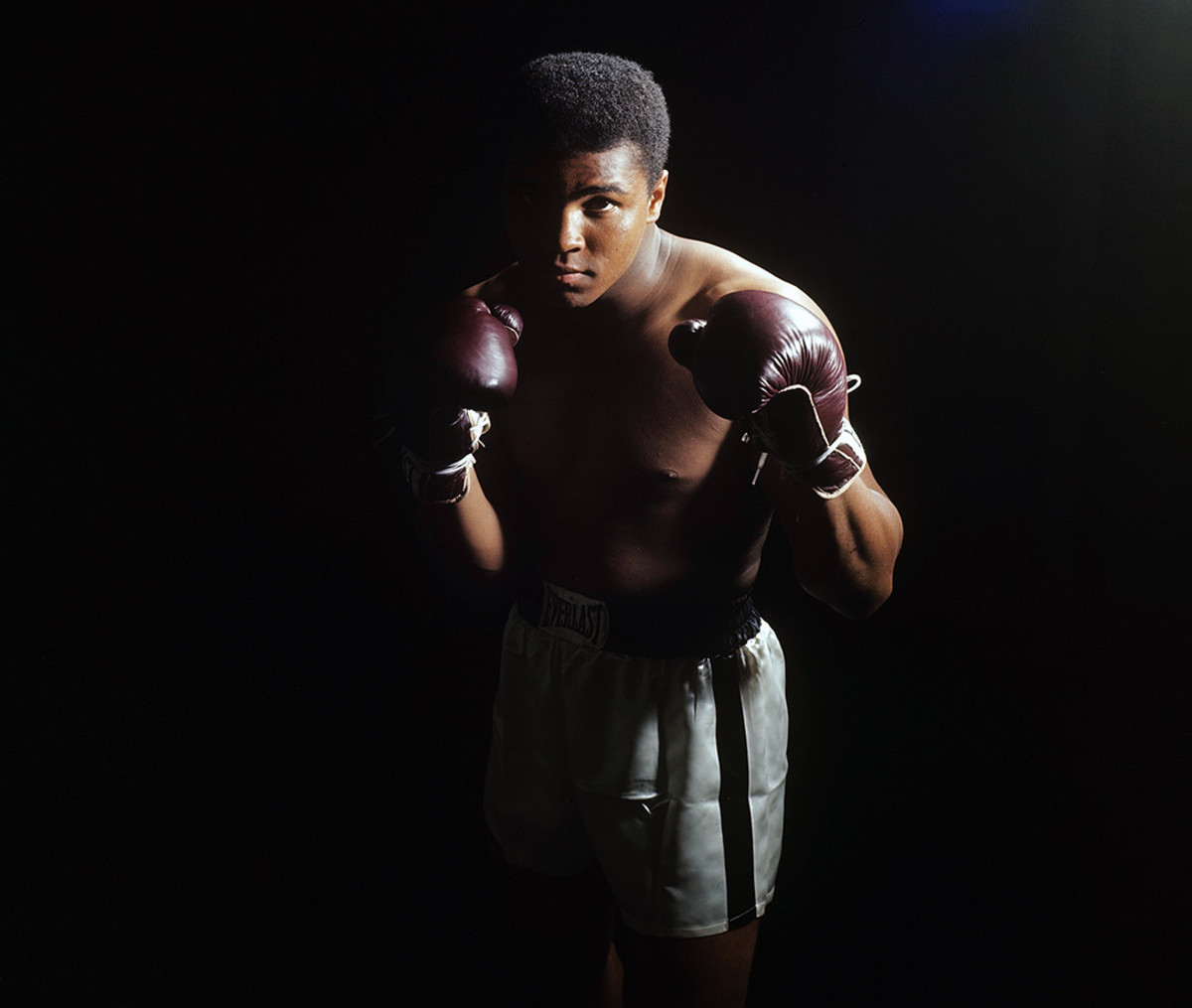
Draped in shadow, the young king — now known as Muhammad Ali — stared down the camera during a photo shoot in April 1965, one month before his rematch against Sonny Liston.
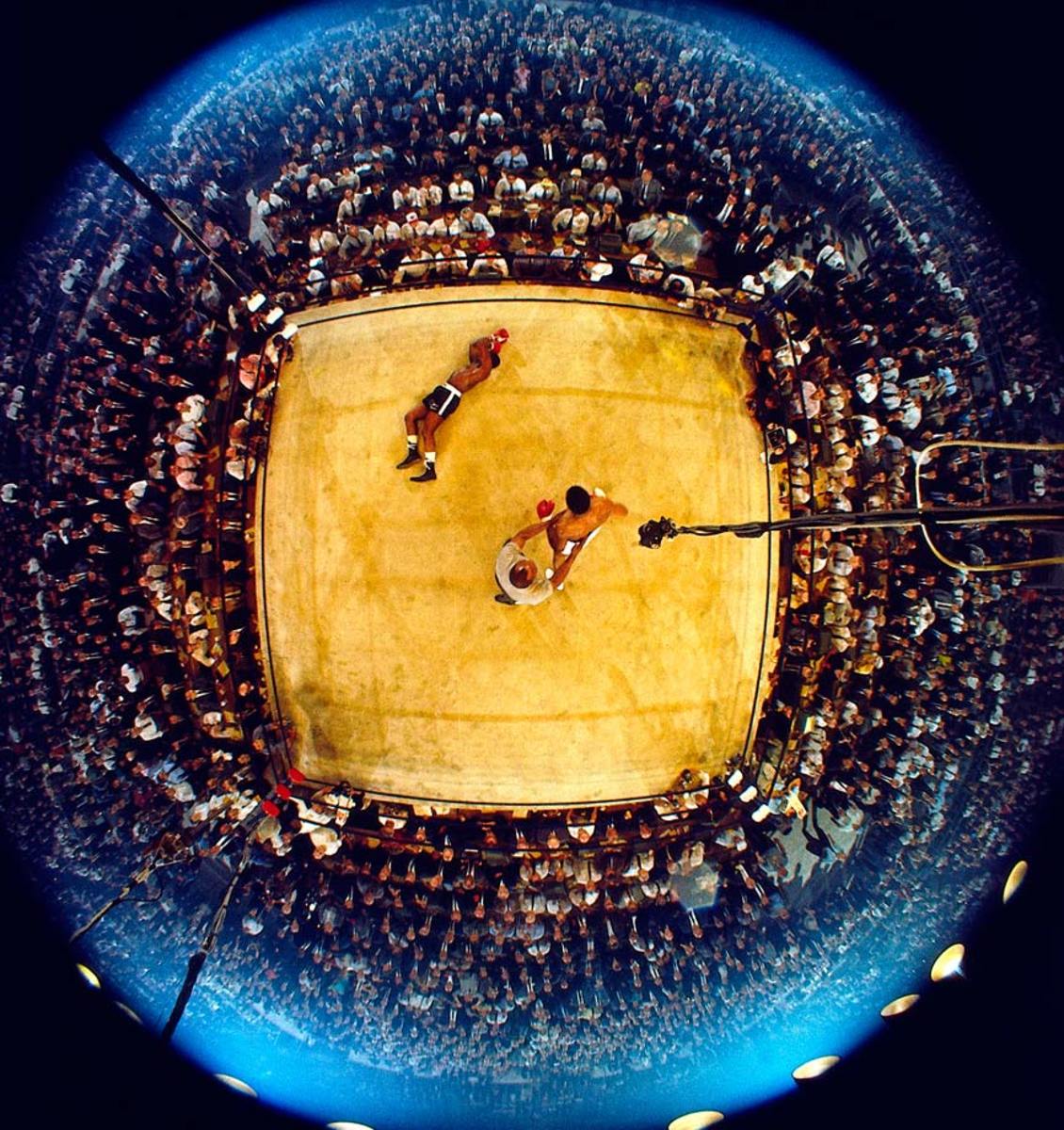
As Liston lingered on the canvas and the referee, former heavyweight champ Jersey Joe Walcott, tried to control Ali, the 2,434 spectators on hand in the Lewiston, Me., hockey arena — a record low for a heavyweight championship fight — tried to make sense of what all that had happened in less than two minutes after the opening bell.
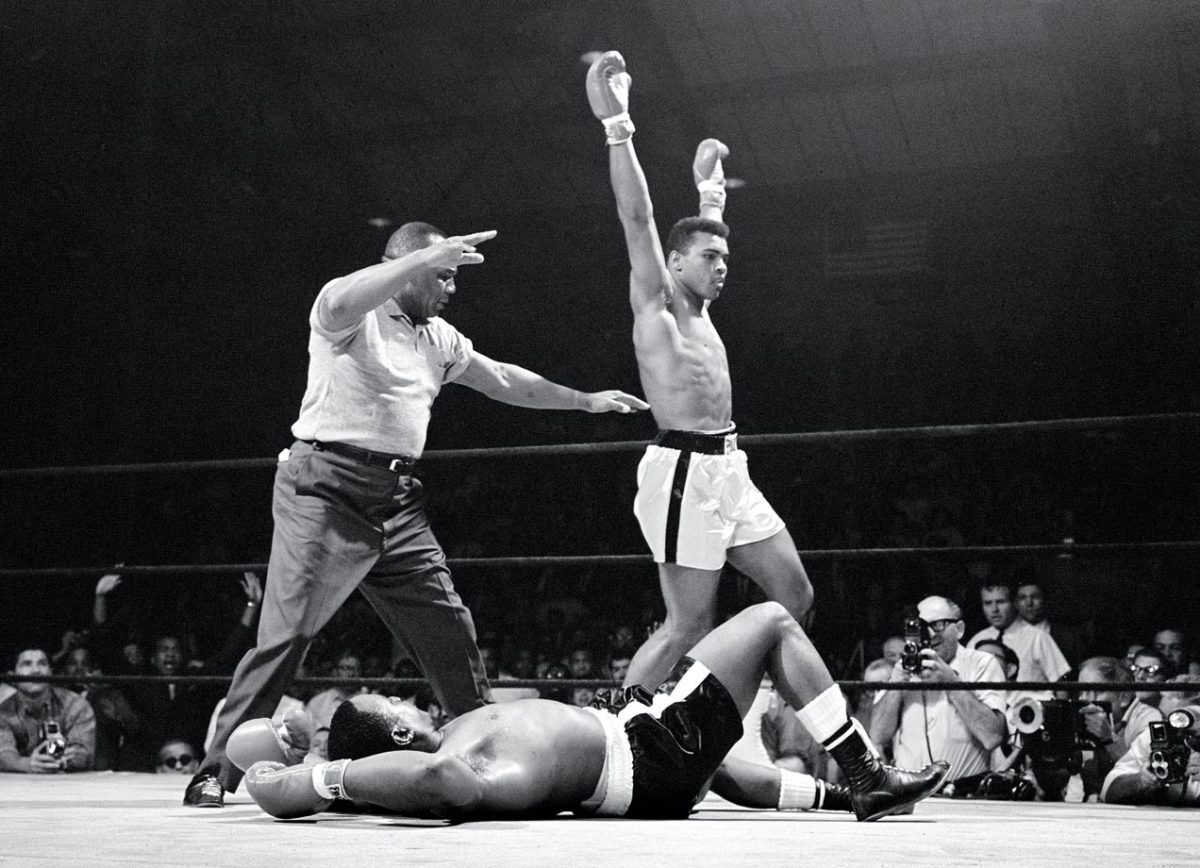
The celebration over Liston continued. In a chaotic ending, Ali was awarded a knockout when Nat Fleischer, publisher of The Ring, informed referee Jersey Joe Walcott from ringside that Liston had been on the canvas for longer than 10 seconds after Ali knocked him down. The bout remains one of the most controversial in boxing history, with many observers insisting that Liston took a dive.
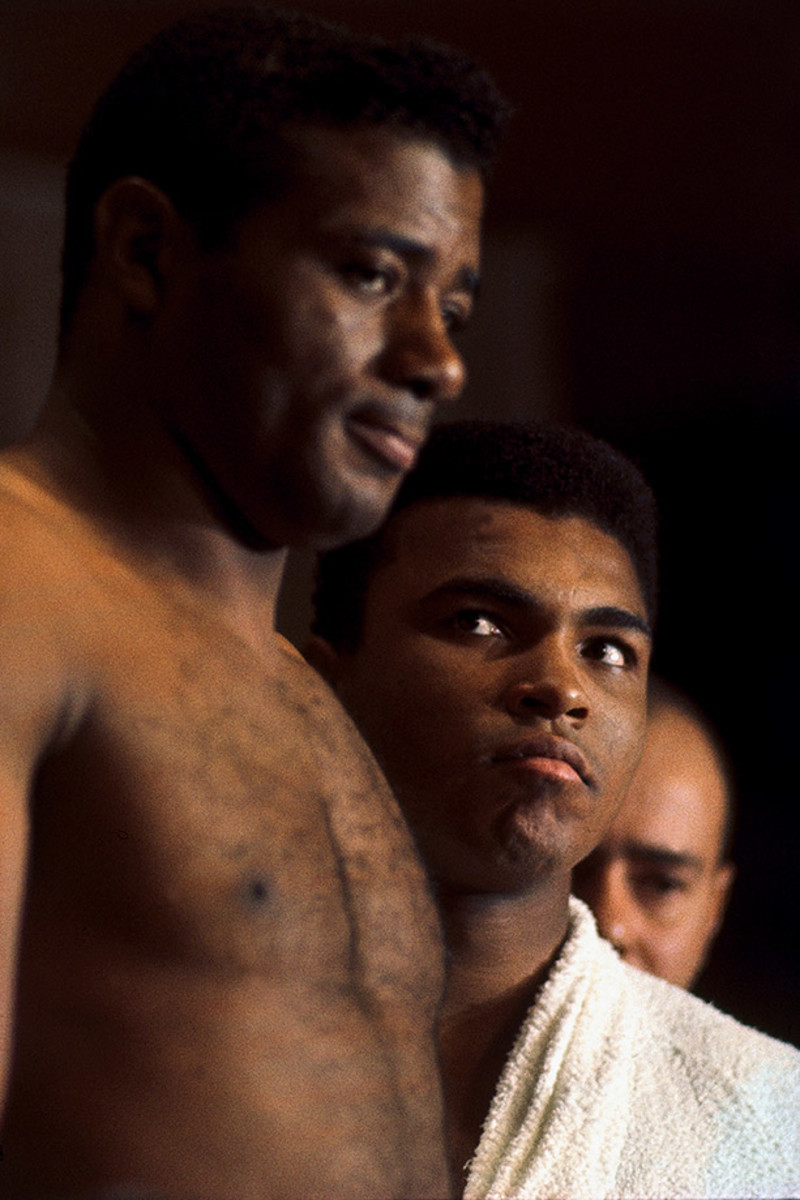
Ali's second title defense came in November 1965, against former two-time heavyweight champion Floyd Patterson. During the build-up to the bout, the normally soft-spoken Patterson earned the new champ's wrath by refusing to call Ali by his Muslim name. At the weigh-in, Ali's glare made it clear that he intended Patterson to pay for the disrespect.
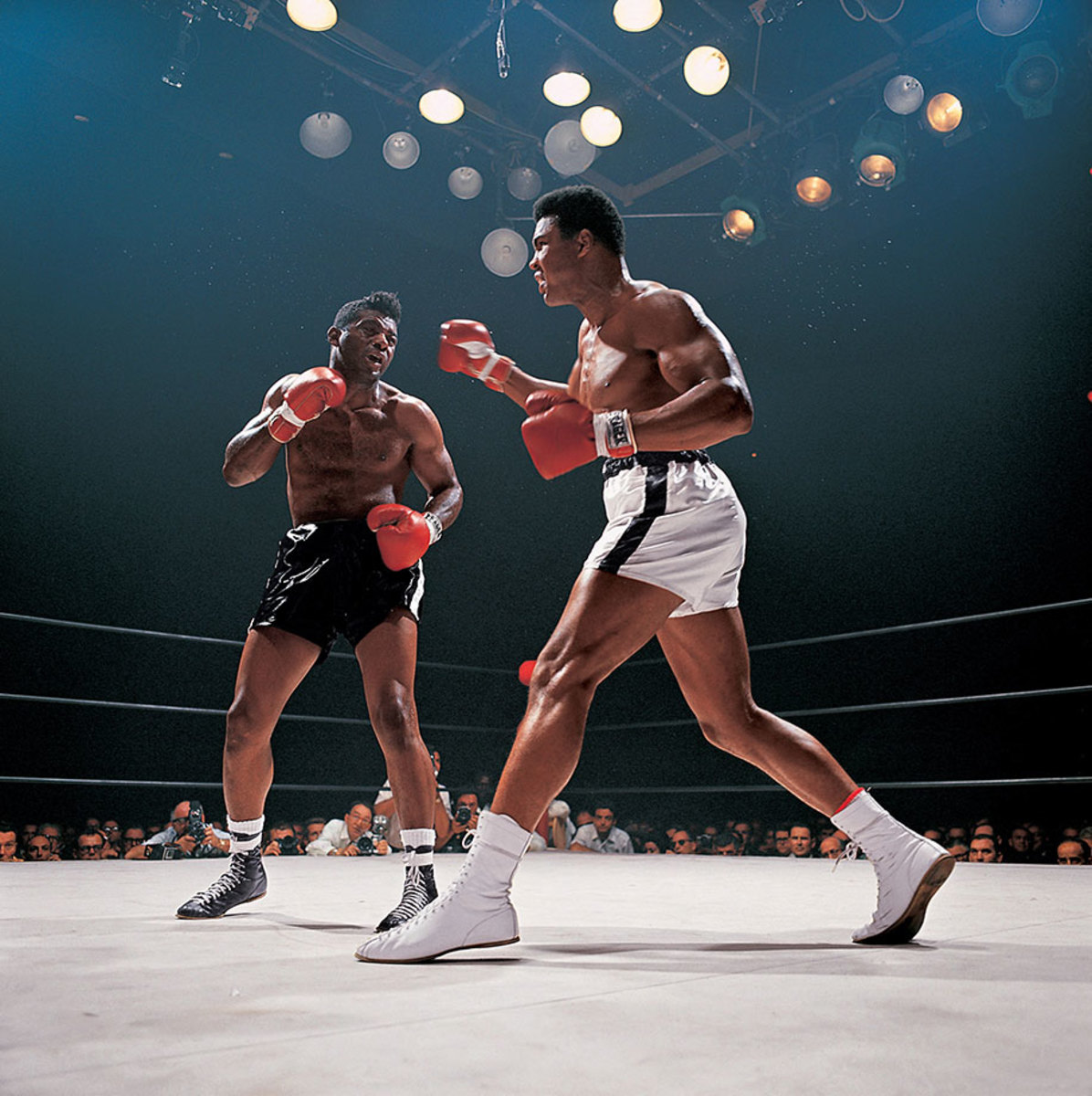
In cruelly efficient performance, Ali punished Patterson — who was hobbled by a painful back injury — seemingly toying with the former champ throughout the bout, hitting him at will and calling, "What's my name?" before finally winning on a 12th-round TKO.
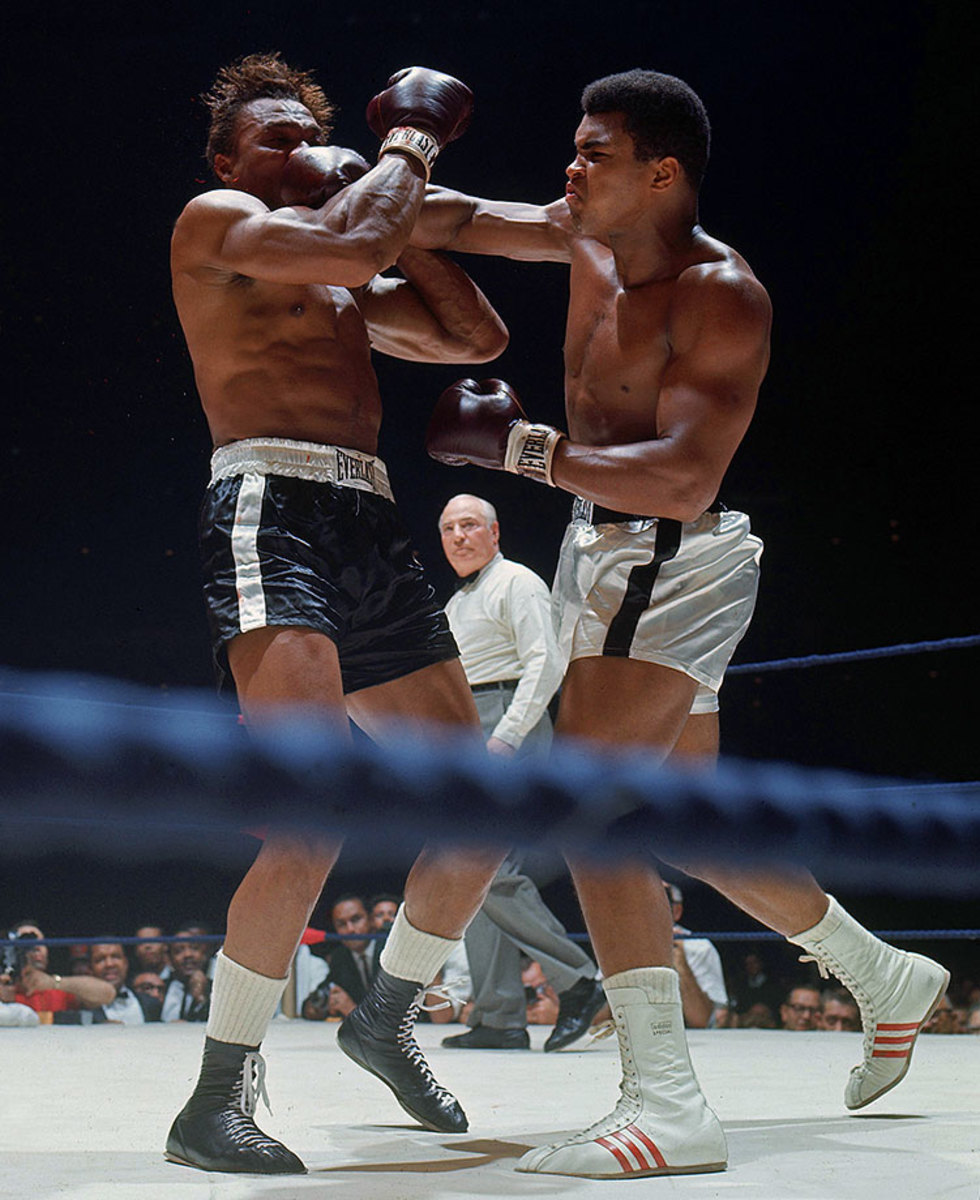
Capping off a five-fight campaign in 1966, Ali faced Cleveland Williams in the Houston Astrodome on Nov. 14. Known as the Big Cat, the heavily-muscled Williams was a power puncher who had racked up 51 knockouts in 71 fights. But he was also 33, barely recovered from a gunshot wound sustained the year before, and up against a young champion very much in his prime. Ali wasted little time in unleashing a withering attack.
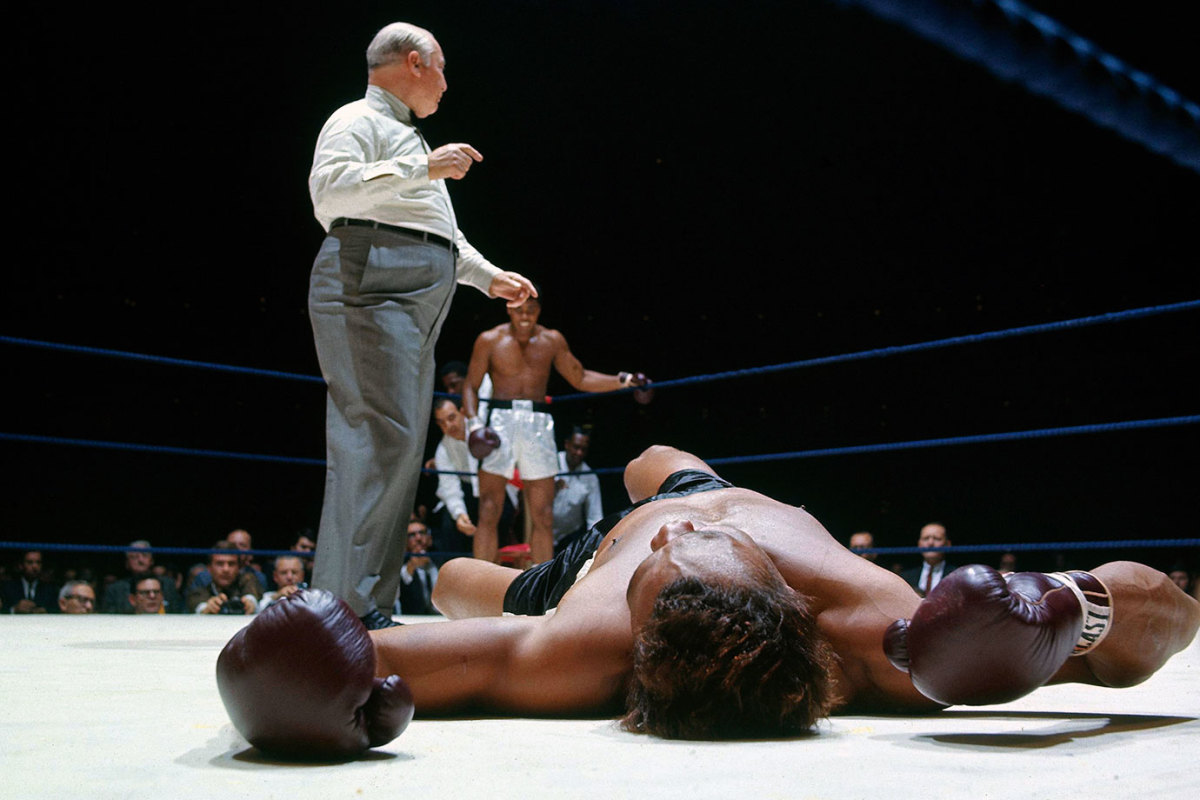
Float and sting: In a display of speed and combination punching unmatched in heavyweight history, Ali overwhelmed Williams from the start. The challenger, here down for the third time in round 2, would be saved by the bell before referee Harry Kessler could count him out, but it would only postpone the inevitable.
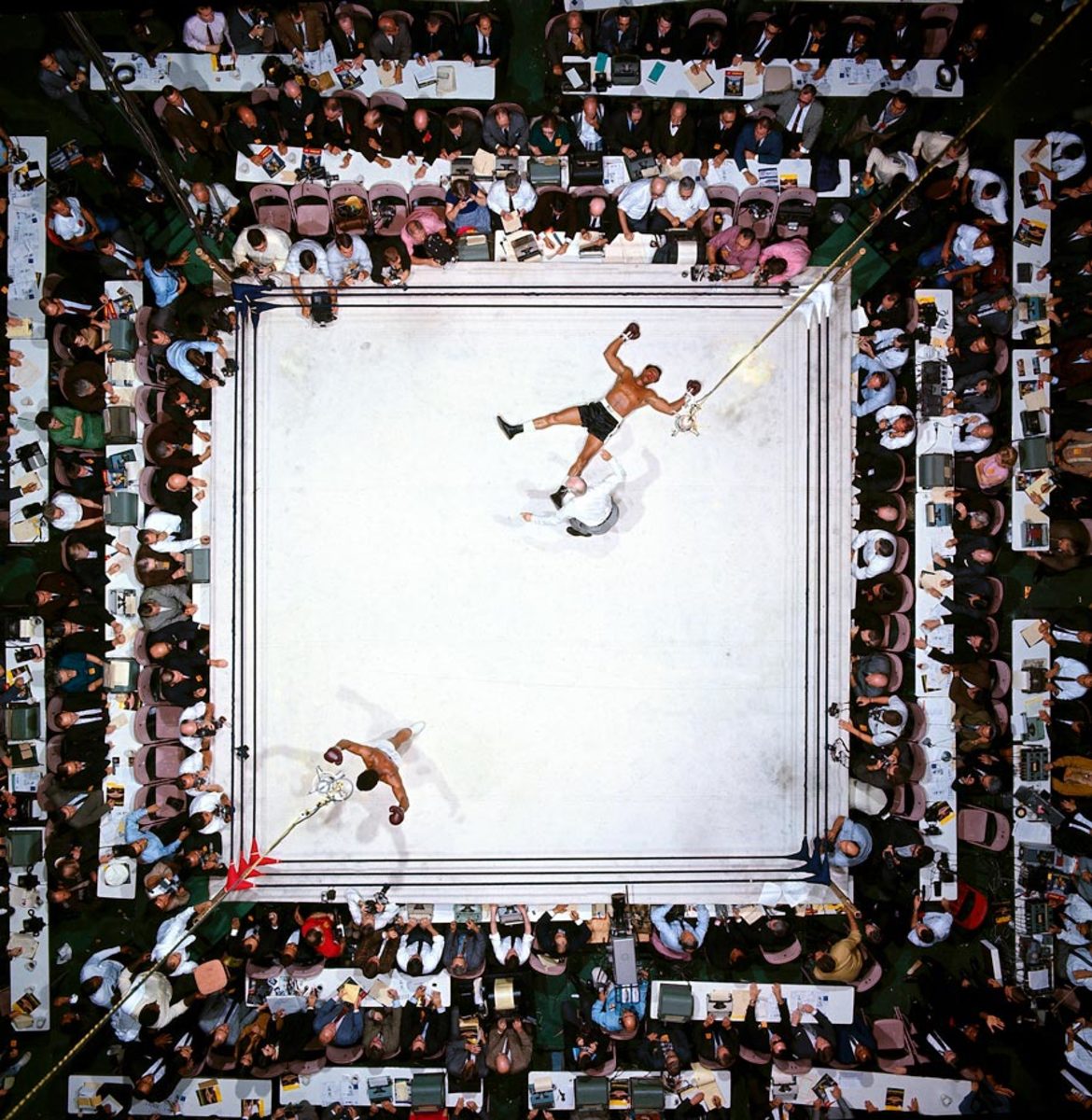
Ali dropped Williams again early in the third round, and Kessler waved the mismatch over at 1:08 of the third.
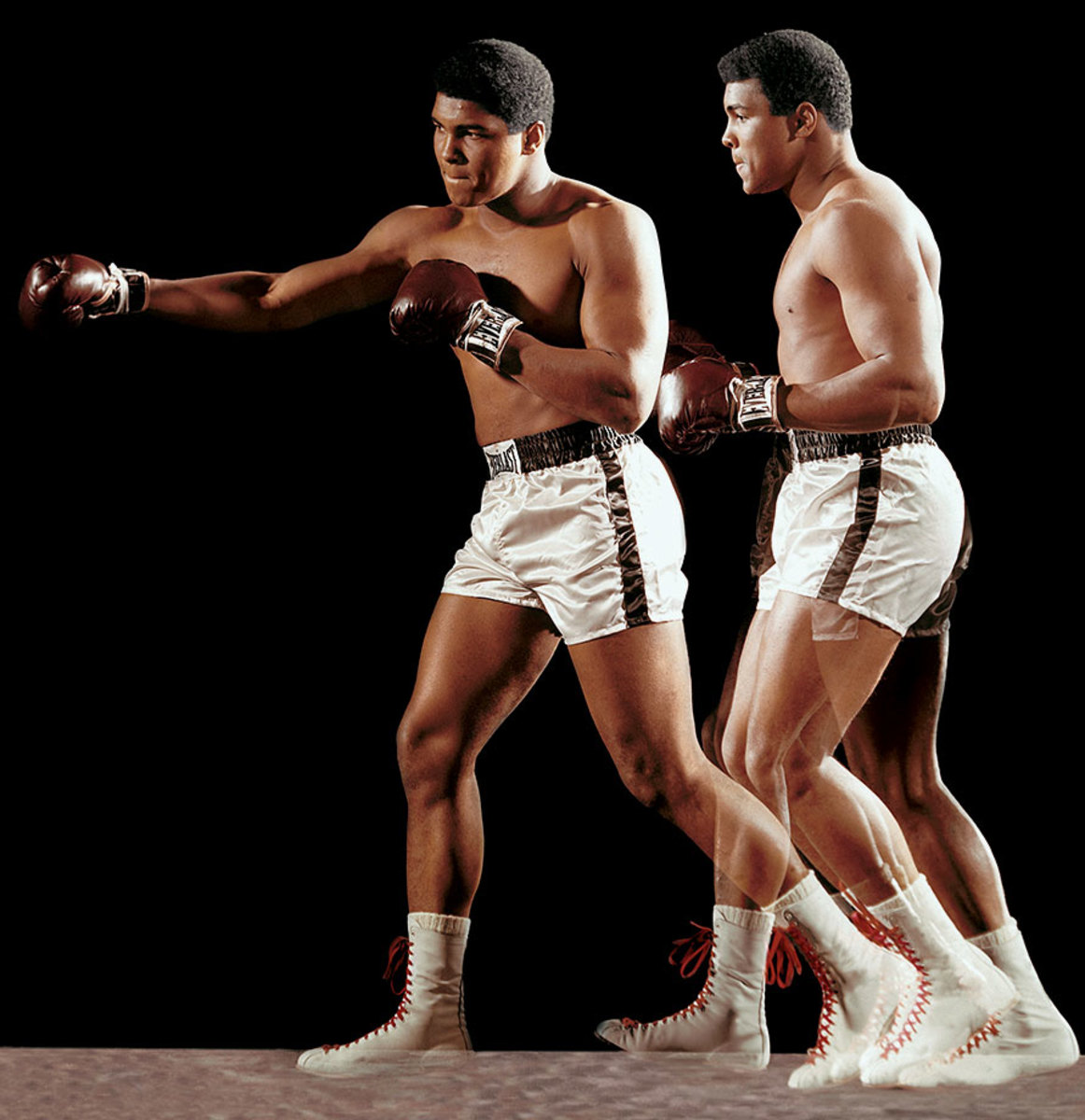
In a multiple-exposure portrait, Ali demonstrates his signature double-clutch shuffle during a photo shoot in December 1966.
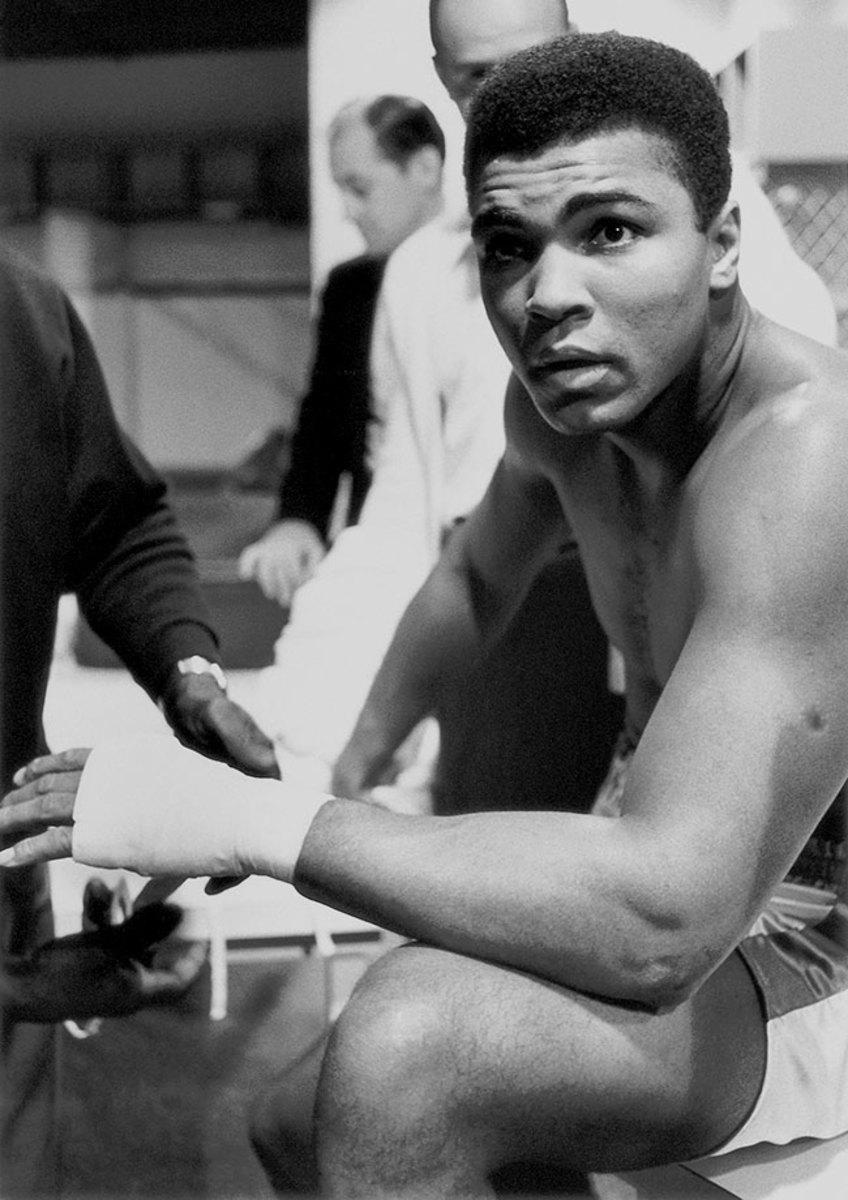
Ali sits in the locker room before his February 1967 fight against Ernie Terrell. Like Patterson before him, Terrell refused to call the champion by his Muslim name. Also like Patterson, he paid a stiff price, as Ali punished Terrell for 15 ugly rounds before winning by unanimous decision.
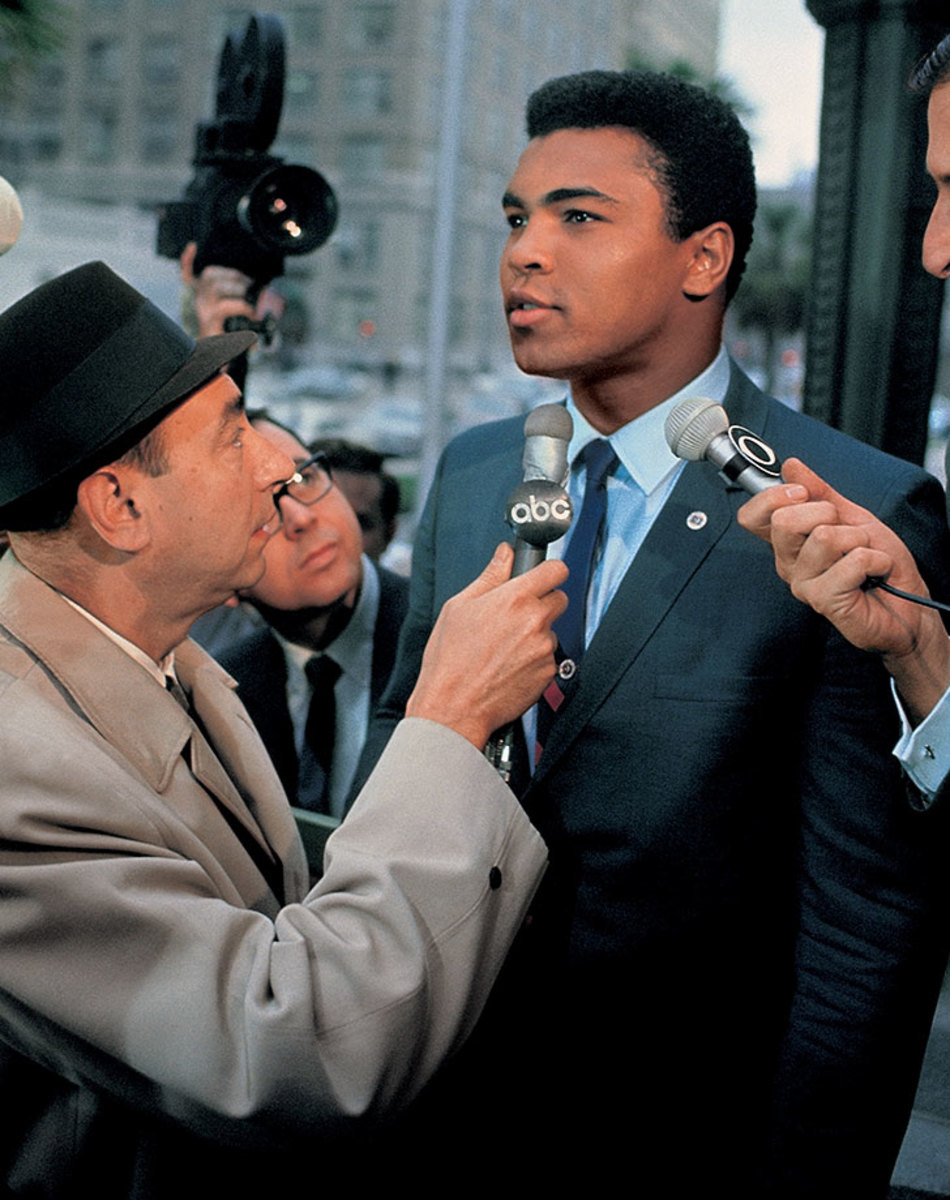
Outside the Armed Forces Examining and Entrance Station in Houston in April 1967, Ali spoke to the press about his refusal to be inducted into military service. Among those on hand was ABC's Howard Cosell, who would be a staunch supporter of the fighter's stance. The decision cost Ali his boxing license and his heavyweight title, and he was sentenced to five years in prison but remained free pending an appeal.
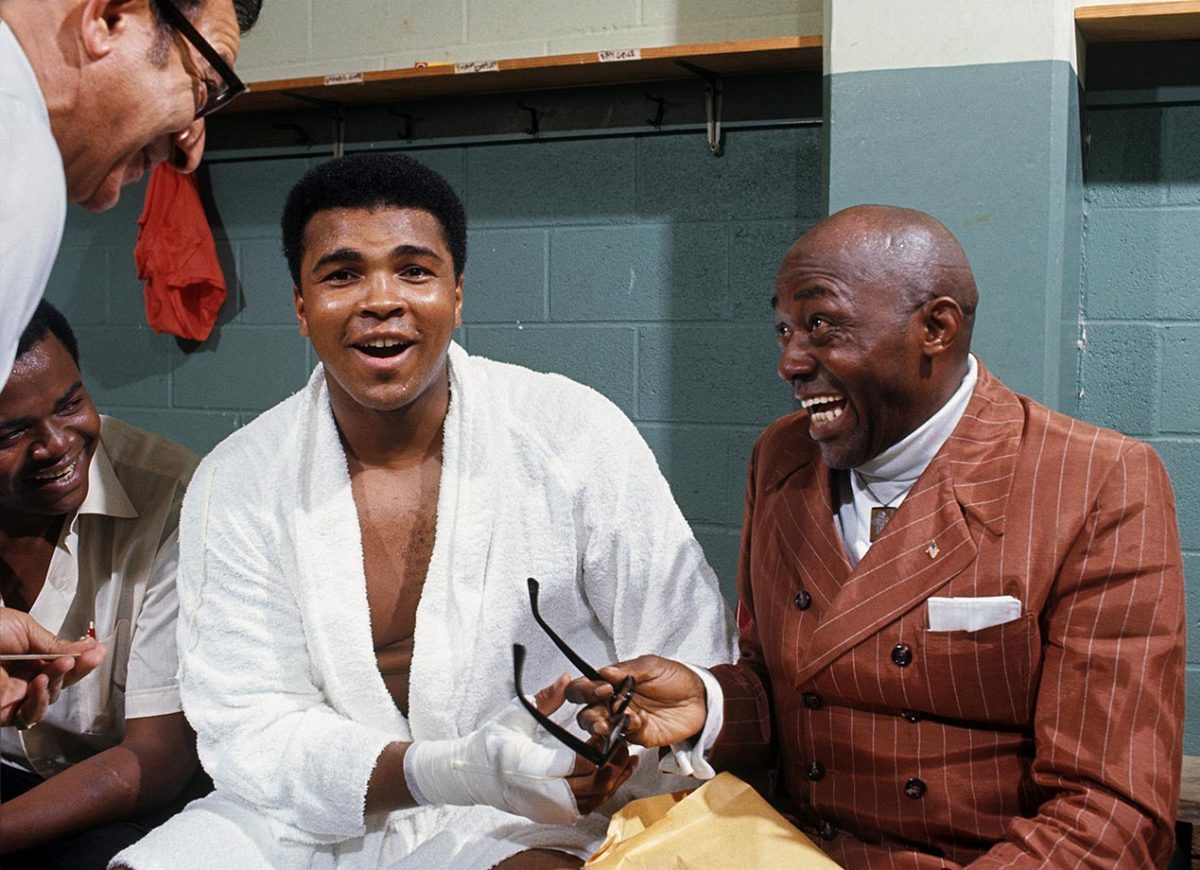
In professional exile for three and a half years because of his draft case, Ali sought to return to boxing in 1970. He began with a night of exhibition bouts at Morehouse College in Atlanta, where before going into the ring, he shared a locker room laugh with actor and comedian Lincoln Perry (right), better known by his stage name of Stepin Fetchit. The friendship between the two black icons would later be examined in an acclaimed play by Will Power, Fetch Clay, Make Man.
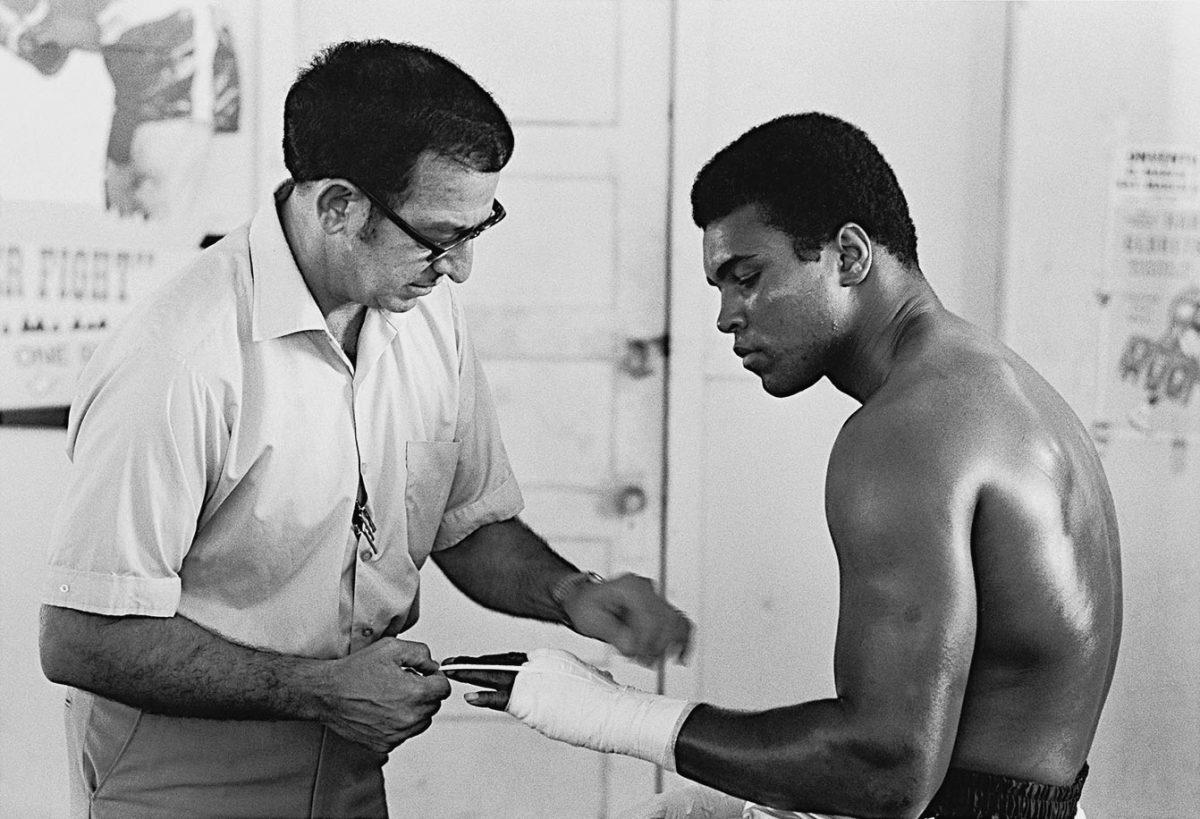
After the Atlanta Athletic Commission at last granted Ali a license, the deposed champion went back into serious training. He was, as ever, in the capable hands of trainer Angelo Dundee, here wrapping boxing's most famous fists at the 5th Street Gym in Miami in October 1970.
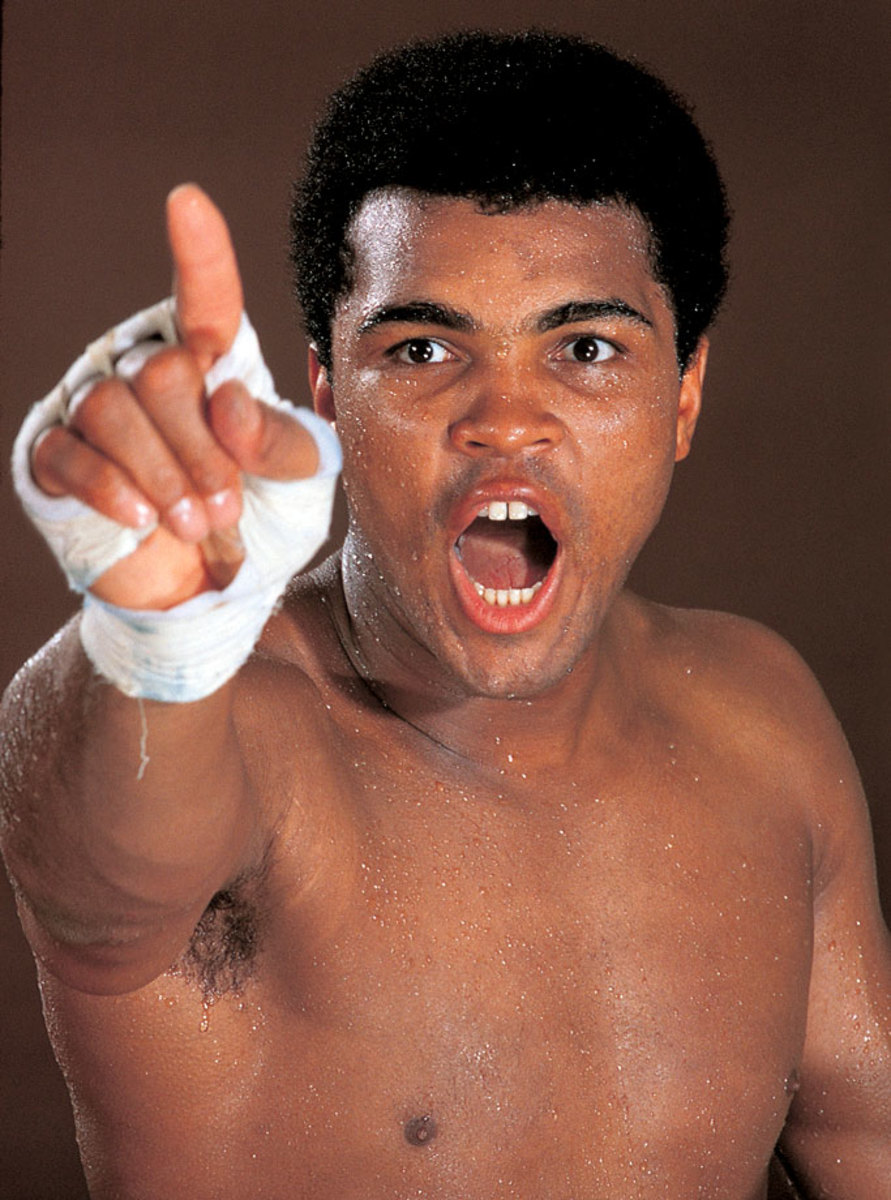
With his return to the ring scheduled for Oct. 26, 1970 in Atlanta, against dangerous contender Jerry Quarry, Ali made it clear to all who would listen that he was on a mission to reclaim the title that had been stripped of him.
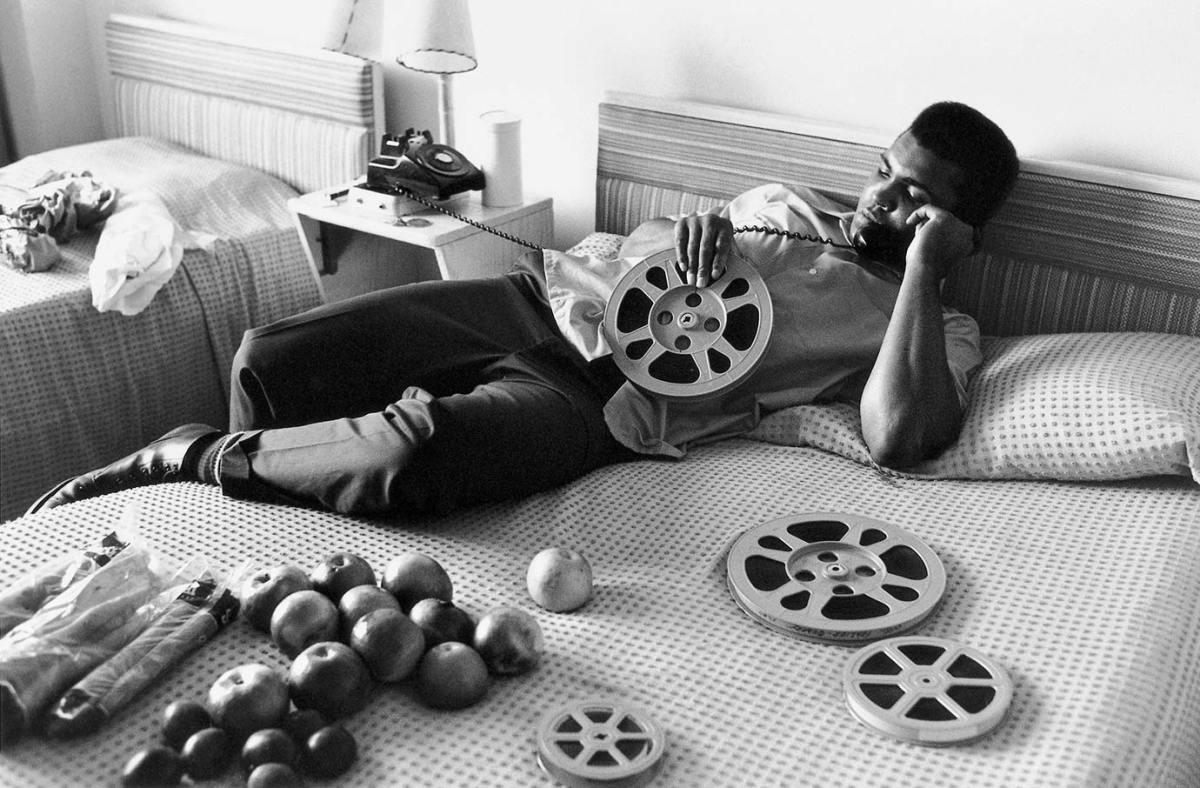
Reel to spiel: For the ever-loquacious Ali, even a rare moment of down time — like this afternoon in 1970 in a Miami hotel room — was a chance to do some talking.
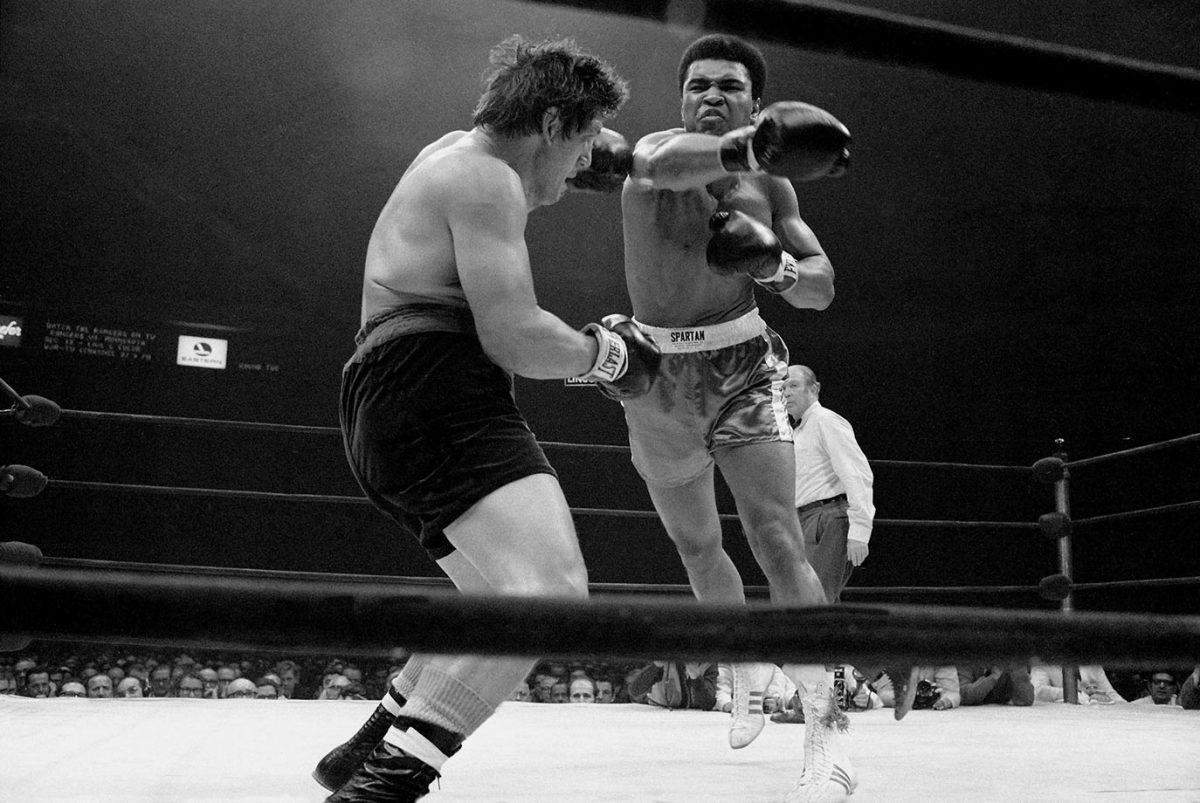
Despite Ali's long layoff, his comeback campaign would include no easy tune-up bouts. He stopped Quarry in three rounds on Oct. 26, 1970, then, just six weeks later — an unthinkably short interlude by today's standards — took on Argentine contender Oscar Bonavena in Madison Square Garden. Here, Ali fires a right at the rugged and awkward Bonavena, who took the fight to the former champion all night.
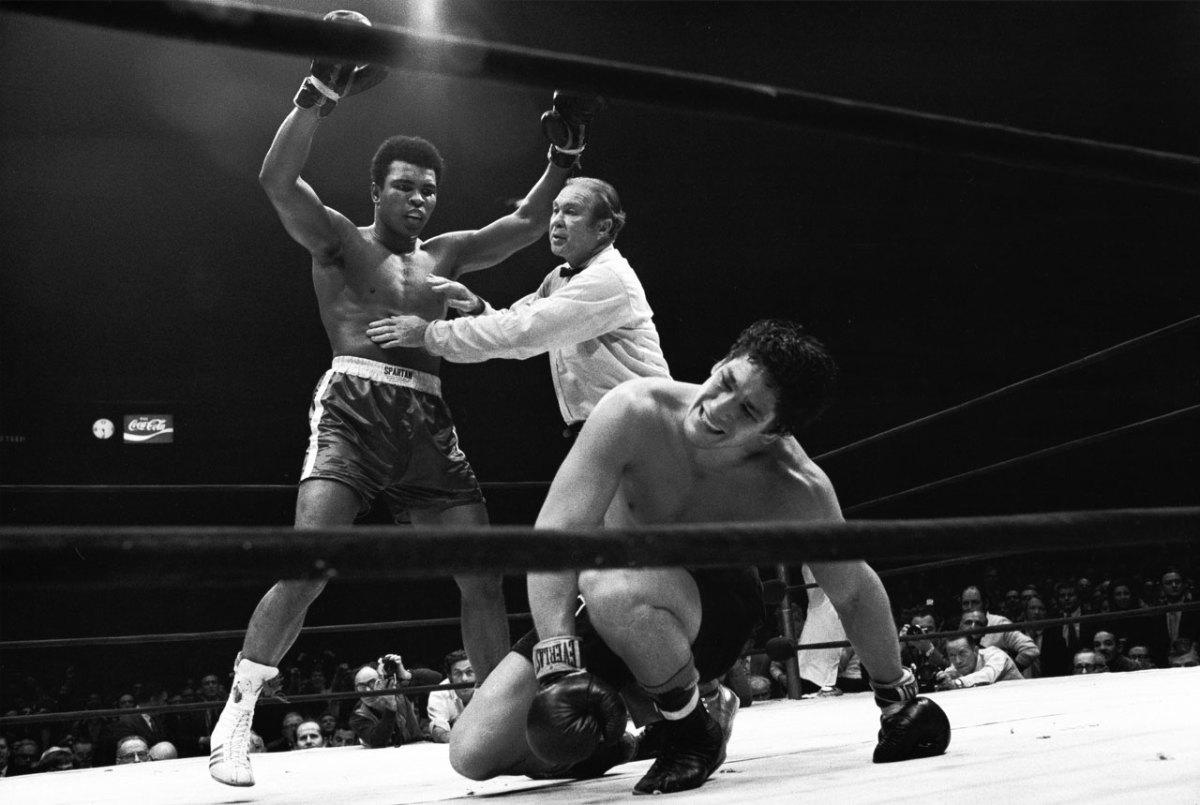
After a long, often sloppy bout, Ali — here being held back by referee Mark Conn — produced one of the most dramatic finishes of his career, dropping Bonavena three times in the 15th and final round to automatically end the fight. The win cleared the way for a showdown with Joe Frazier, the man who had taken the heavyweight title in Ali's absence.
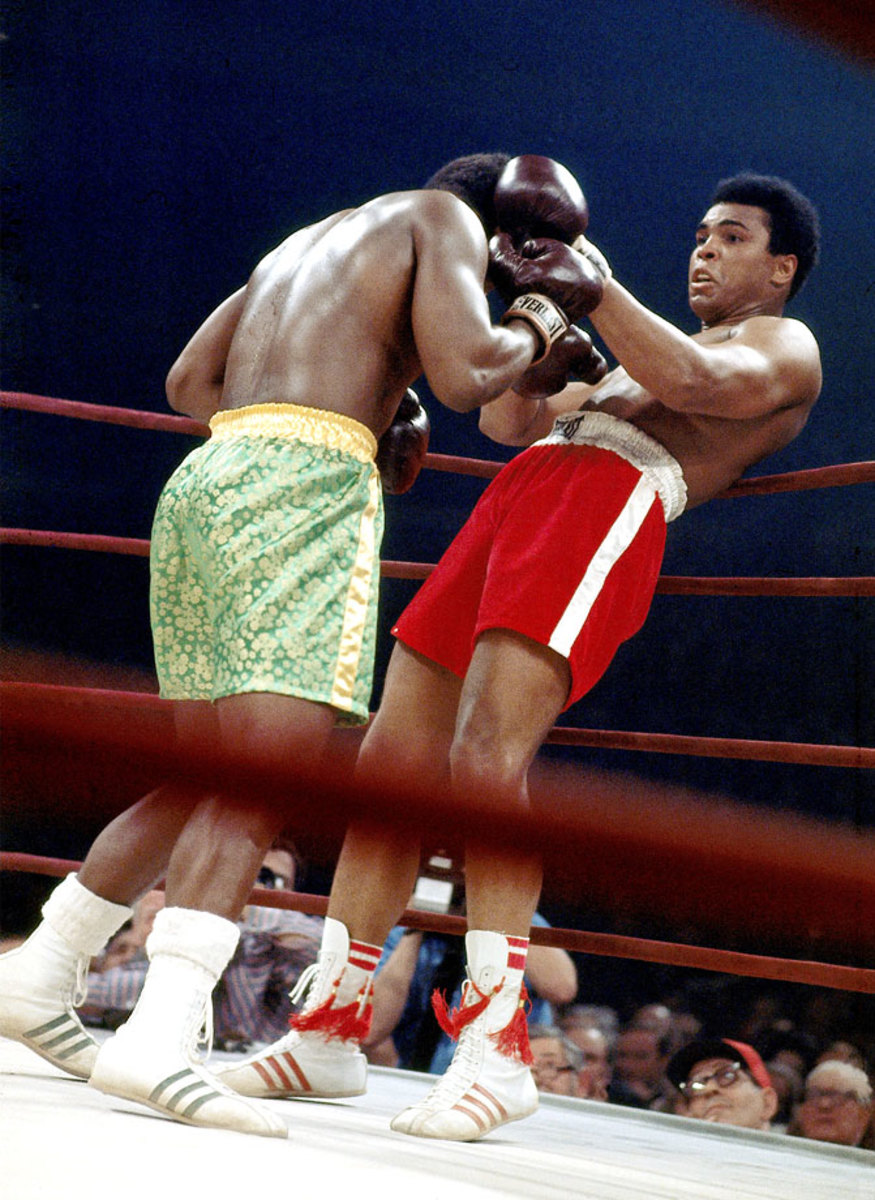
On the night of March 8, 1971, the eyes of the world were on a square patch of white canvas in the center of Madison Square Garden. There, Ali and Joe Frazier met in what was billed at the time simply as The Fight, but has come to be known, justifiably, as the Fight of the Century. For 15 rounds the two undefeated heavyweights battled at a furious pace, with each man sustaining tremendous punishment. In the end Frazier prevailed, dropping Ali in the final round with a tremendous left hook to seal a unanimous decision and hand The Greatest his first loss in 32 professional fights.
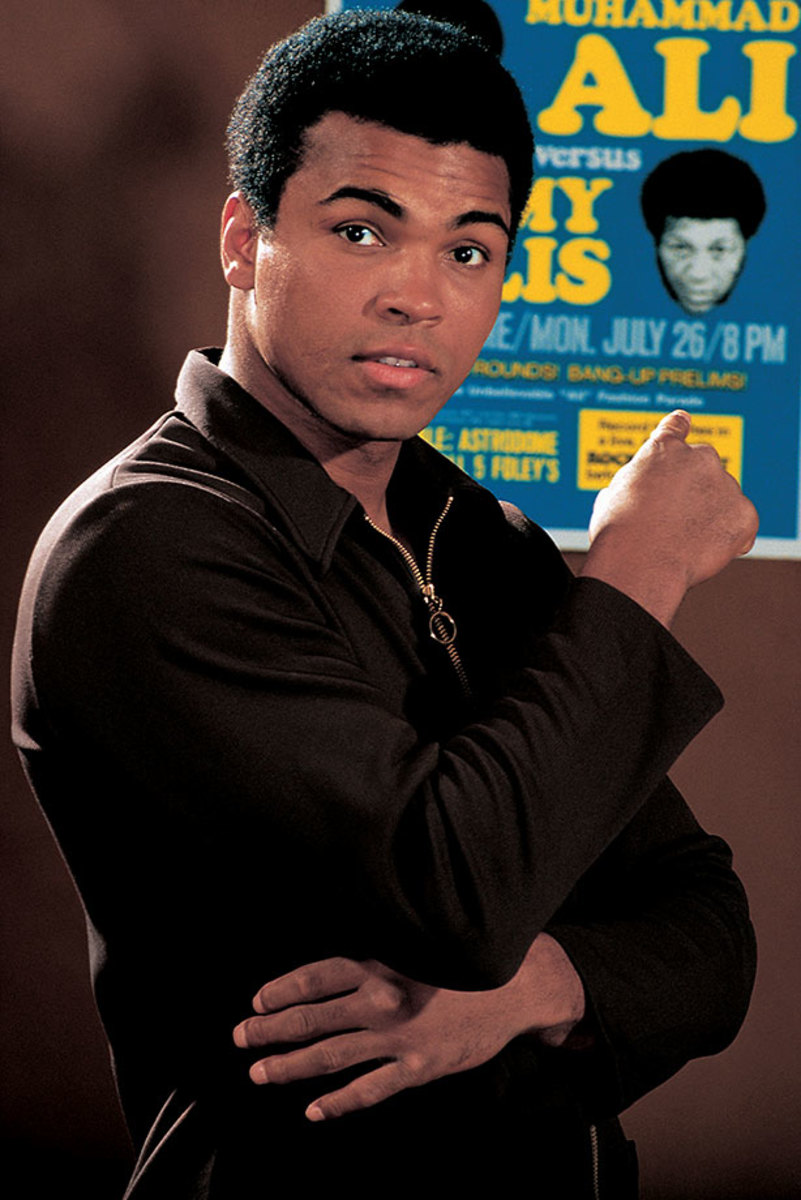
Ali poses with the fight poster for his upcoming fight against Jimmy Ellis during a photo shoot in July 1971. Ellis was an old friend of Ali's — both were trained by Angelo Dundee — and knew his fighting style well from many rounds of sparring.
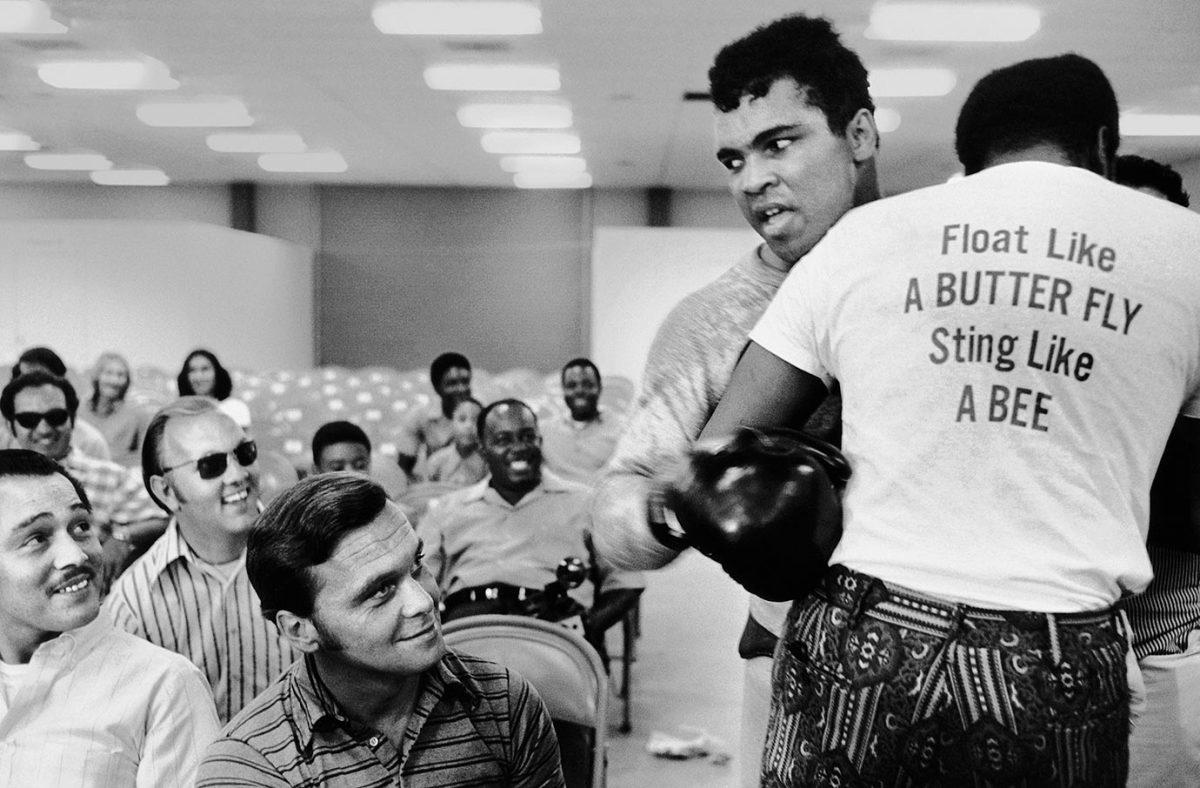
For those sportswriters lucky enough to cover Ali on a regular basis, each day brought surprises and, more often than not, plenty of laughs. of Trainer Drew Bundini Brown helps Ali train for his fight against Ellis. Ali won the bout by technical knockout in the 12th round to claim the vacant NABF heavyweight title.
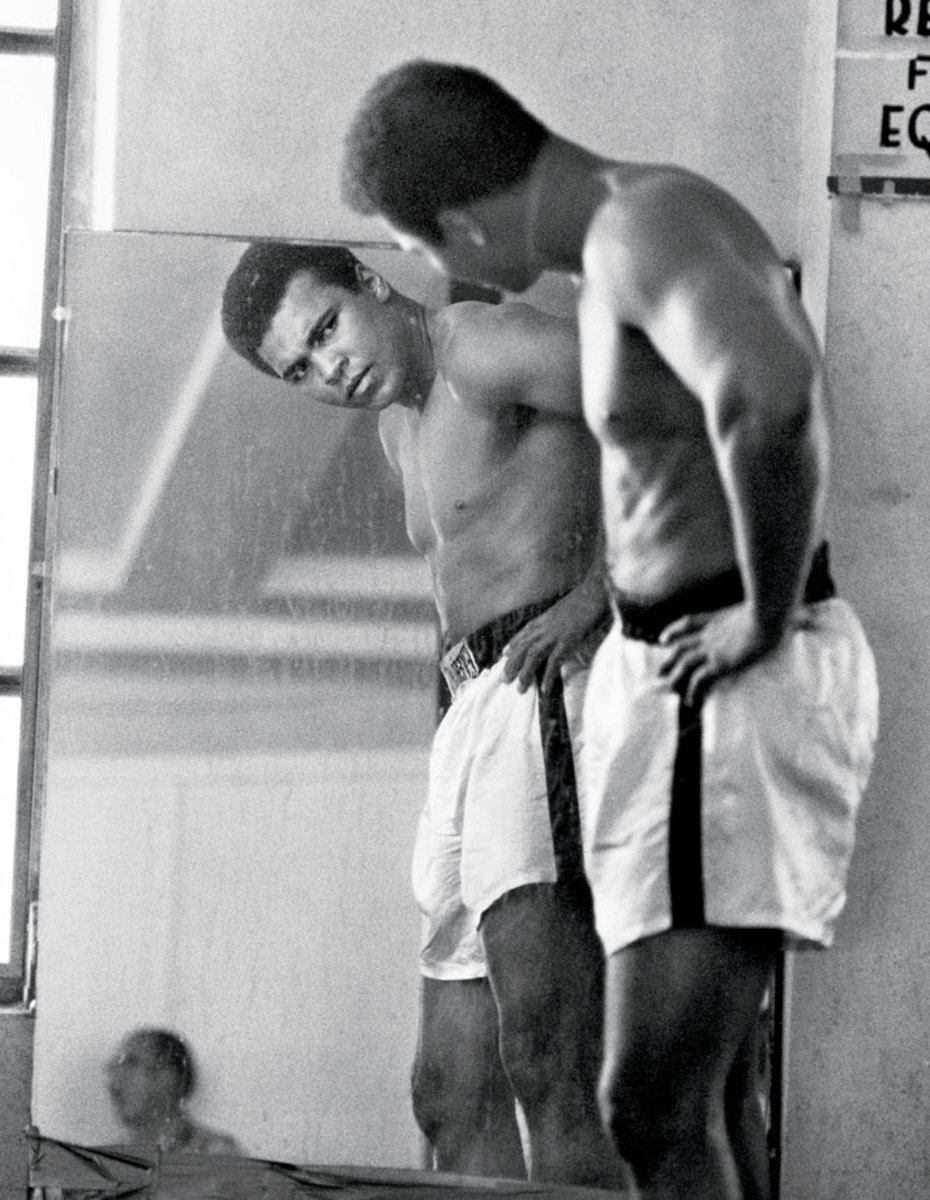
The man in the mirror stares back as Ali examines himself while training for a fight in 1972. He won all six of his fights that year.

The Louisville Lip stands next to George Foreman before Ali's fight versus Jerry Quarry in June 1972. Ali won by technical knockout in the seventh round. Foreman at the time was 36-0. Ali would not get his shot against Foreman for more than two years.
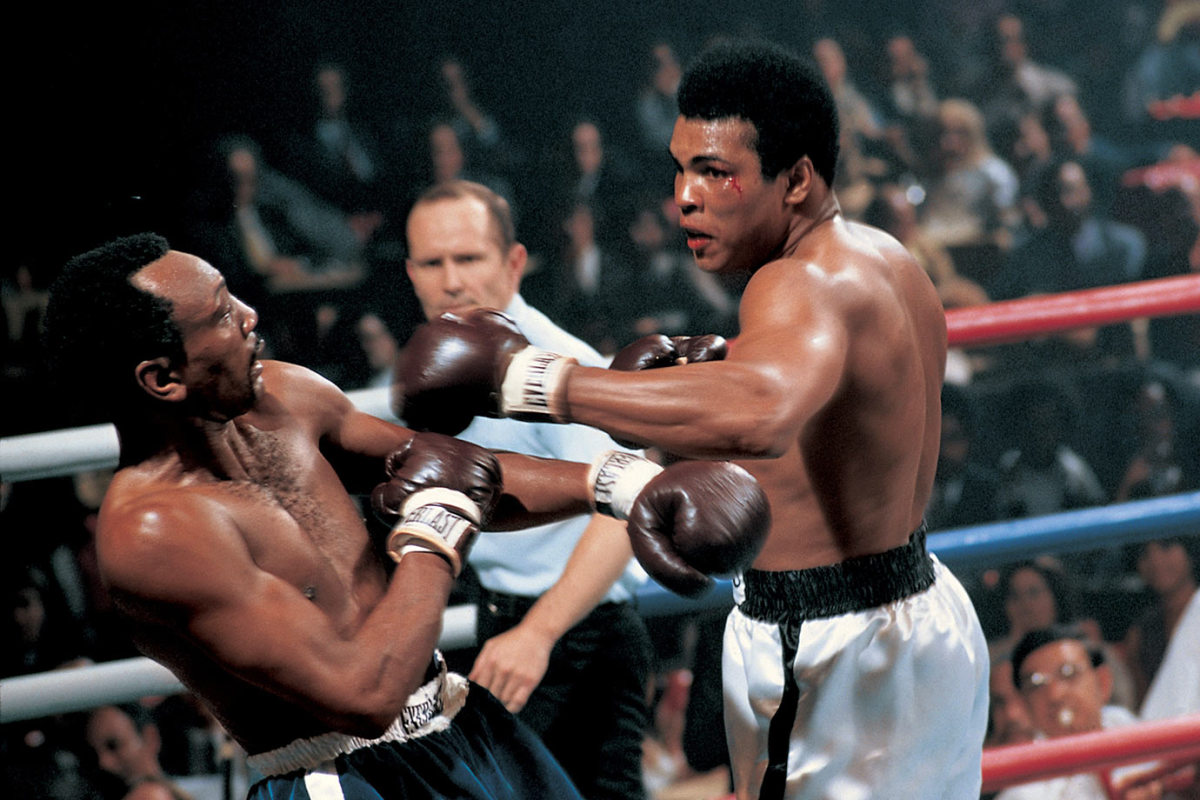
Ali throws a left hook at Bob Foster in their 1972 fight at Stateline, Nev. Although Ali knocked Foster out, Foster did leave his mark: a cut above Ali's left eye, his first as a professional.
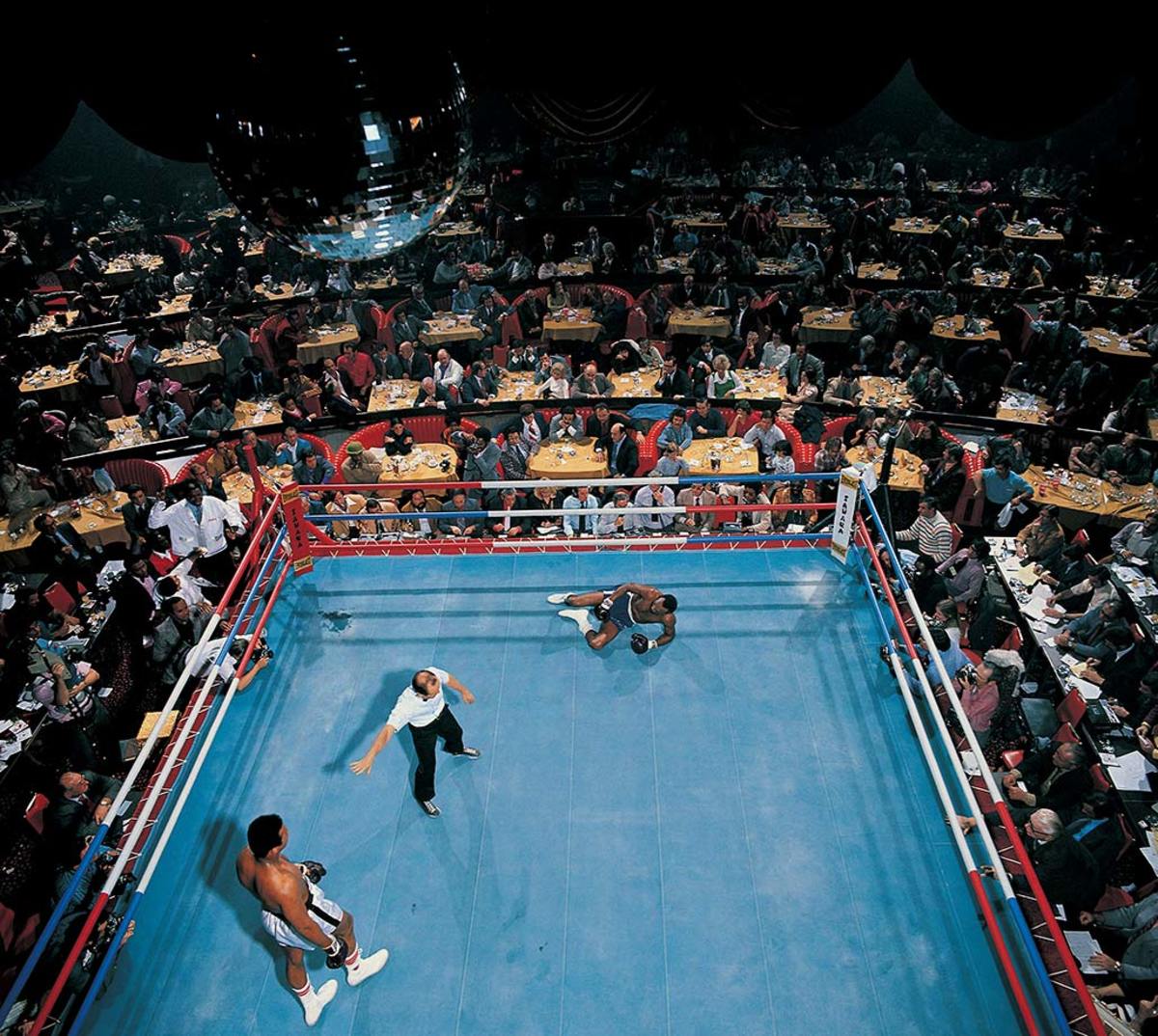
Foster lies on the canvas after getting knocked down by Ali. Ali knocked Foster down four times in the fifth round and twice more in the seventh round before he was finally counted out after Ali knocked him down again in the eighth round.
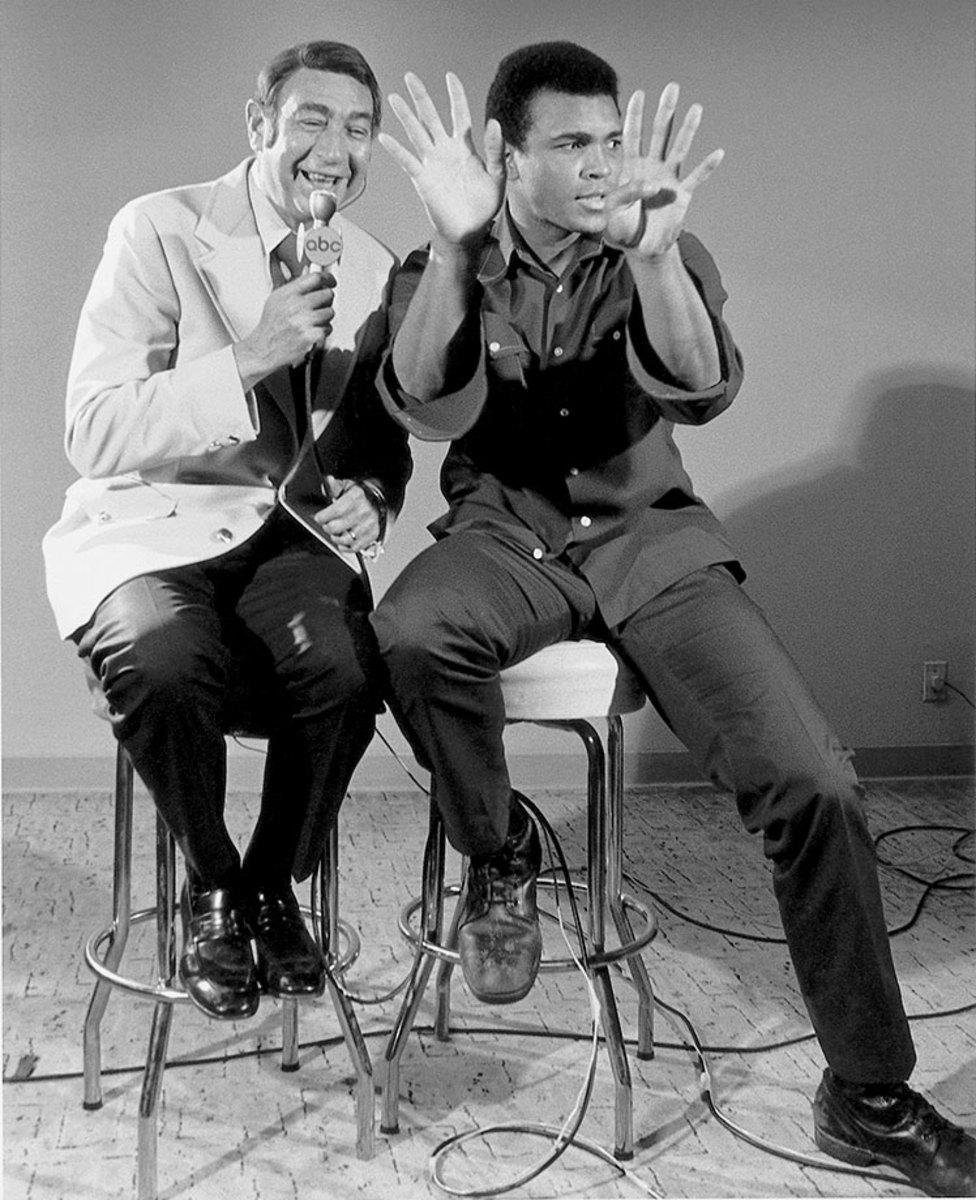
Ali sits with sportscaster Howard Cosell before his fight with Joe Bugner in February 1973. Although unable to knock Bugner out, Ali won comfortably by unanimous decision.
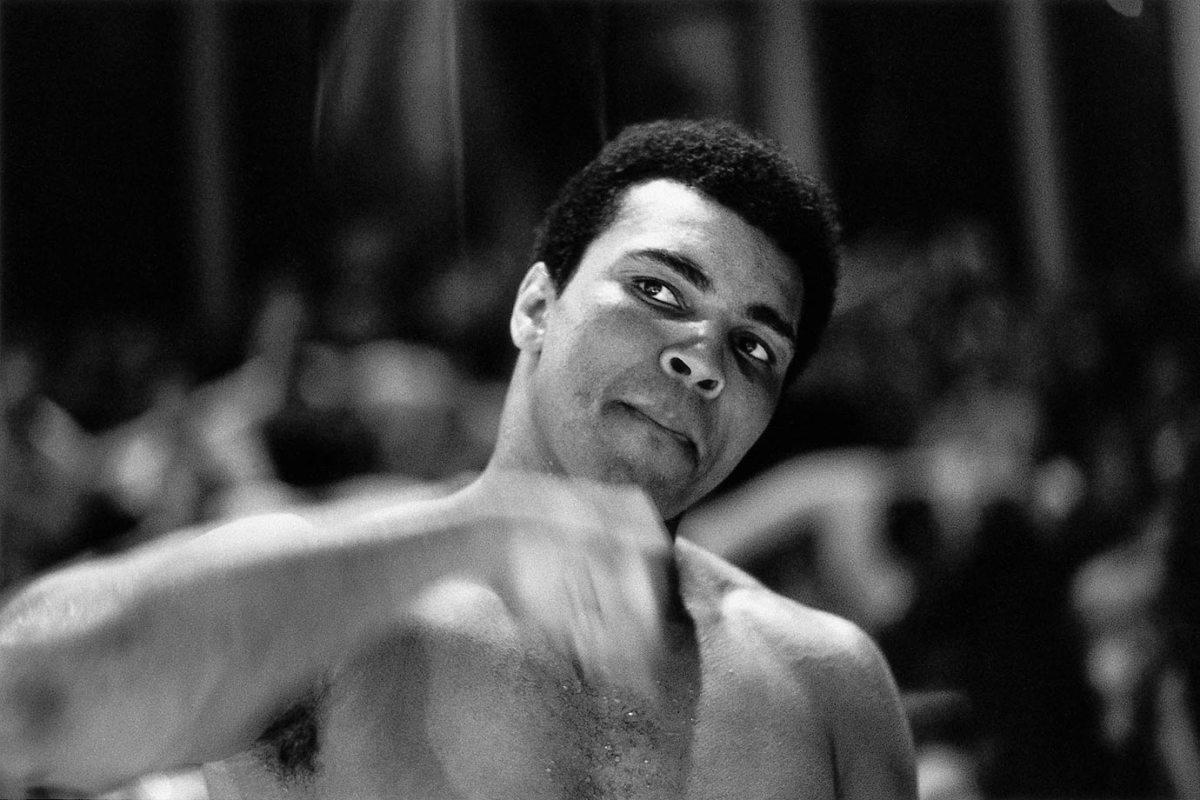
Ali hits a speed bag while warming up for his bout with Bugner in Las Vegas. Ali prepared ferociously for the fight, training 67 rounds the week leading up to the fight, including six rounds the day before the fight.
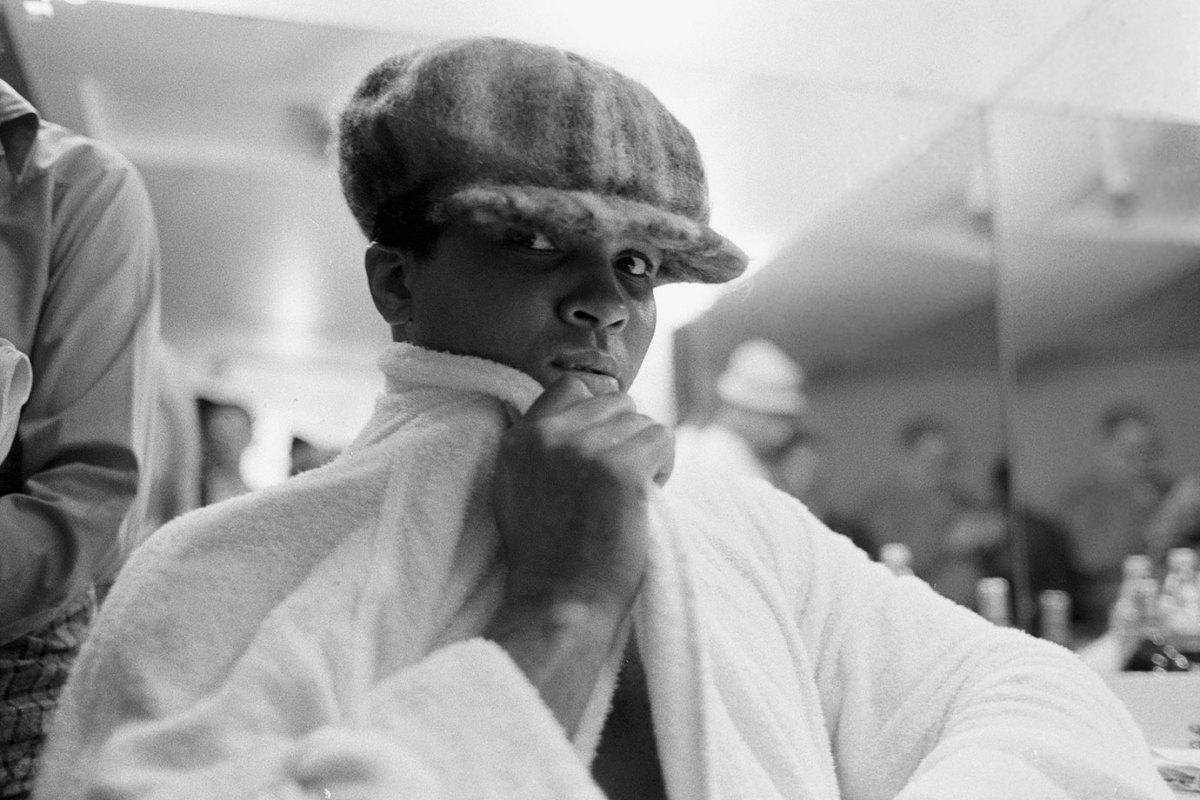
In a lighter pre-fight moment, Ali poses for a portrait wearing a hat in his dressing room before the match with Bugner.
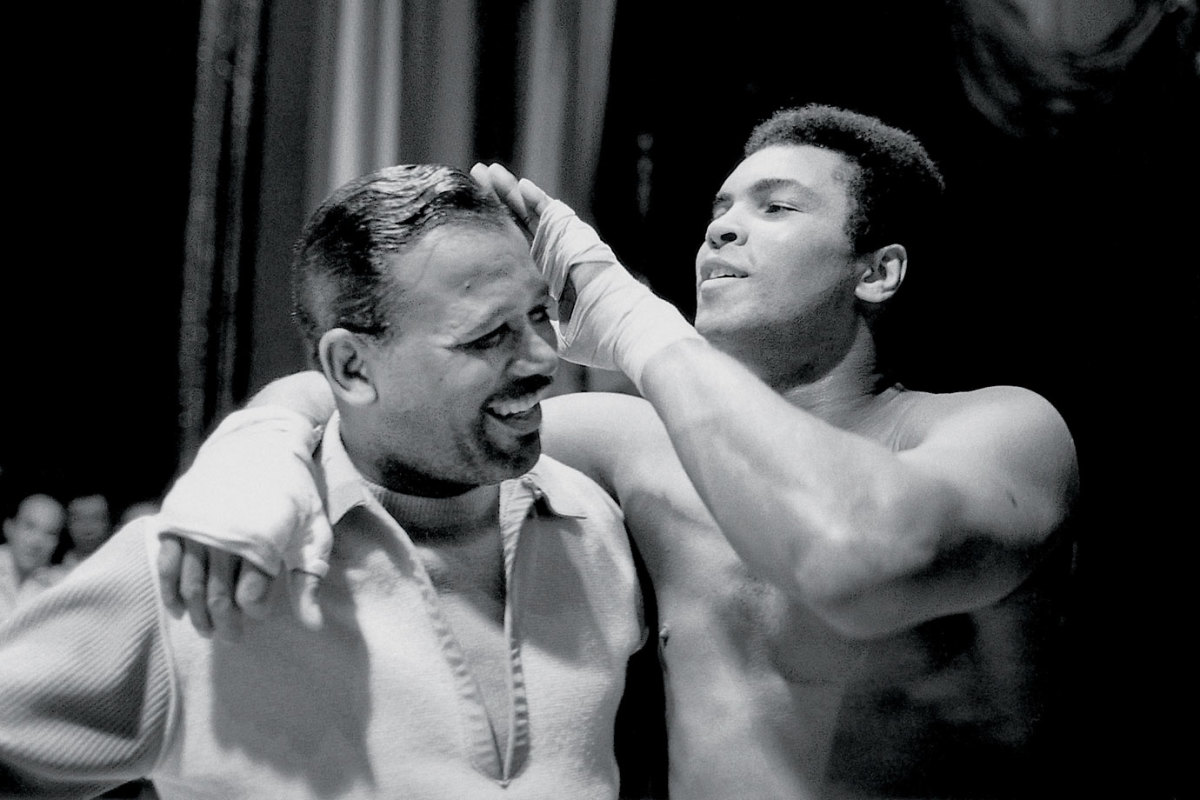
Ali plays with Sugar Ray Robinson's hair in the locker room before his bout with Bugner. The former welterweight and middleweight champion was Ali's childhood idol.
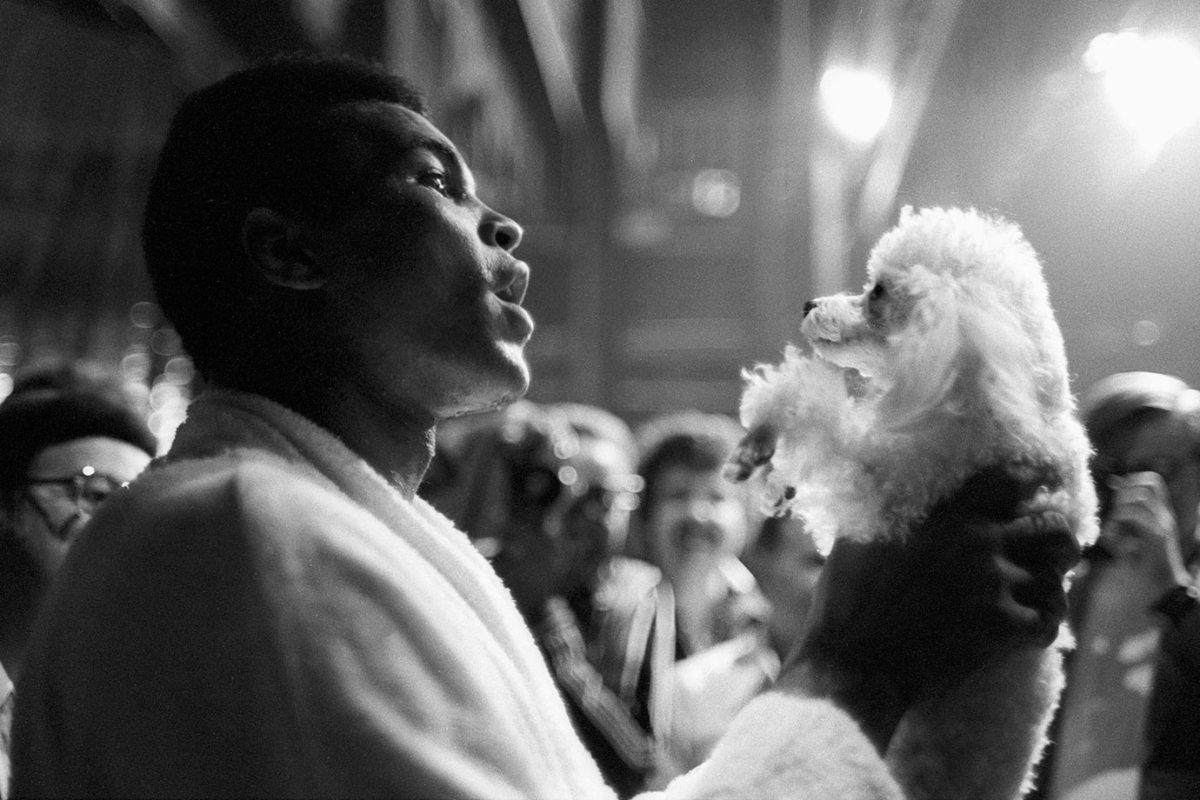
Before the fight with Bugner, Muhammad Ali enjoys a relaxed moment with a poodle at Caesars Palace Hotel. He won the fight with Bugner by unanimous decision.
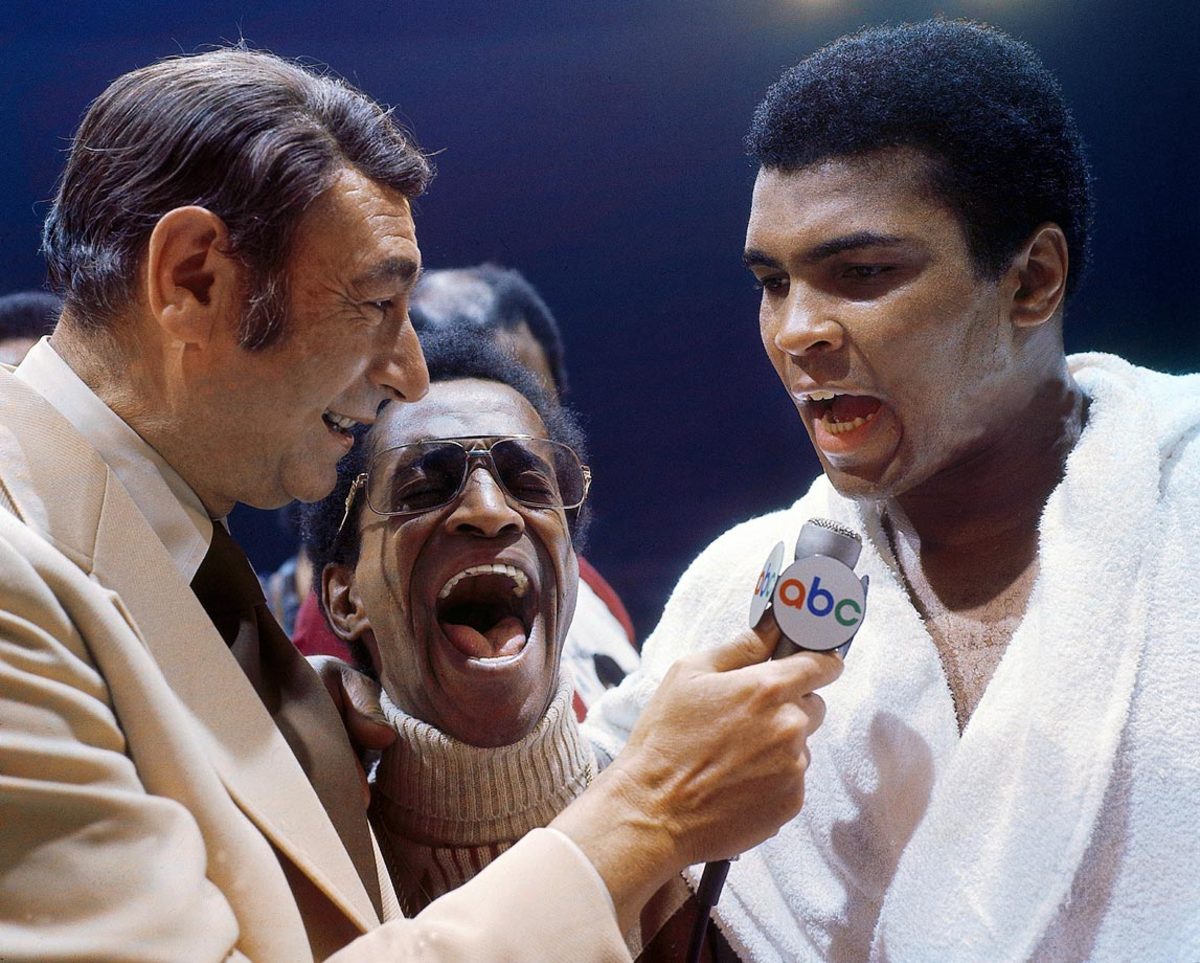
Howard Cosell interviews Ali, with entertainer Sammy Davis Jr. in the middle, after his victory over Joe Bugner by unanimous decision in. Although the fight was never in jeopardy of getting away from him, Ali praised Bugner's legs and said he could be a champion in a few years.
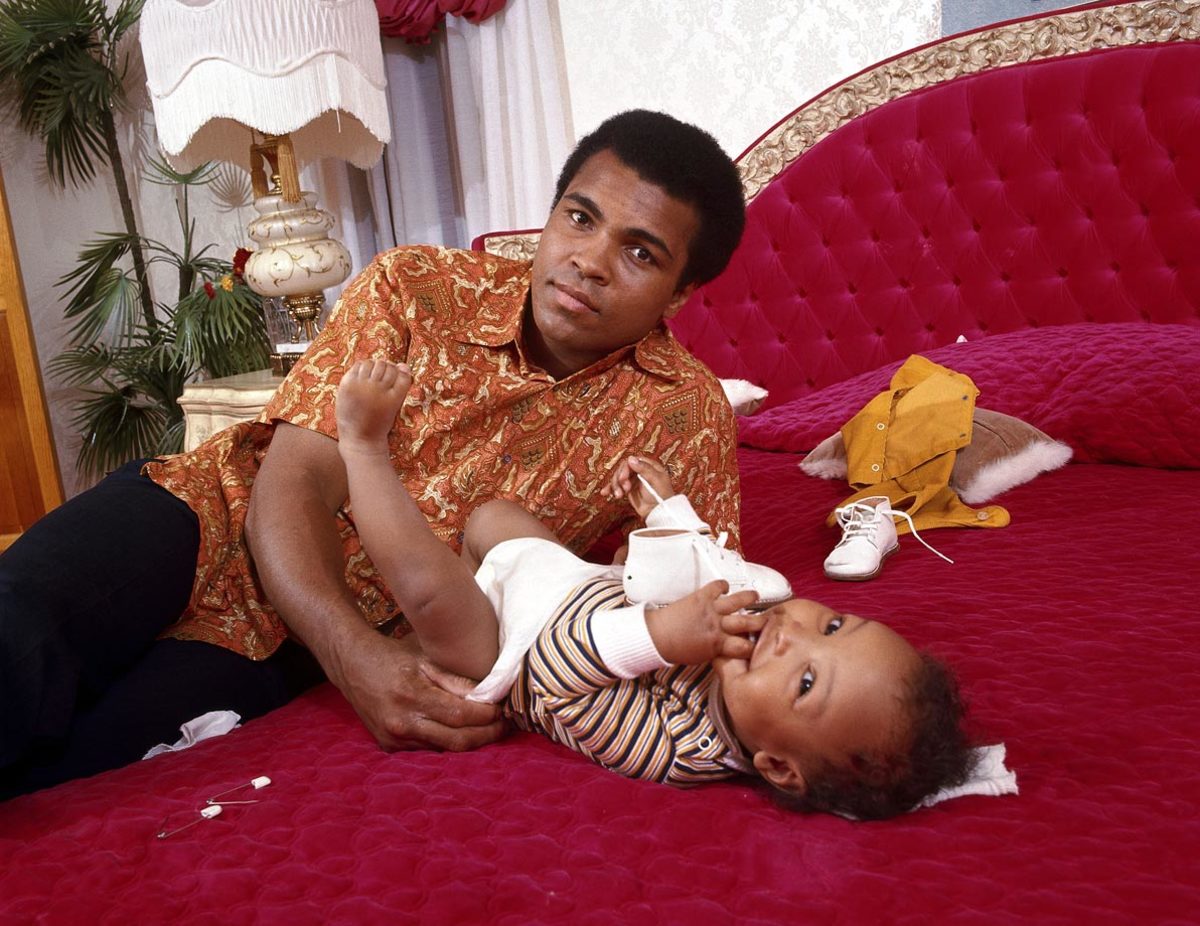
Ali changes the diaper of his son in his bedroom during a photo shoot at the family's home in April 1973. Ali had suffered a broken jaw less than a month earlier in his fight against Ken Norton.
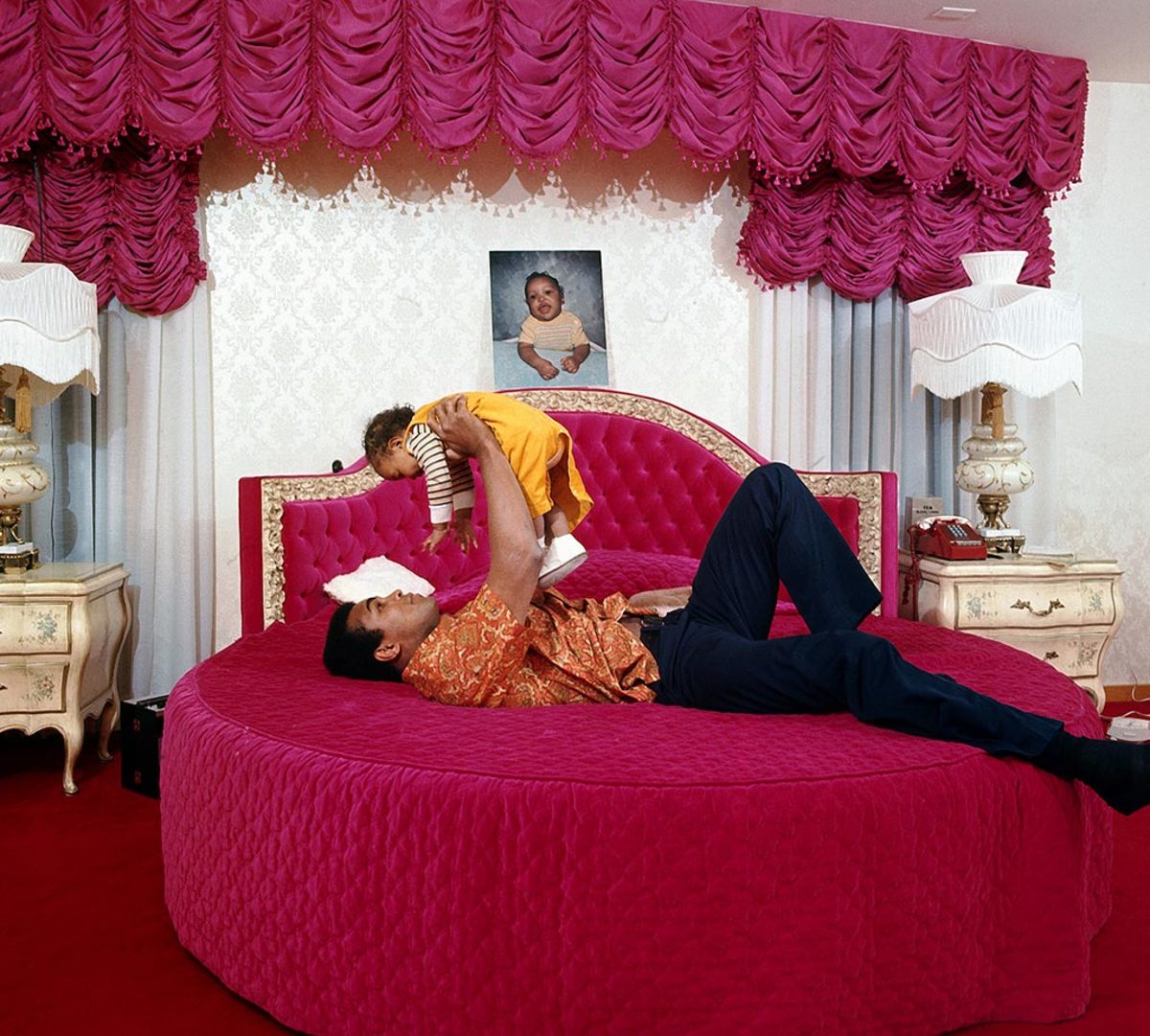
In the wake of his split decision loss to Norton, Ali plays with his son in his bedroom at home in Cherry Hill, N.J.
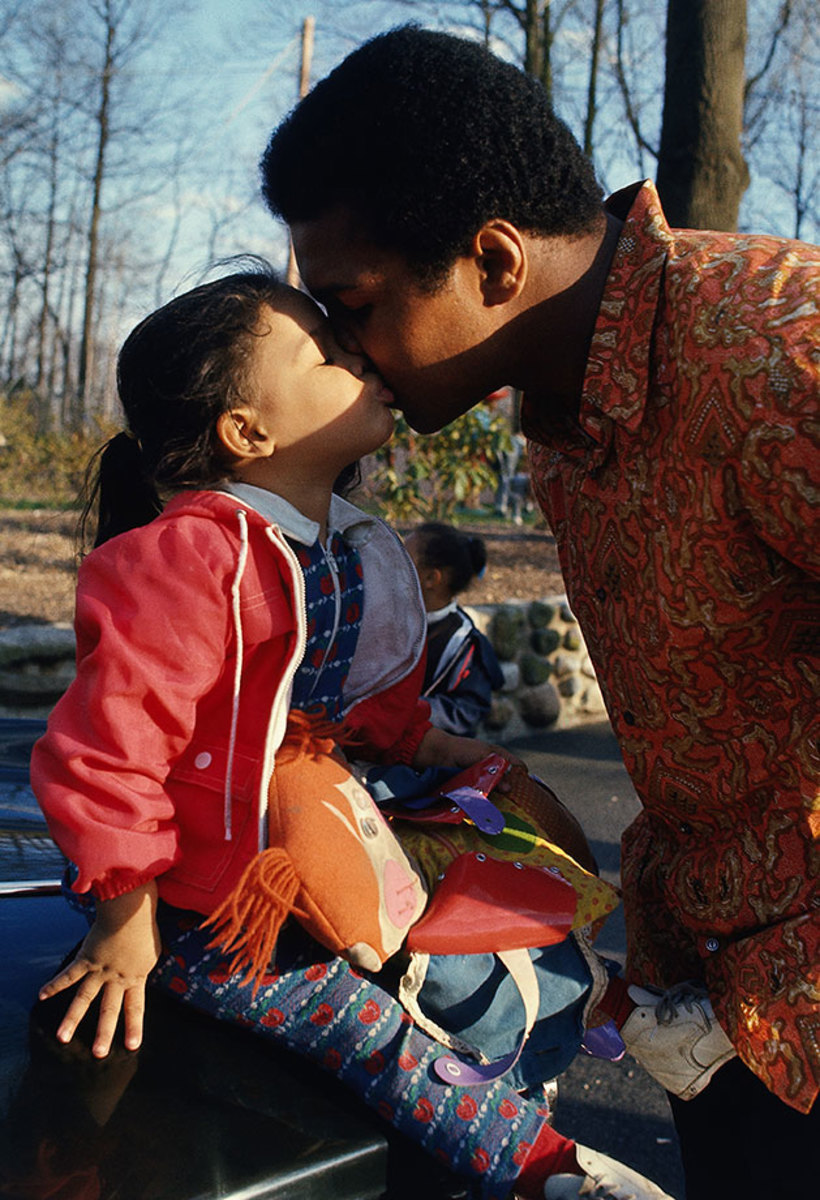
Ali kisses his daughter Jamillah outside of their home following the loss to Norton, just the second defeat of his career.
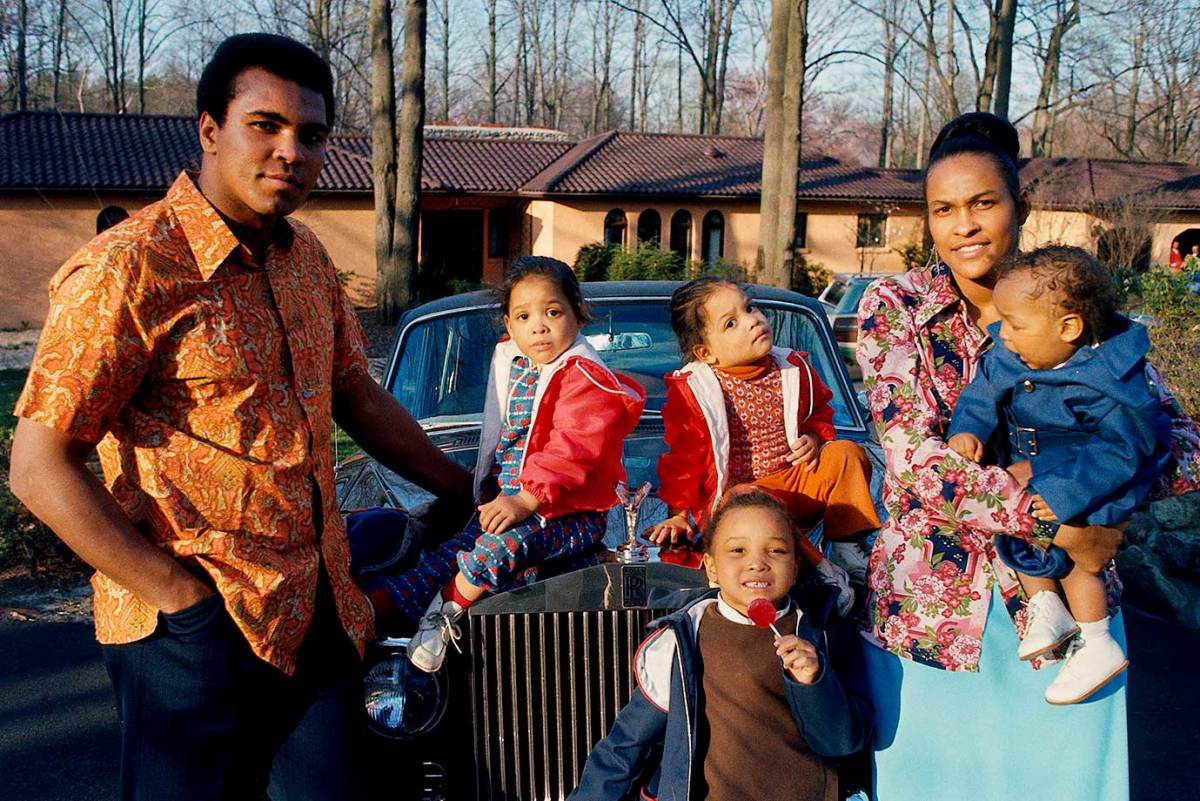
The Ali family standing outside their New Jersey home. To the right of Muhammad Ali are his twin daughters, Jamilllah and Rasheda, daughter Maryum and his wife, Khalilah, holding their son Ibn Muhammad Ali Jr.
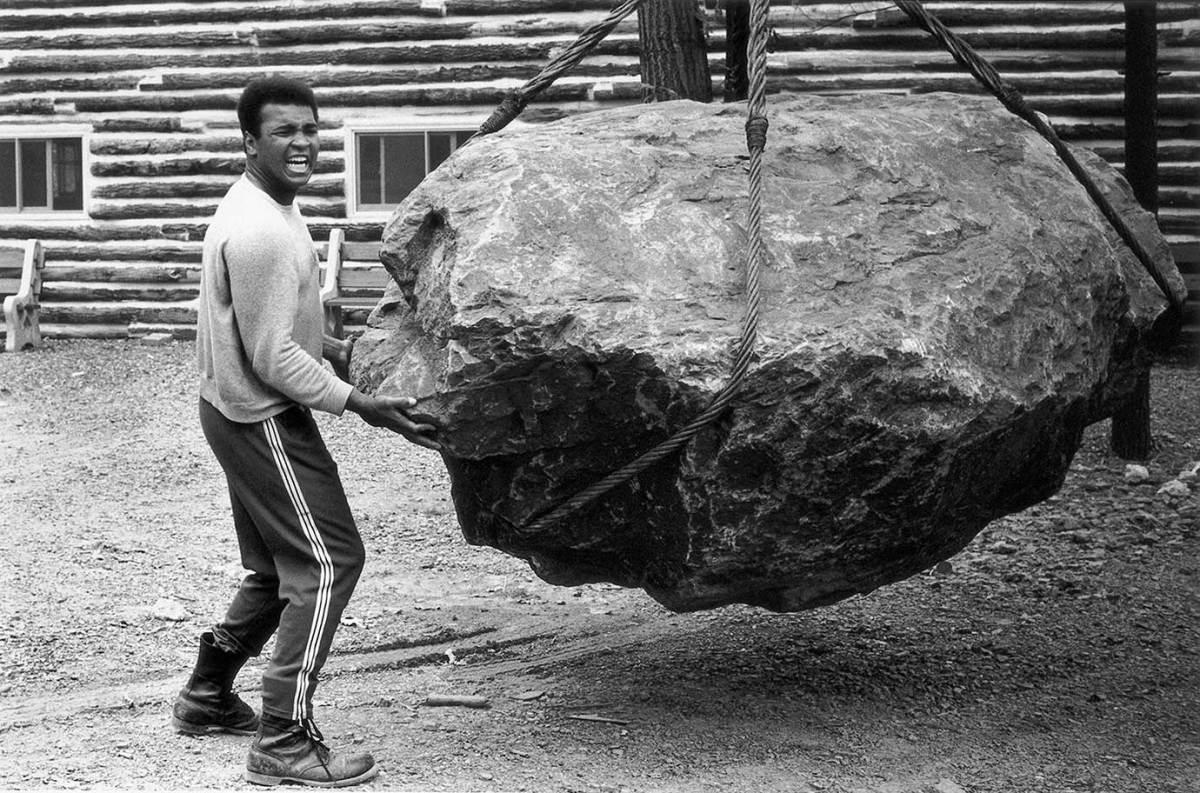
At his training camp cabin, Ali pushes a boulder during a photo shoot in Deer Lake, Penn., in August 1973. Ali was training for his rematch against Ken Norton, who broke his jaw five months earlier.
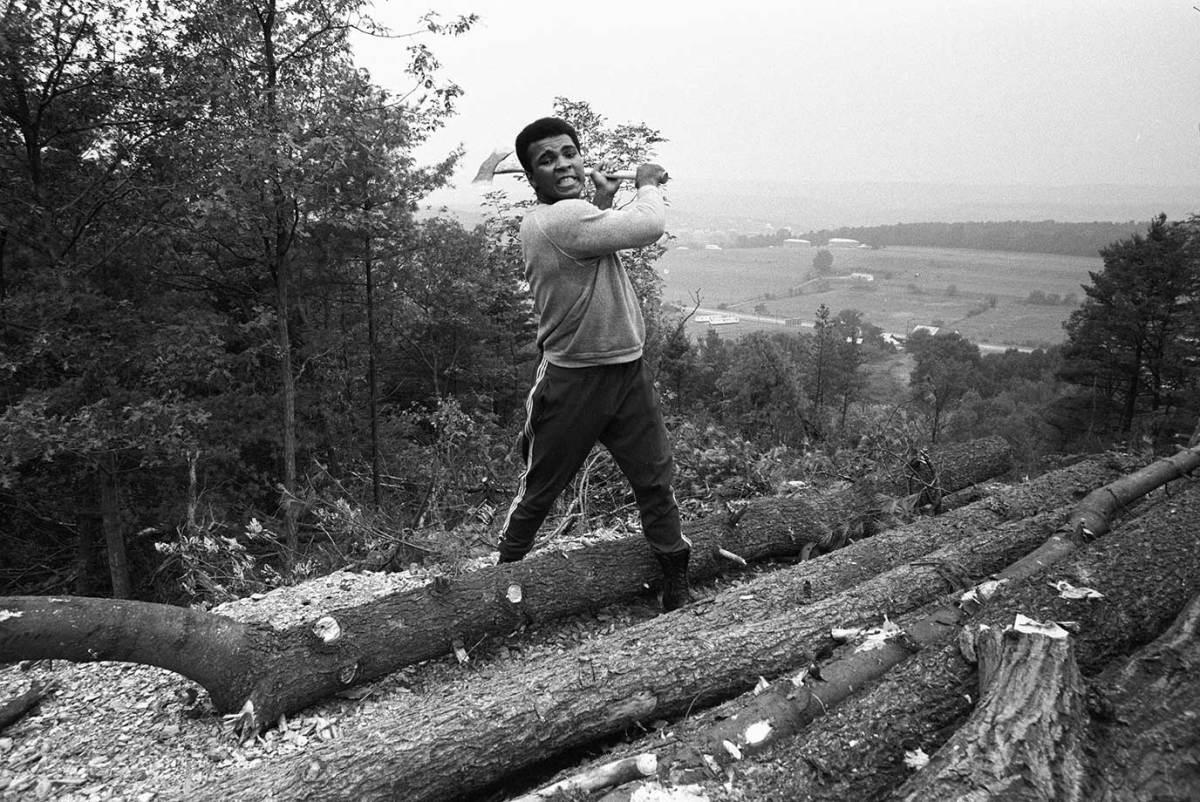
Ali chops wood at his cabin in Deer Lake. He referred to the training camp as "fighter's heaven" and used it to prepare for fights away from the spotlight.
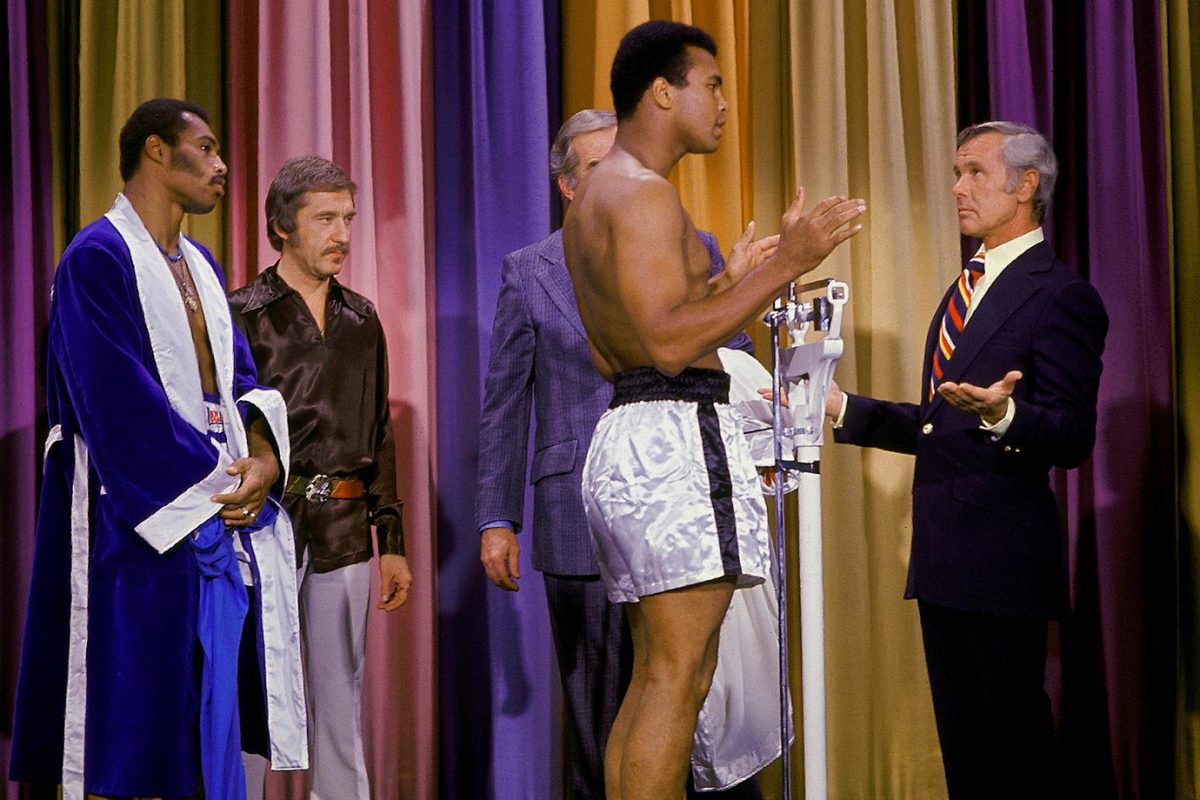
The fighters weigh in on the Tonight Show with Johnny Carson ahead of Ali and Ken Norton's September 1973 fight.
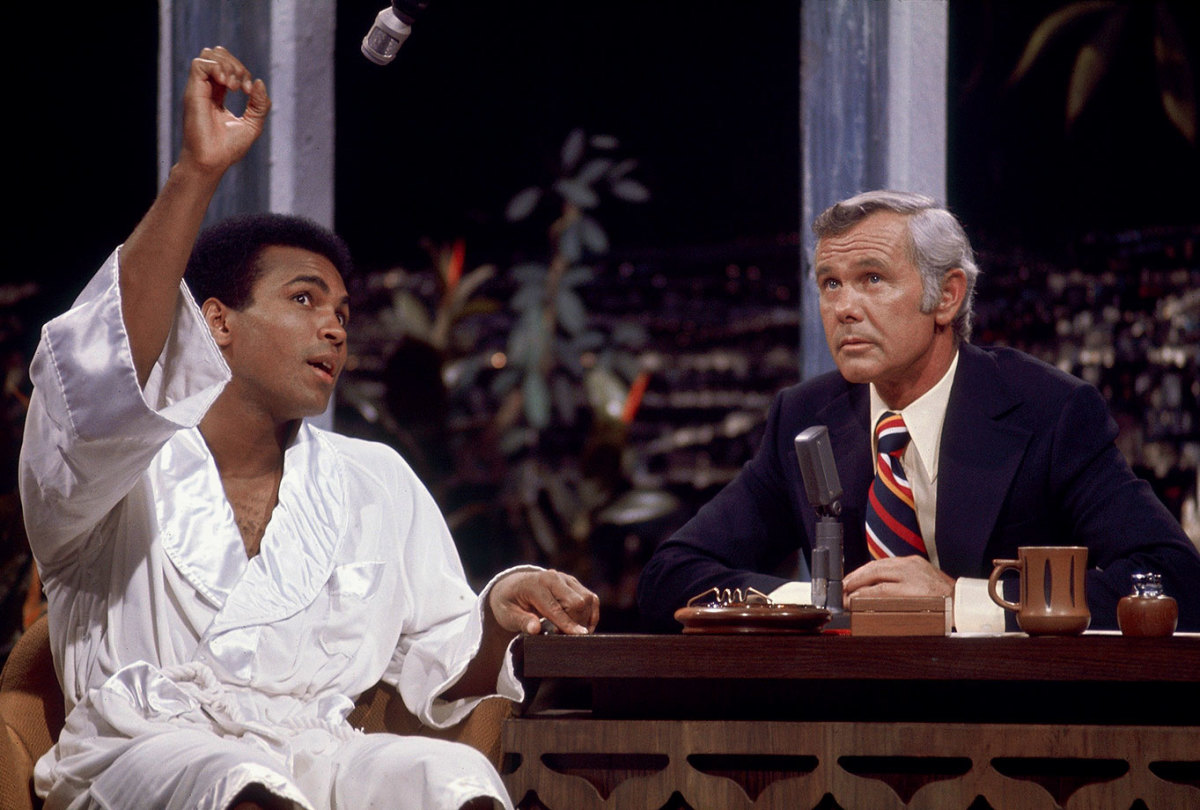
Johnny Carson listens to Ali on the Tonight Show three days before his rematch with Norton. Ali would avenge his earlier loss to Norton, winning a narrow split decision.
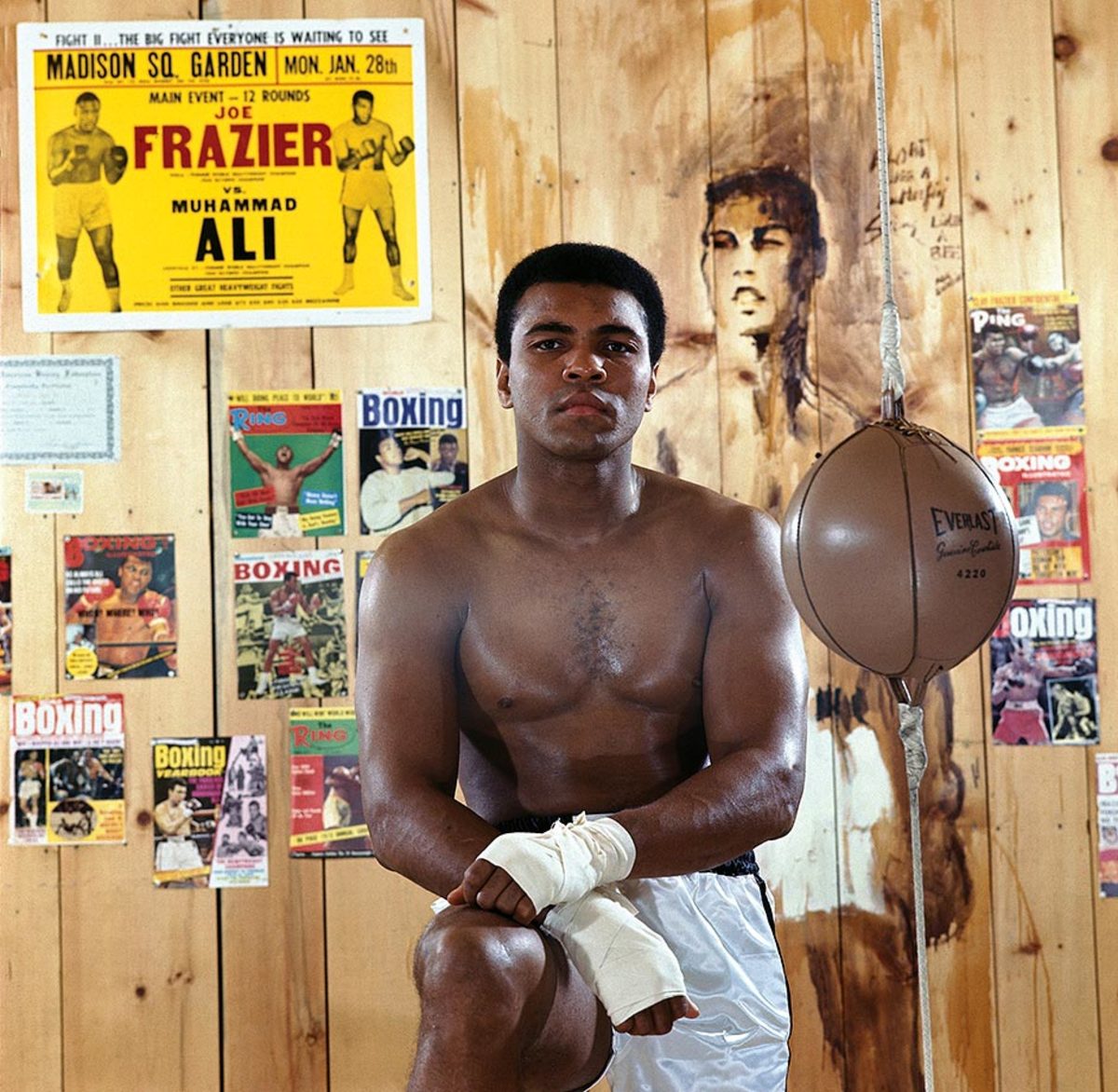
Ali poses in front of posters and magazine covers from throughout his career at his training camp cabin in Deer Lake in 1974.
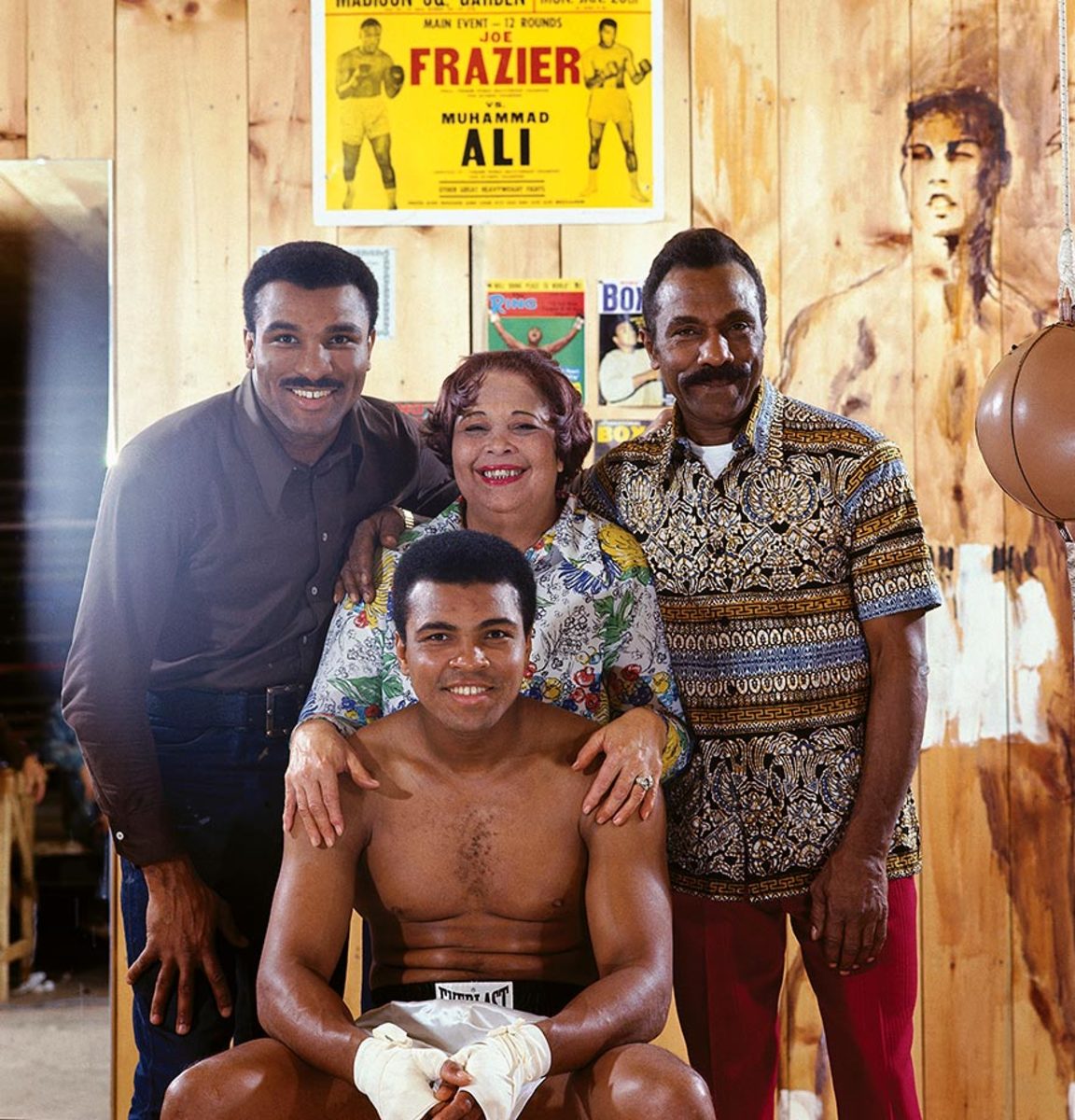
Ali poses with members of his family in front of a poster from his first fight with Joe Frazier. Ali's brother, Rahman Ali; mother, Odessa Clay; and father, Cassius Clay Sr. stand behind the boxer.
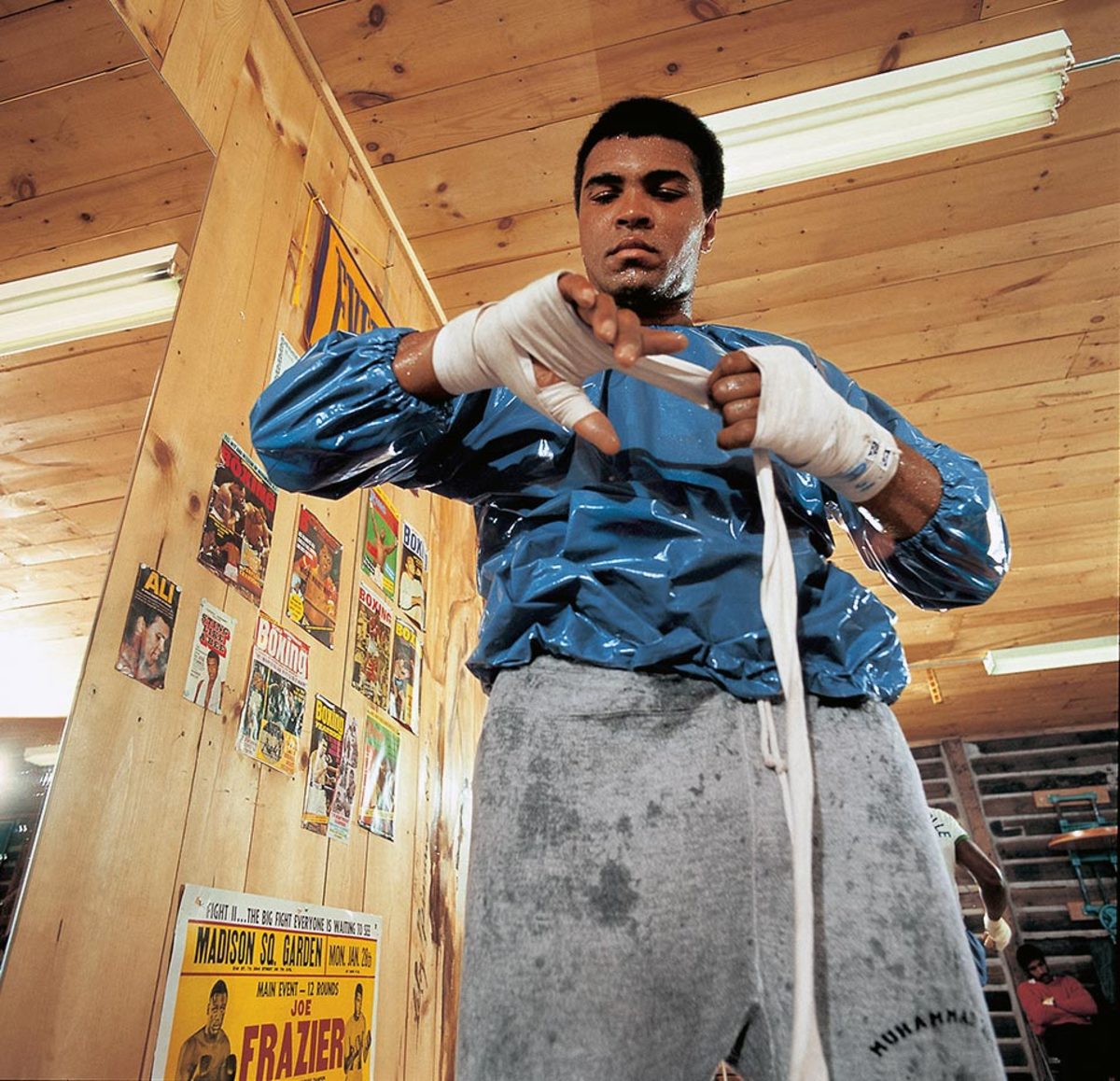
Less than three weeks before his rematch with Joe Frazier on Jan. 28, 1974, Ali wraps his hands while wearing a sauna suit at his training camp cabin.
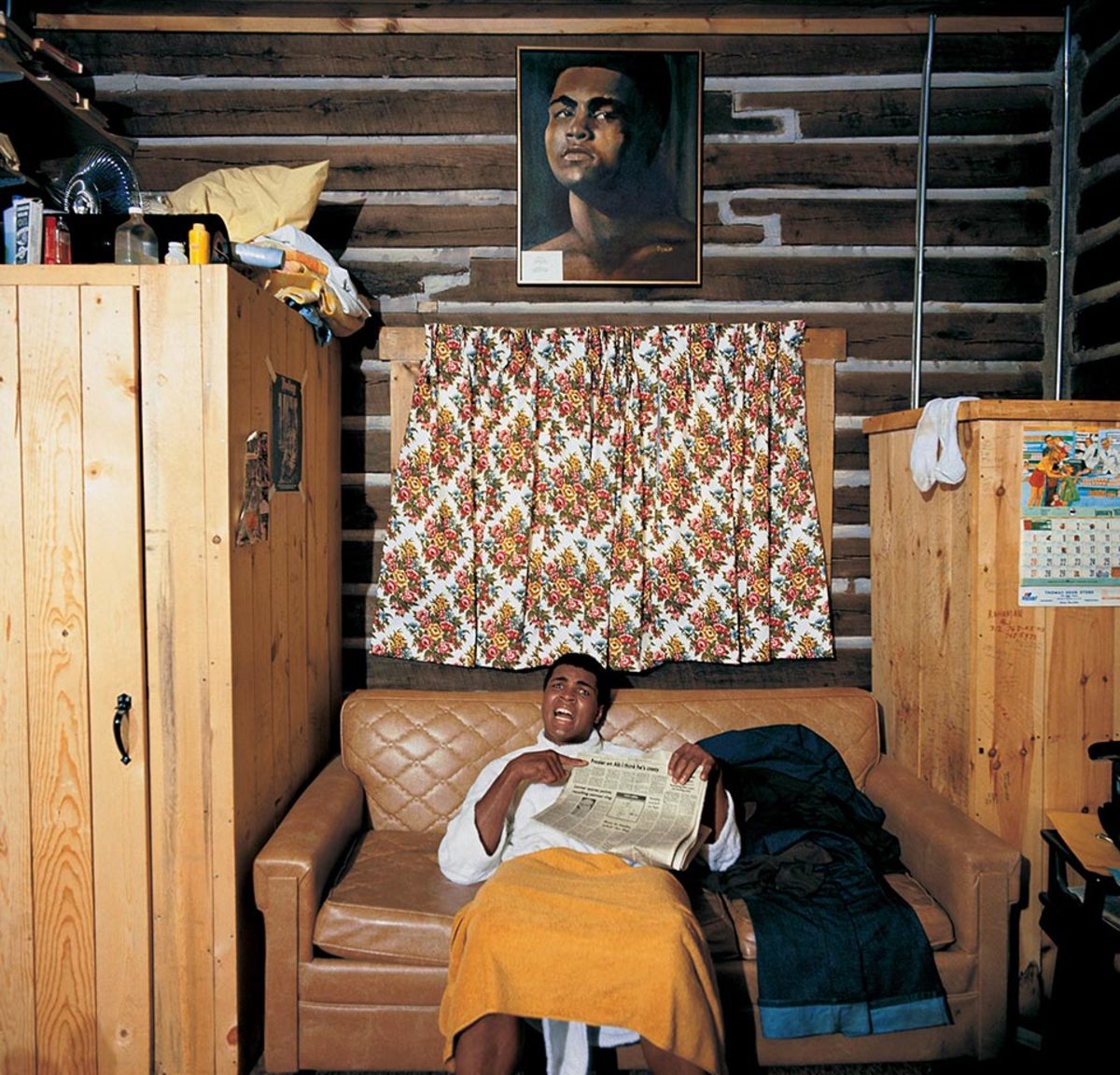
Ali holds a newspaper at his cabin in January 1974. He is pointing to a headline that reads, "Frazier On Ali, I Think He's Crazy." Ali and Frazier fought for the second time later that month with Ali winning by a unanimous decision.
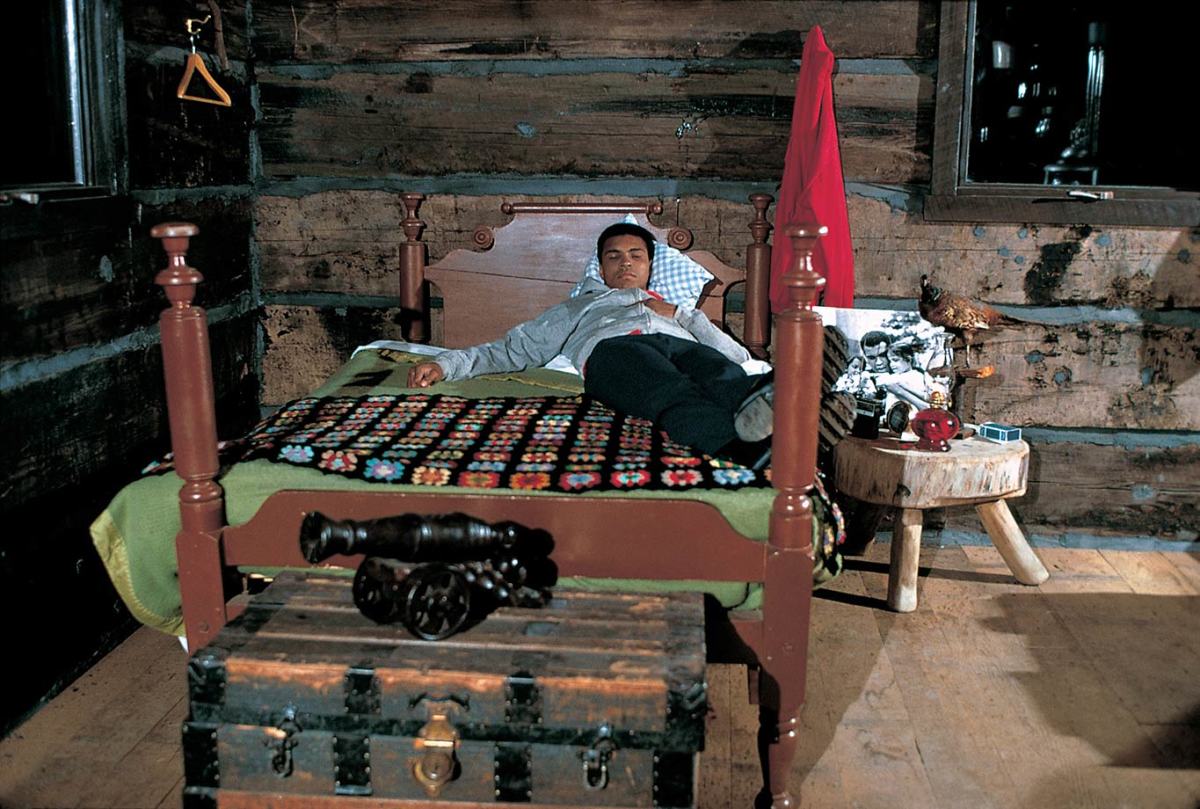
Ali lies on his bed at his cabin during the January 1974 photo shoot.
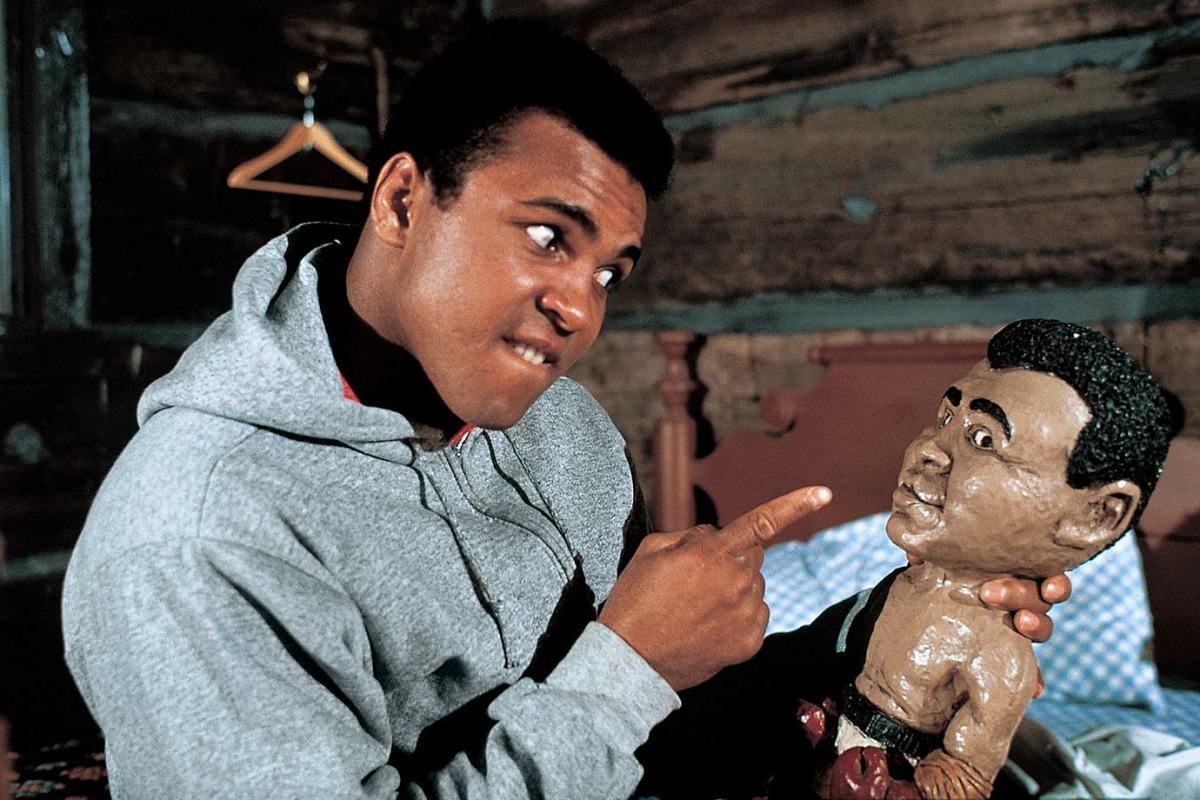
His smaller incarnation stares straight back as Ali plays with a doll of himself during the same 1974 shoot at his training camp cabin.
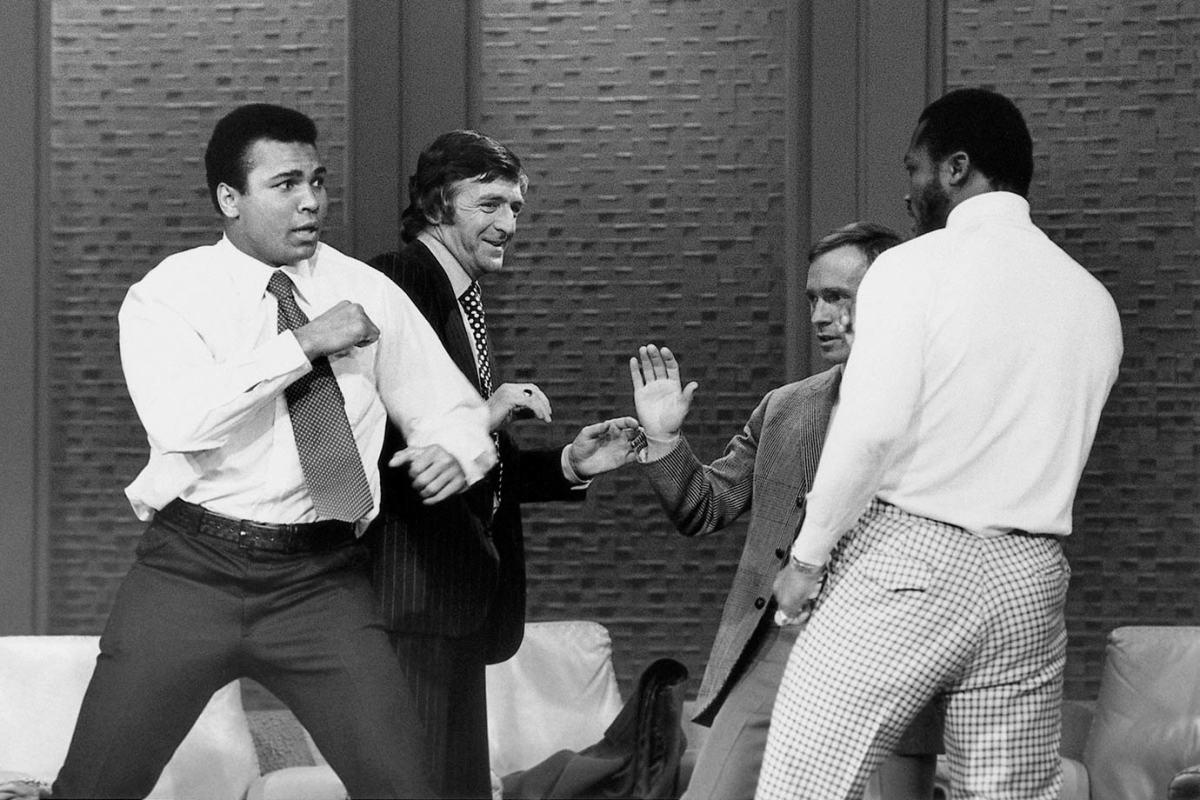
Ali and Joe Frazier fight on the set of The Dick Cavett Show while reviewing their 1971 bout in advance of their 1974 rematch. Ali called Frazier ignorant, to which Frazier took exception. As the studio crew tried to calm Frazier down, Ali held Frazier by the neck, forcing him to sit down and sparking a fight. The television set fight amped up anticipation of their January 1974 bout.
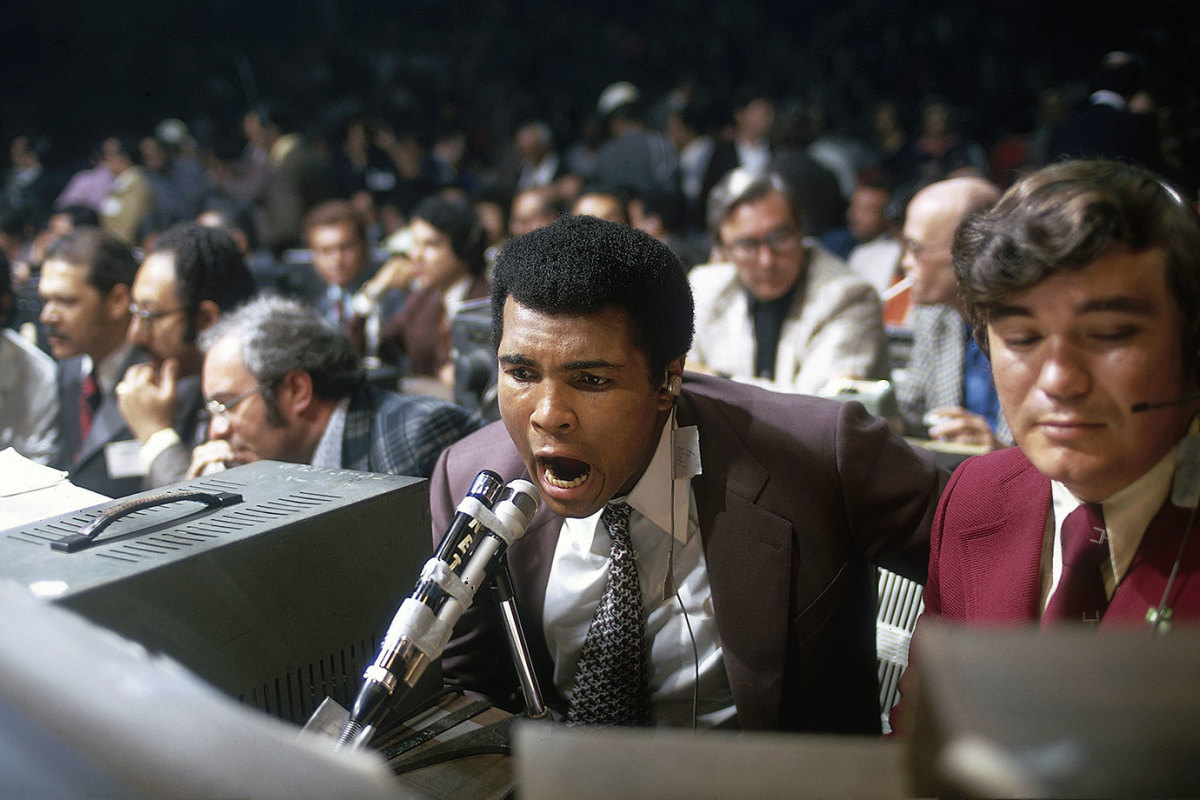
Exploring a different side of the sport, Ali broadcasts the fight between George Foreman and Ken Norton in March 1974. Foreman won the fight by technical knockout in the second round, setting up the showdown with Ali in Zaire.
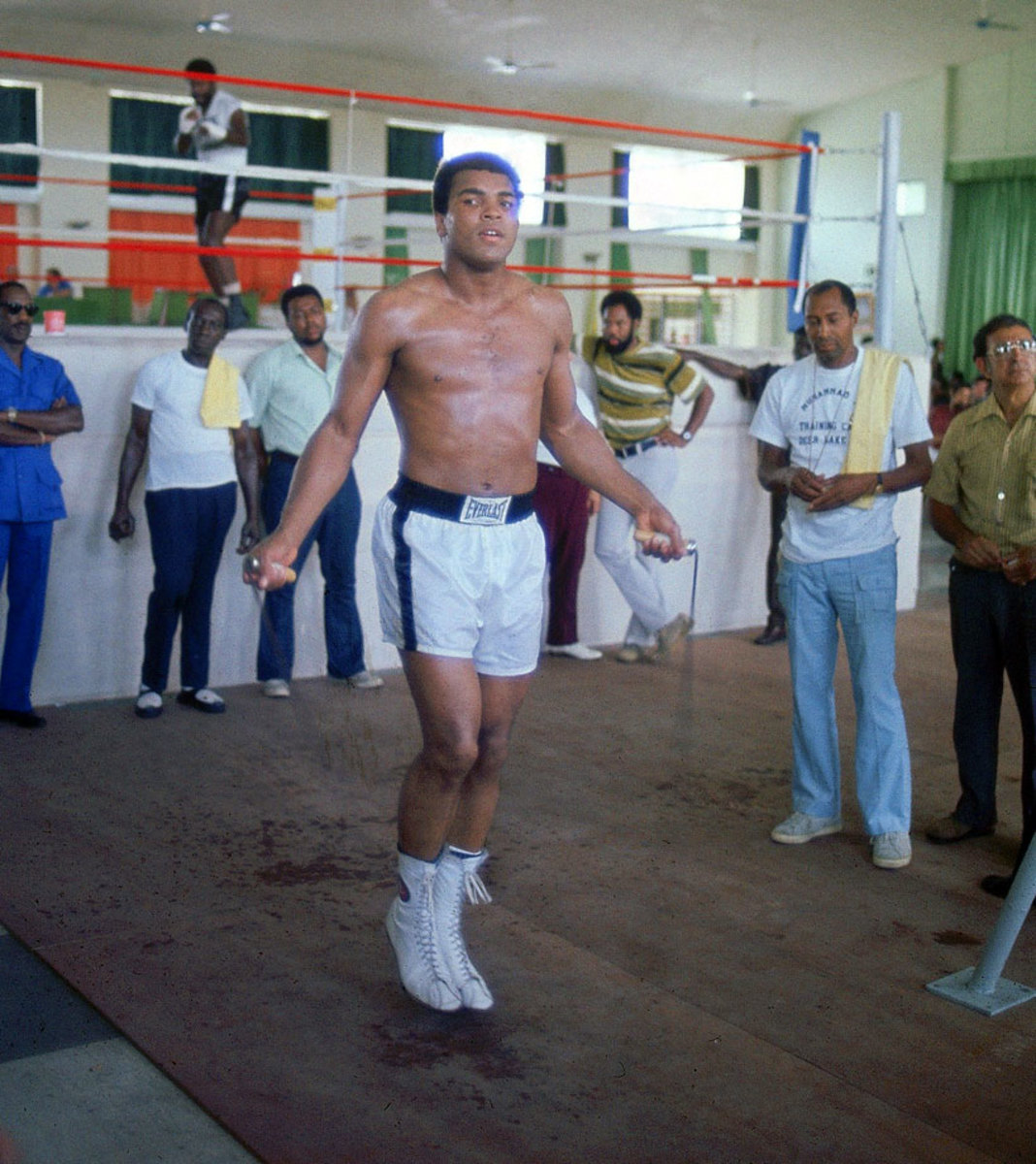
Ali jumps rope at the Salle de Congres in Kinshasa, Zaire, while training for his heavyweight title fight against George Foreman. Both Ali and Foreman spent most of the summer of 1974 training in Zaire to adjust to the climate.
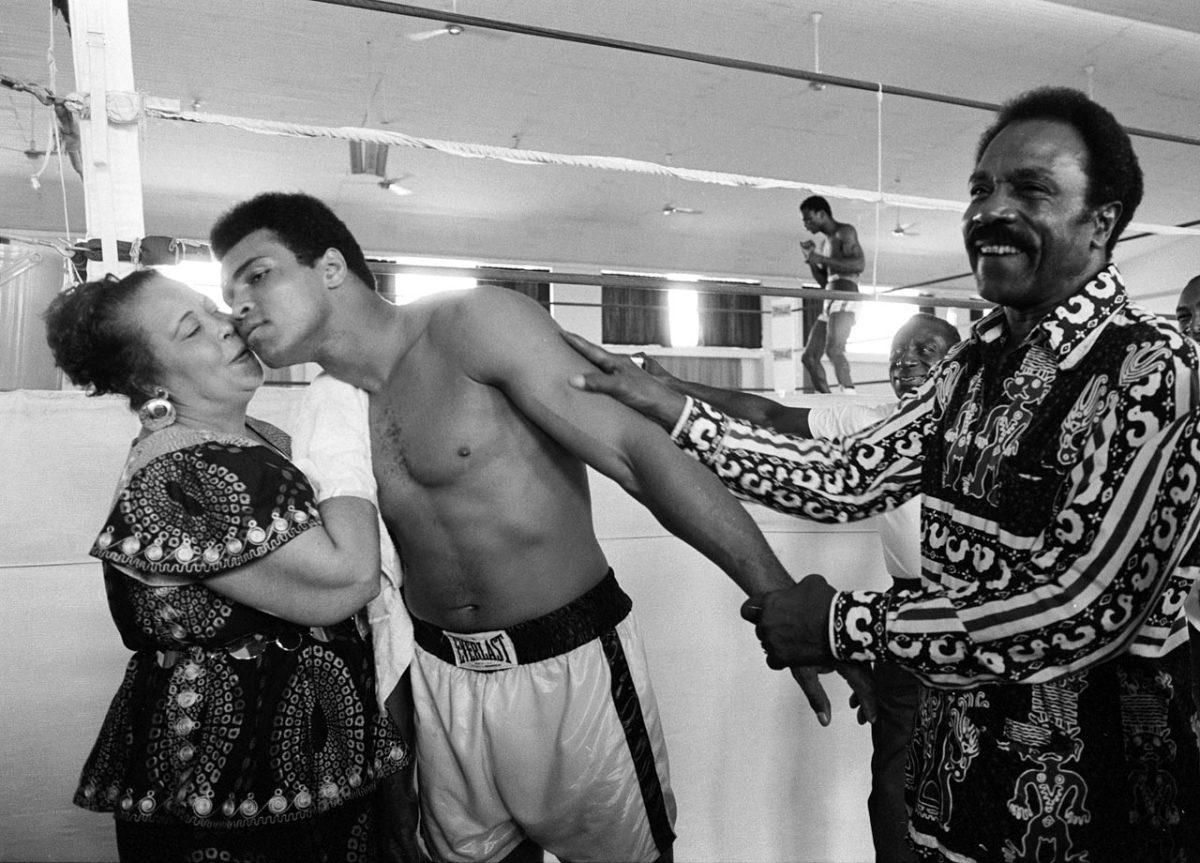
While training before his fight with George Foreman, Ali kisses his mother, Odessa Clay, while his father, Cassius Clay Sr., looks on. Ali's superior strategy and ability to take a punch led him to his upset victory as he absorbed body blows from Foreman before he responded with powerful combinations to Foreman's head.
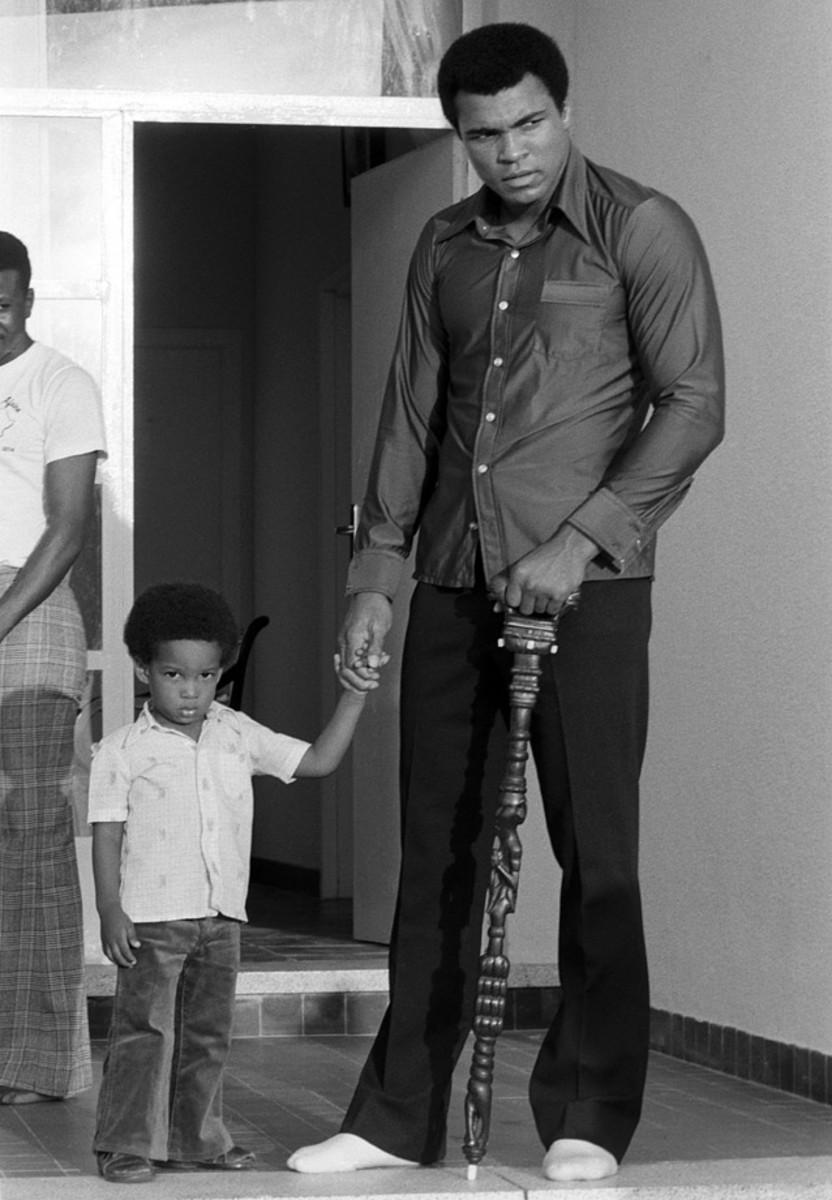
Four days before the fight, Ali holds the hand of his son Ibn in Zaire. Ali successfully courted the favor of the Zaire crowd, prompting chants of "Ali bomaye!" — translated as "Ali, kill him!"
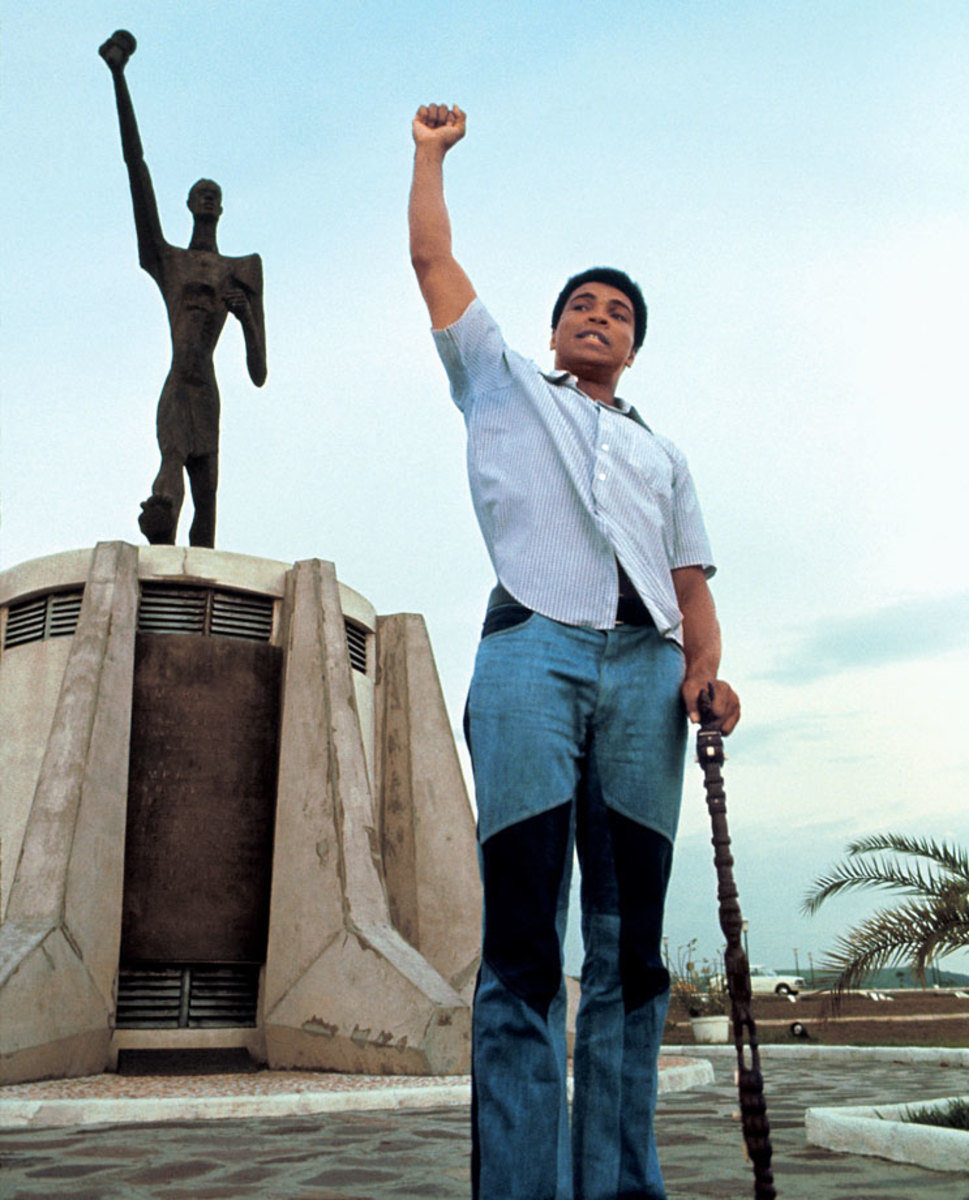
Ali poses in front of the Le Militant statue at the presidential complex that was the site of Ali's January heavyweight title bout with Foreman. The fight was originally set for a month earlier, but Foreman suffered a cut near his eye during training, forcing a delay.
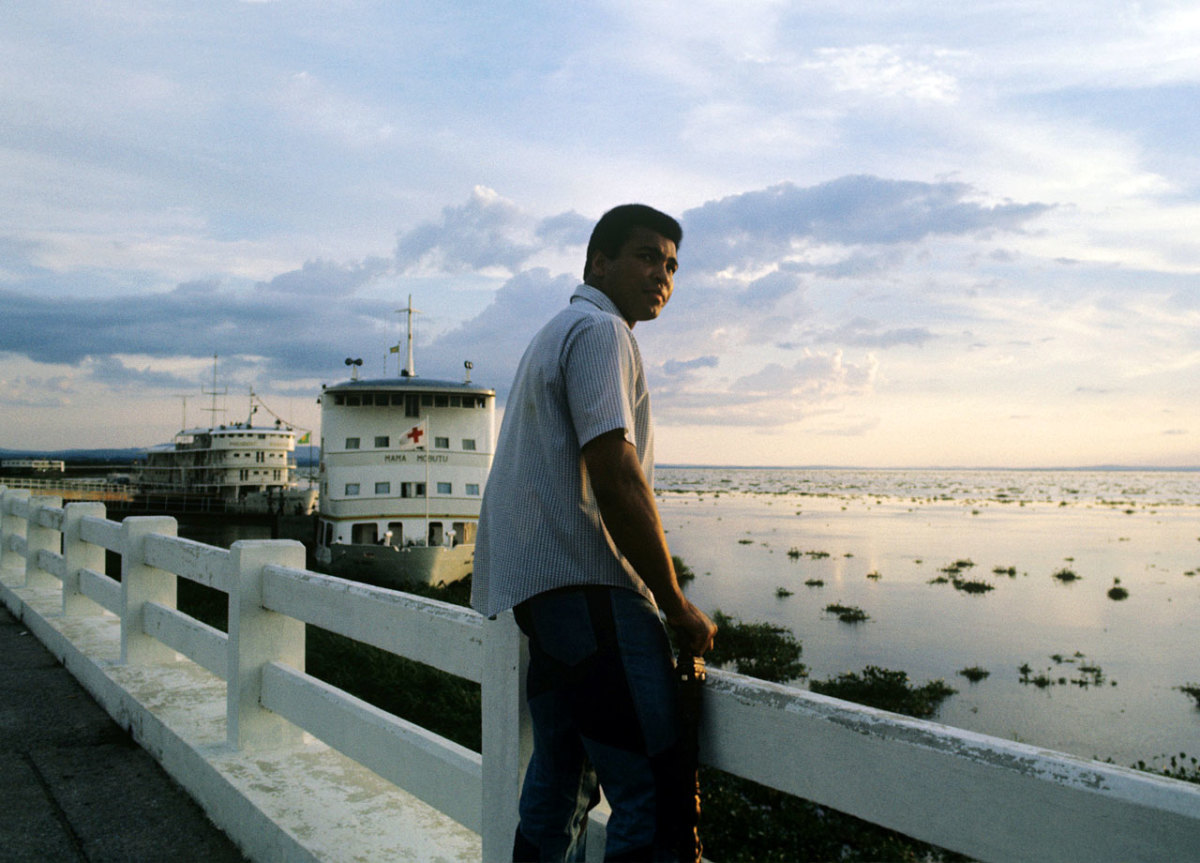
Ali stands against the railing on the River Zaire watching the sunset four days before the Rumble in the Jungle. The fight was sponsored by Zaire to achieve the $5 million purse promoter Don King had promised both Ali and Foreman.
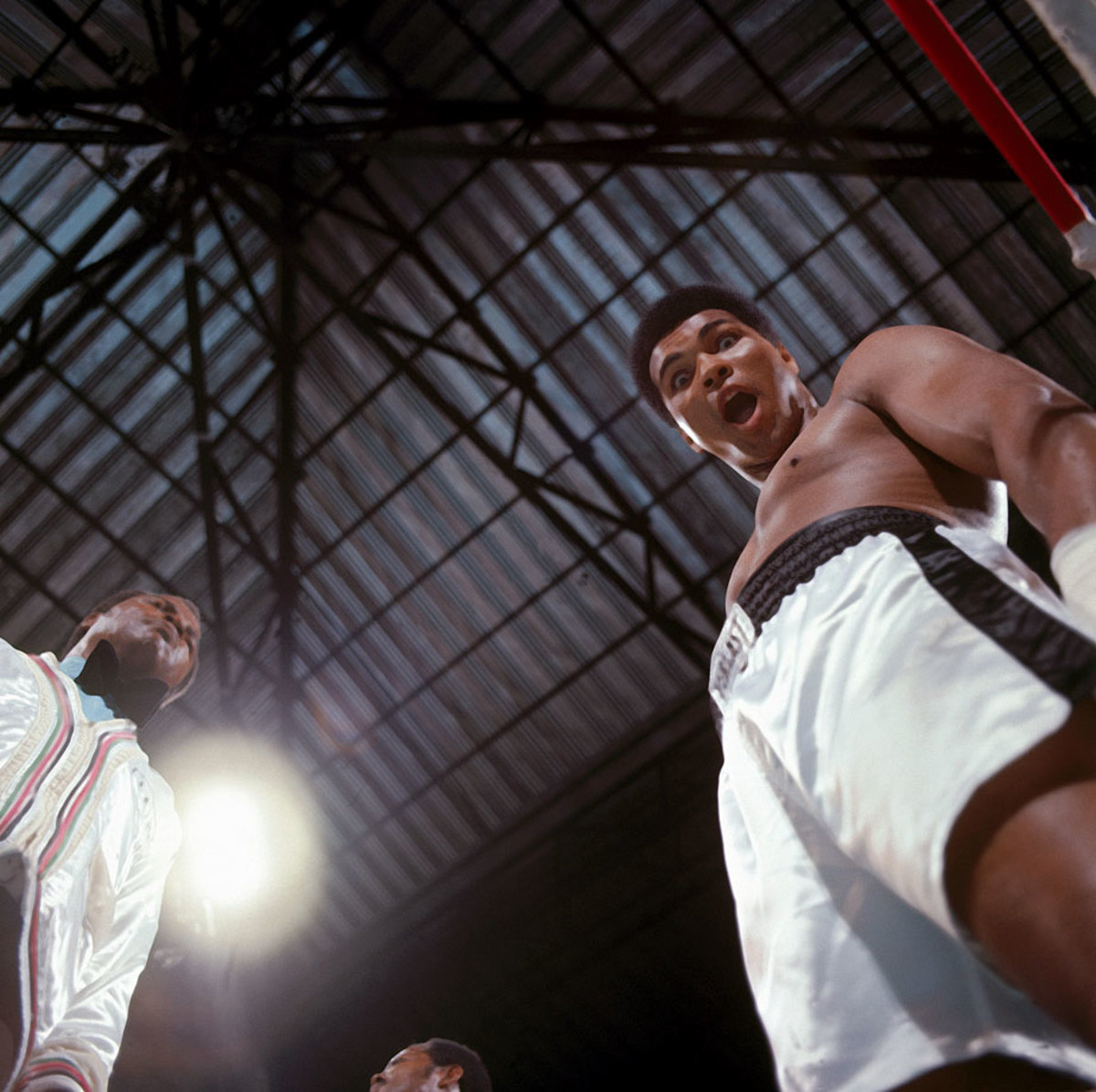
Before employing his famous rope-a-dope strategy against Foreman, Ali makes a face at the camera. Ali allowed Foreman to throw many punches but only into his arms and body, and when Foreman tired himself out from the mostly ineffective punches, Ali took control of the fight.
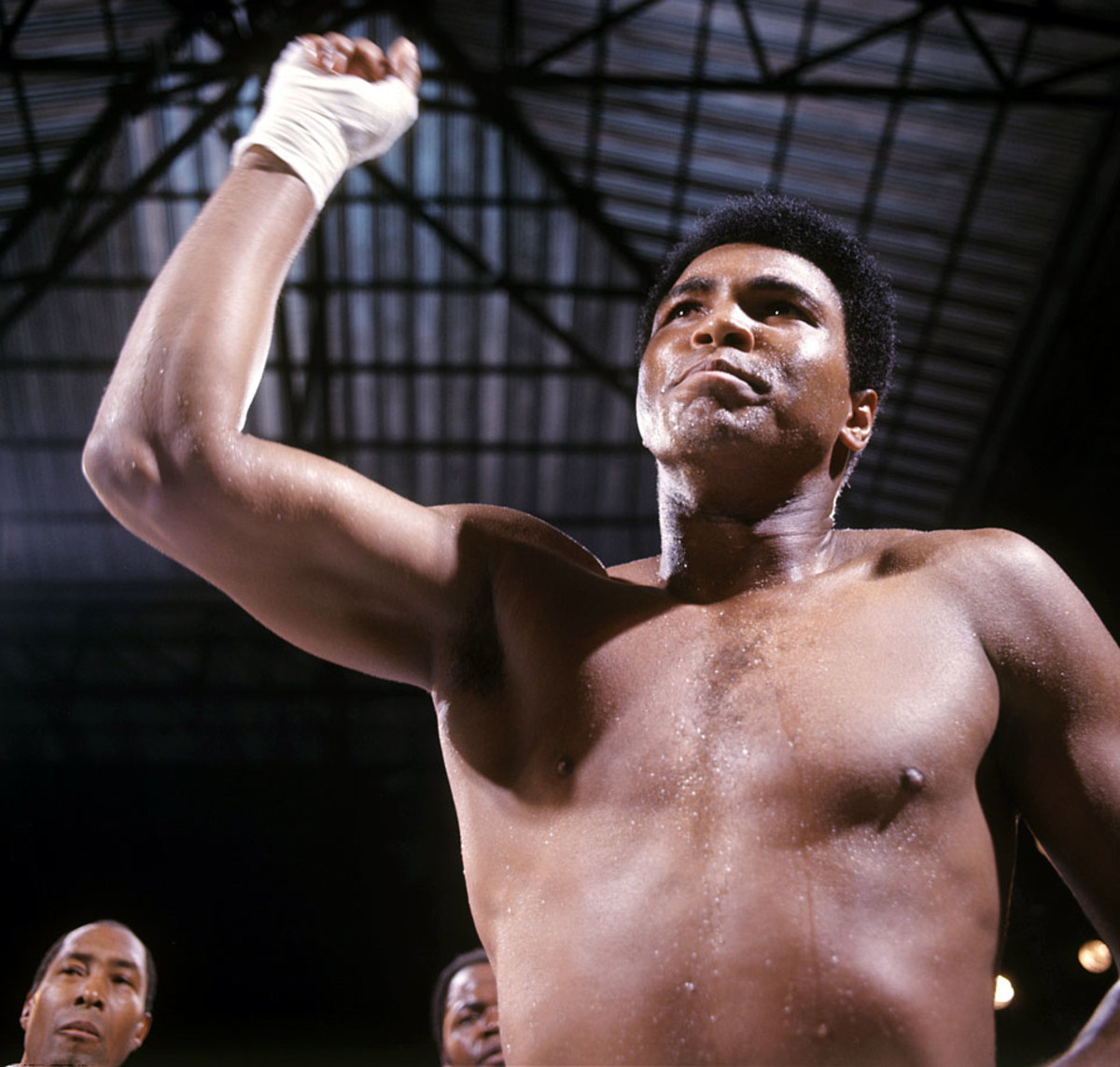
Ali points before his bout with Foreman. The victory over his favored opponent made him the heavyweight champion of the world for the first time since he was stripped of his titles in 1967.
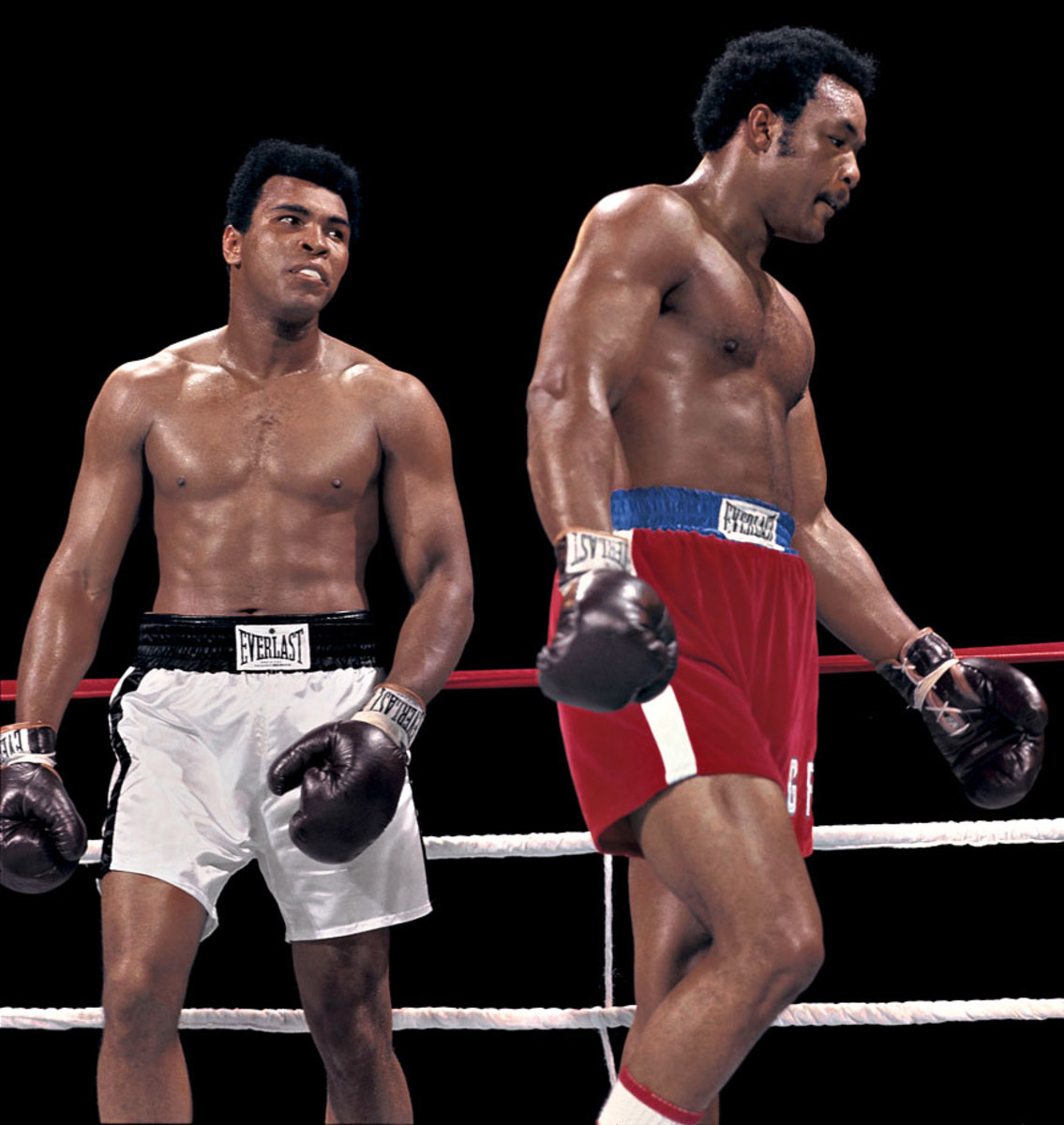
Ali stares at George Foreman during the Rumble in the Jungle. Ali earned his shot at the heavyweight title by defeating Joe Frazier in January 1974, avenging a loss three years earlier.
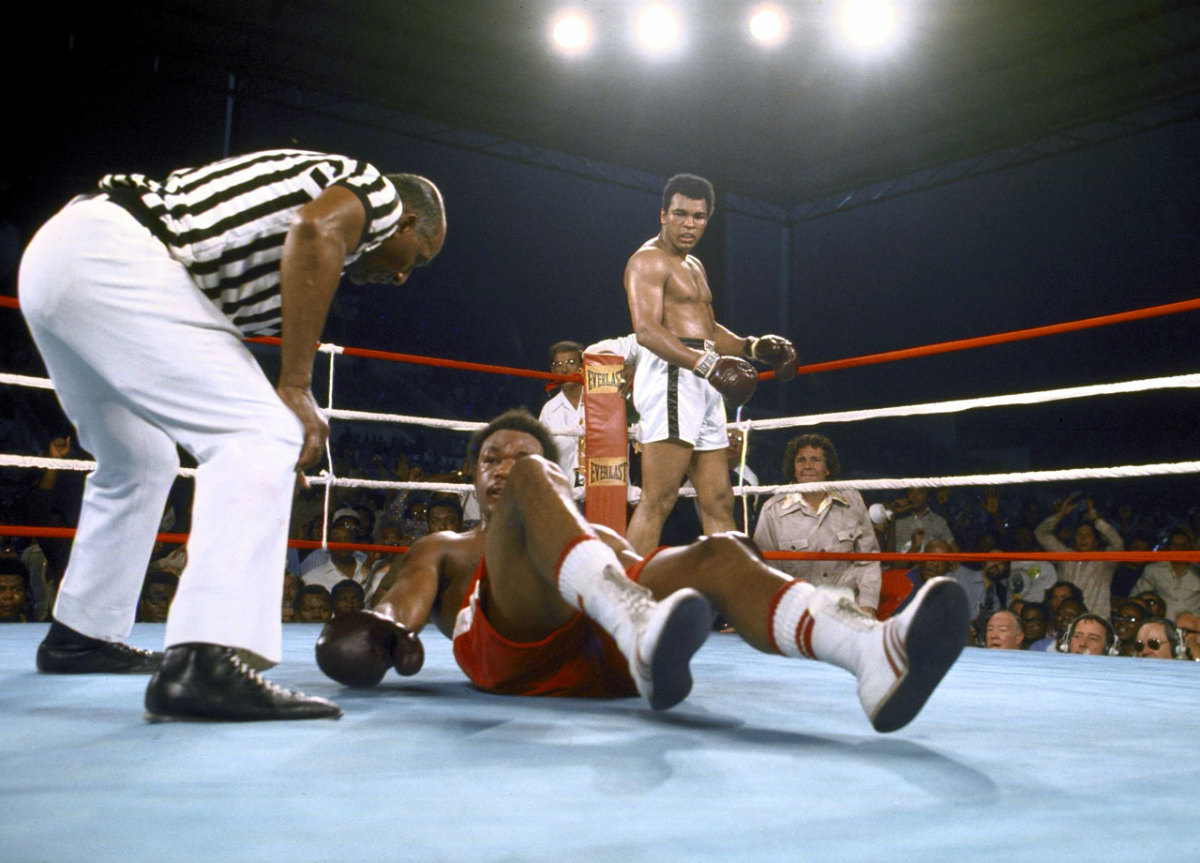
Foreman lies down on the canvas as Ali stands in the background during the Rumble in the Jungle. Ali knocked Foreman down with a five-punch combination in the eighth round, and referee Zack Clayton counted him out.
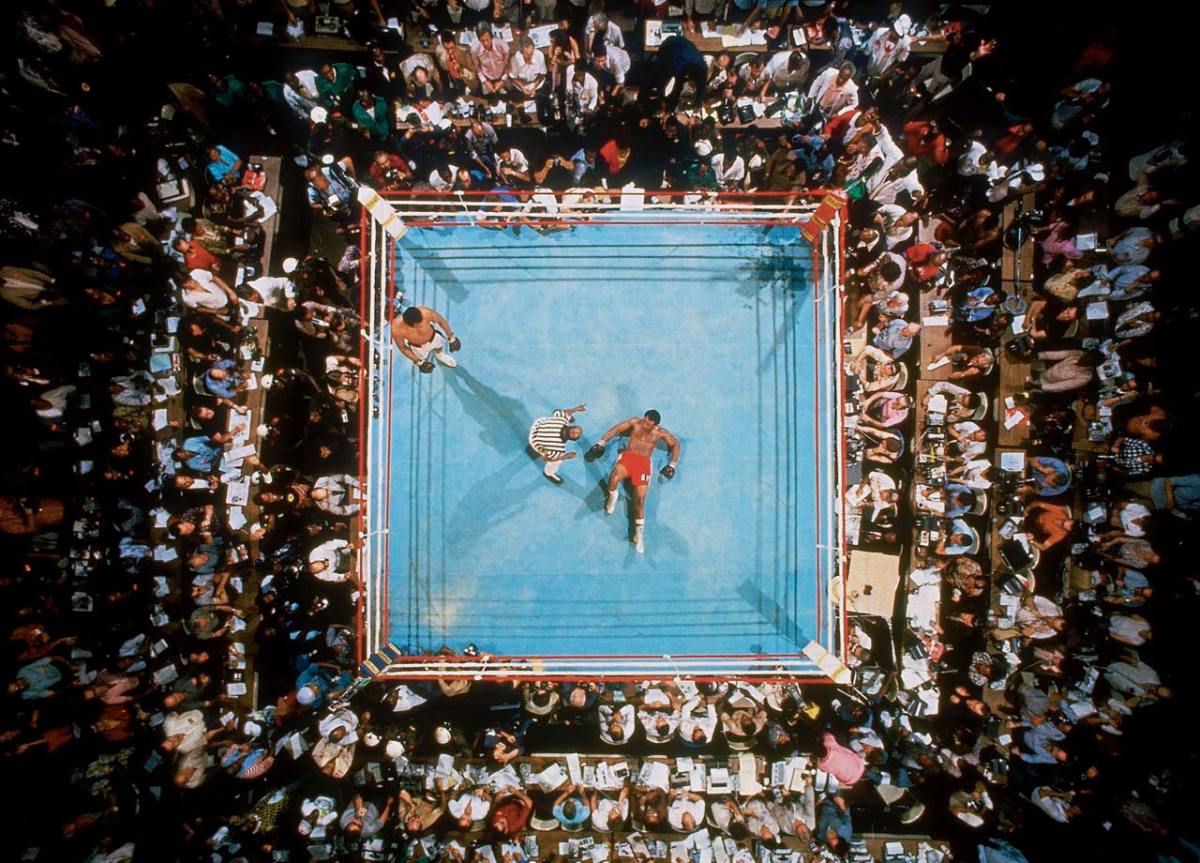
Big George stares at the ceiling as referee Zack Clayton counts him out in the eighth round. The victory made Ali, once again, the heavyweight champion of the world.
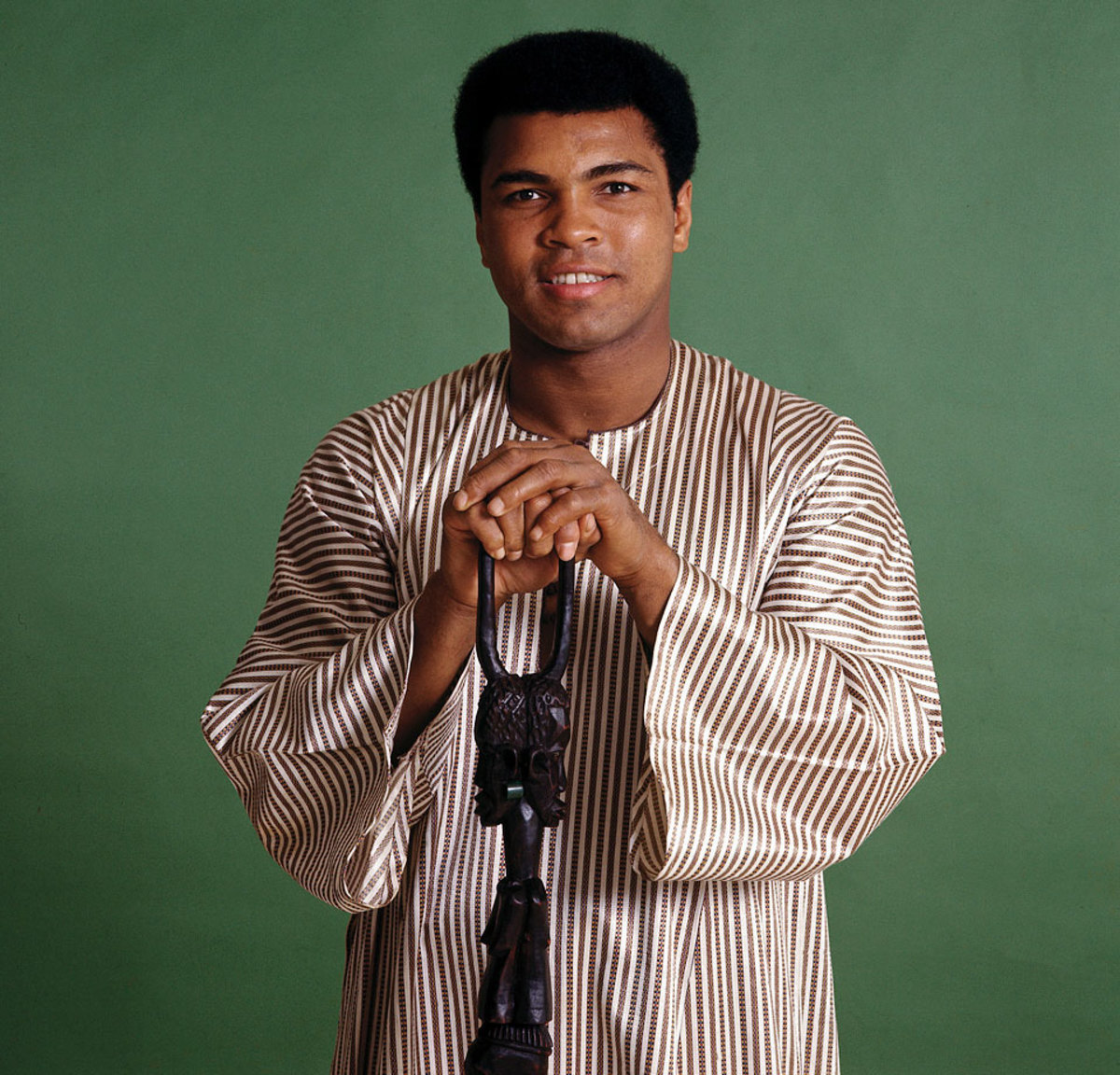
Ali poses for a portrait after being selected as the Sports Illustrated Sportsman of the Year in 1974. Ali wore a dashiki, a men's garment widely worn in West Africa. He also brought the walking stick given to him by Zaire's president.
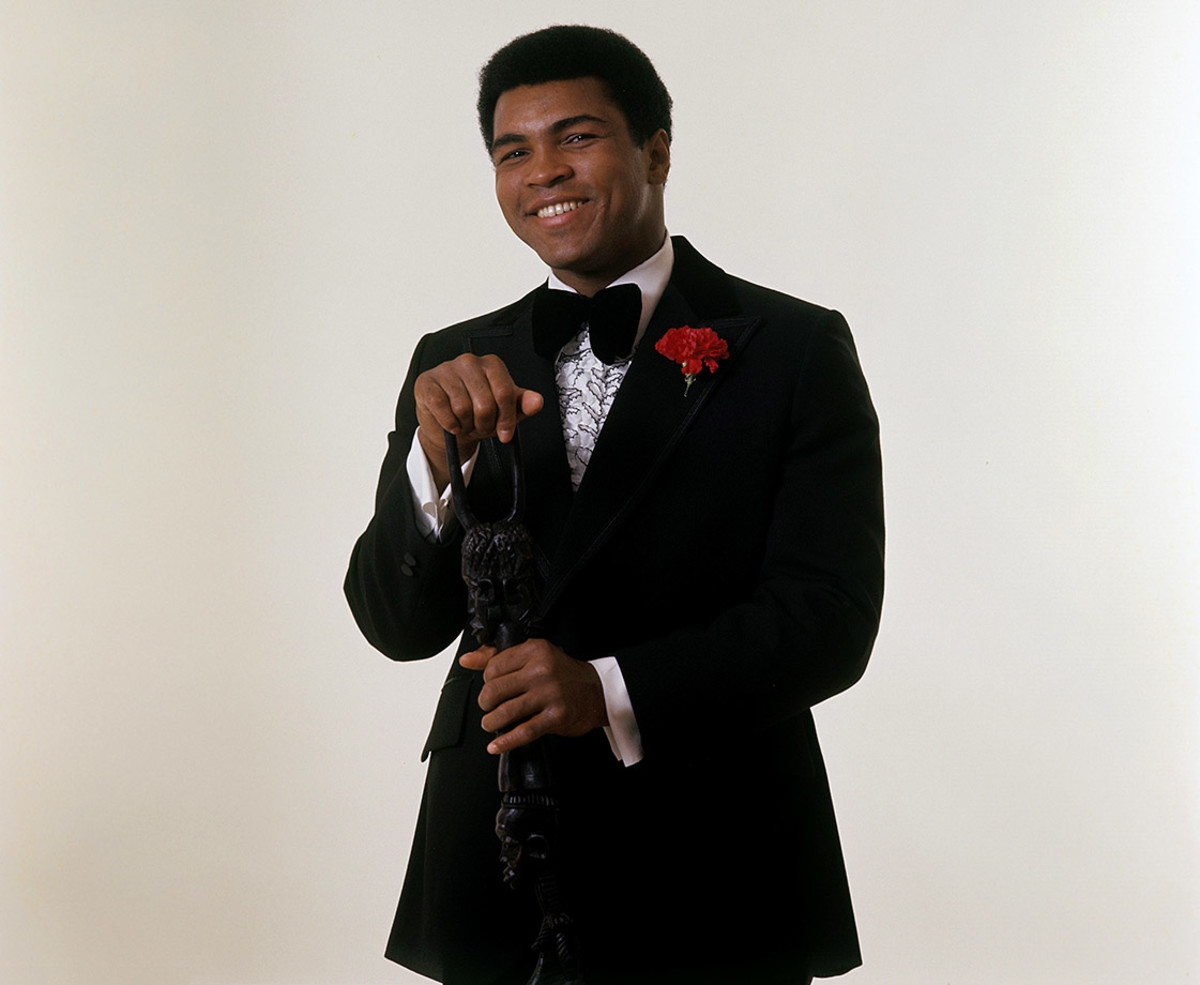
This time Ali wears a tuxedo, but keeps the walking stick, during the November photo shoot for Sports Illustrated's Sportsman of the Year.
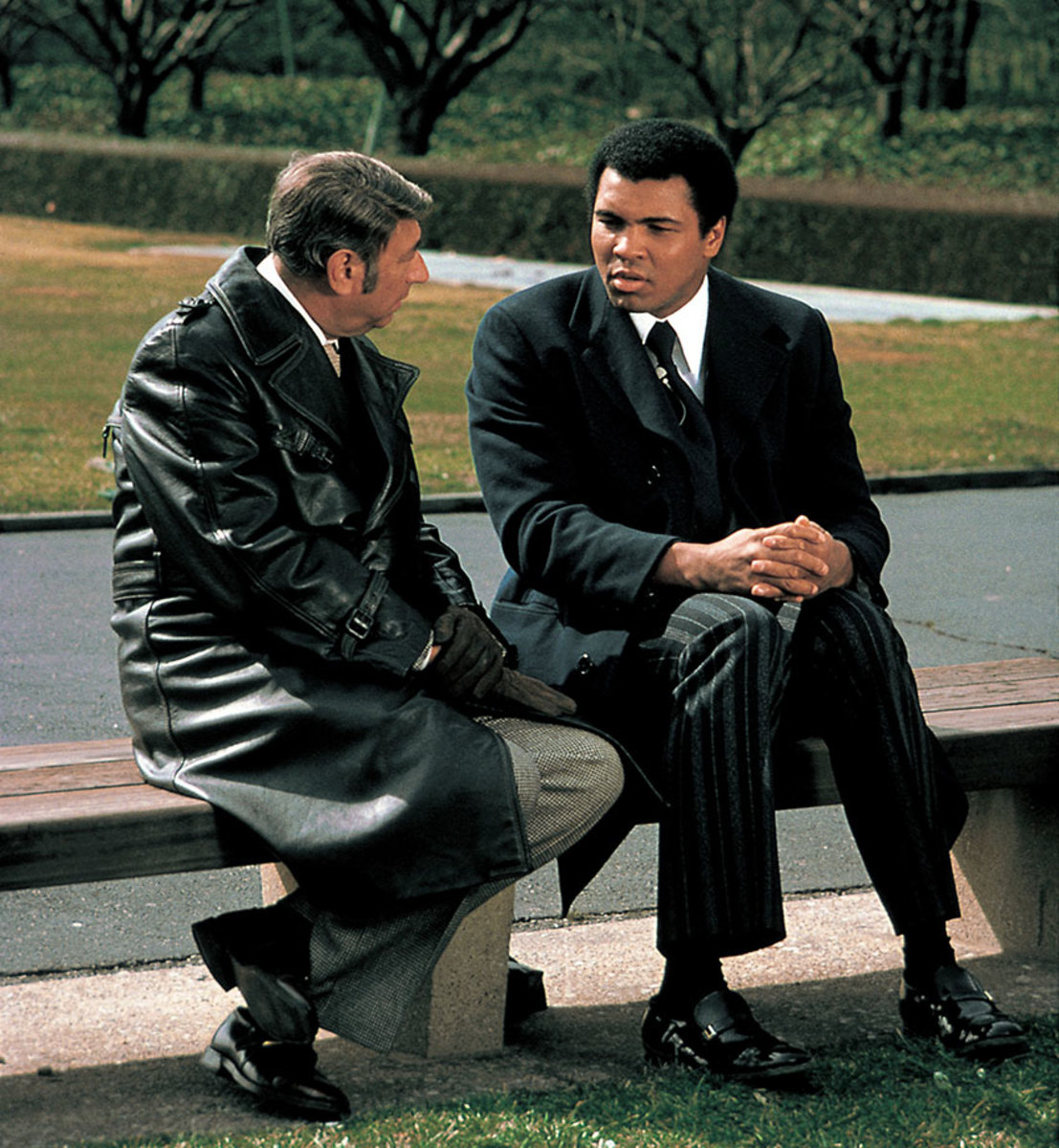
Ali talks with Howard Cosell outside of the United Nations Headquarters for a segment on the Wide World of Sports. Later that day, Ali held a press conference to announce that he would donate part of the proceeds from his fight against Chuck Wepner to help Africans in the Sahel drought.
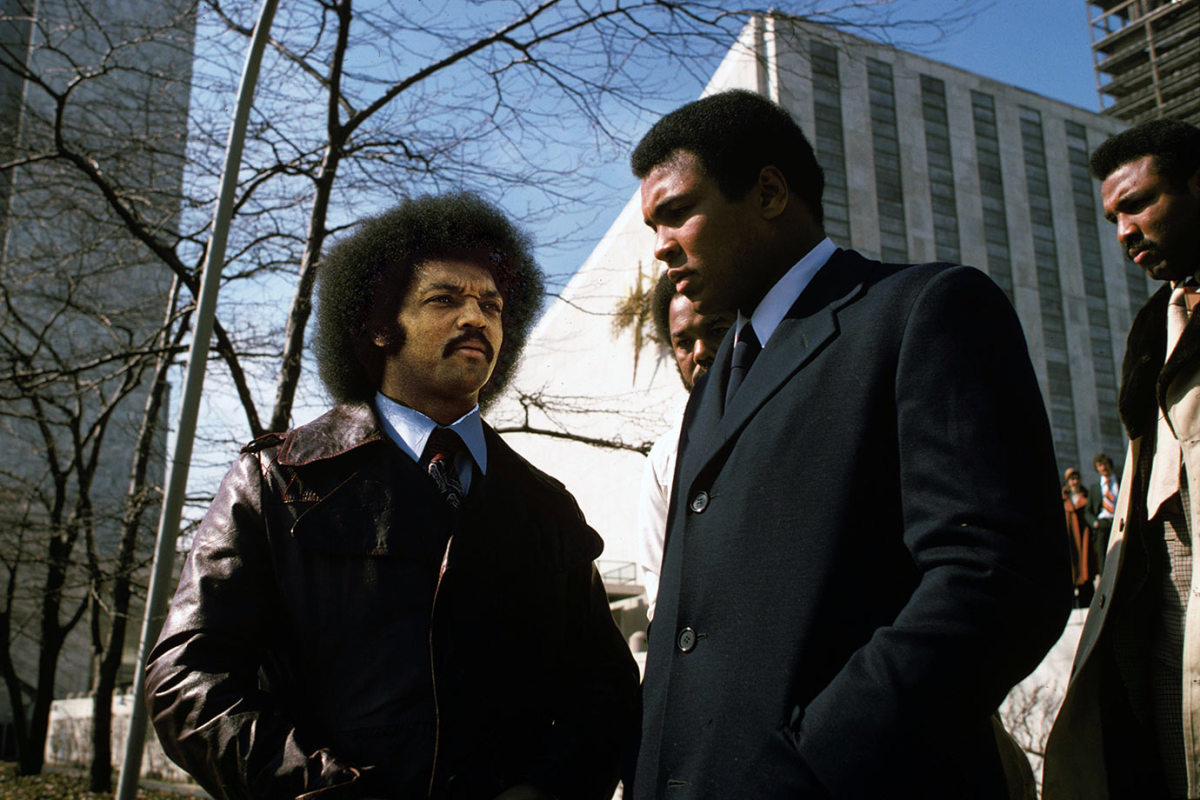
Ali talks with Reverend Jesse Jackson outside of the United Nations Headquarters before a press conference to announce that he would donate part of the proceeds from his fight against Chuck Wepner to help Africans in the Sahel drought.
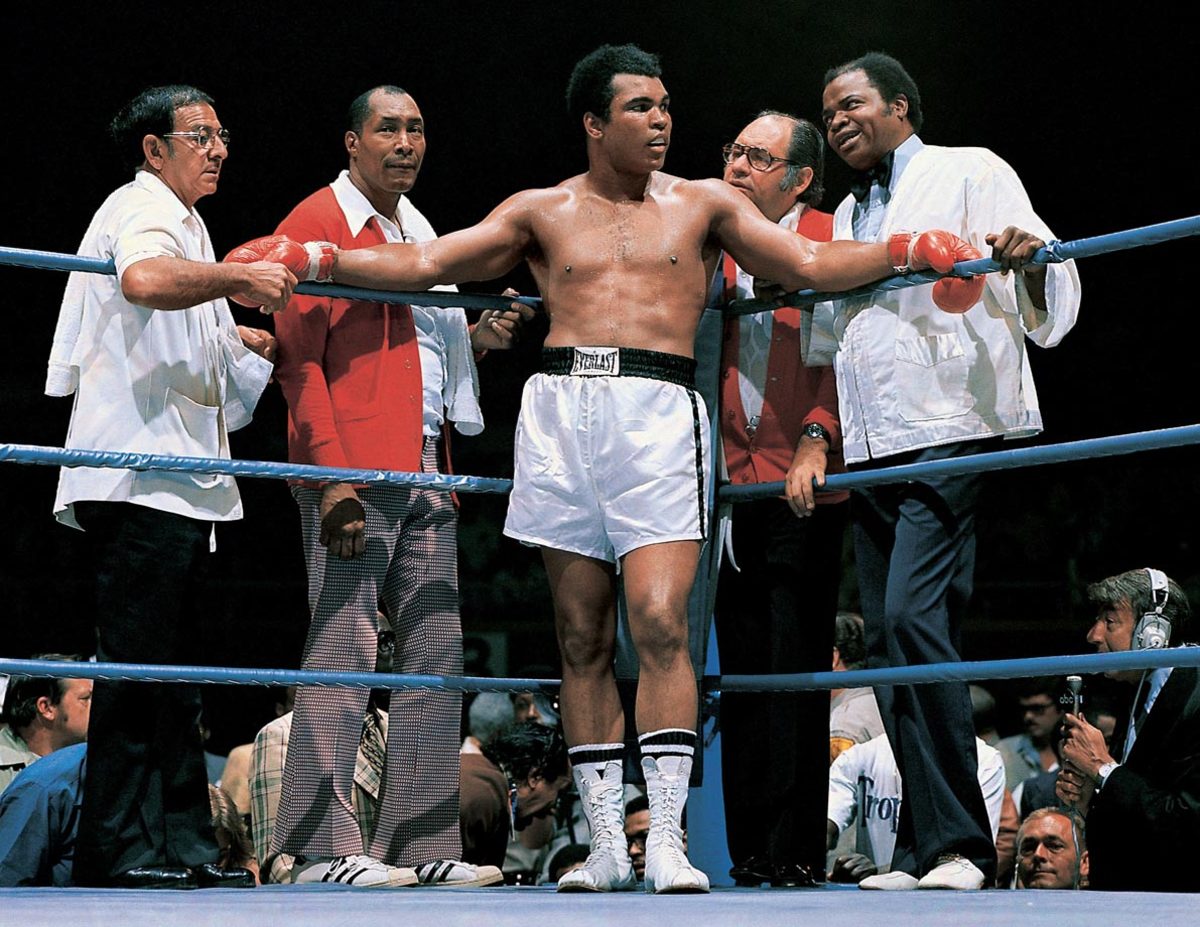
Ali stands with trainer Angelo Dundee, assistant trainer Wali Muhammad, physician Dr. Ferdie Pacheco and assistant trainer Drew Bundini Brown before his bout with Ron Lyle in May 1975. Ali won the fight by technical knockout in the 11th round.
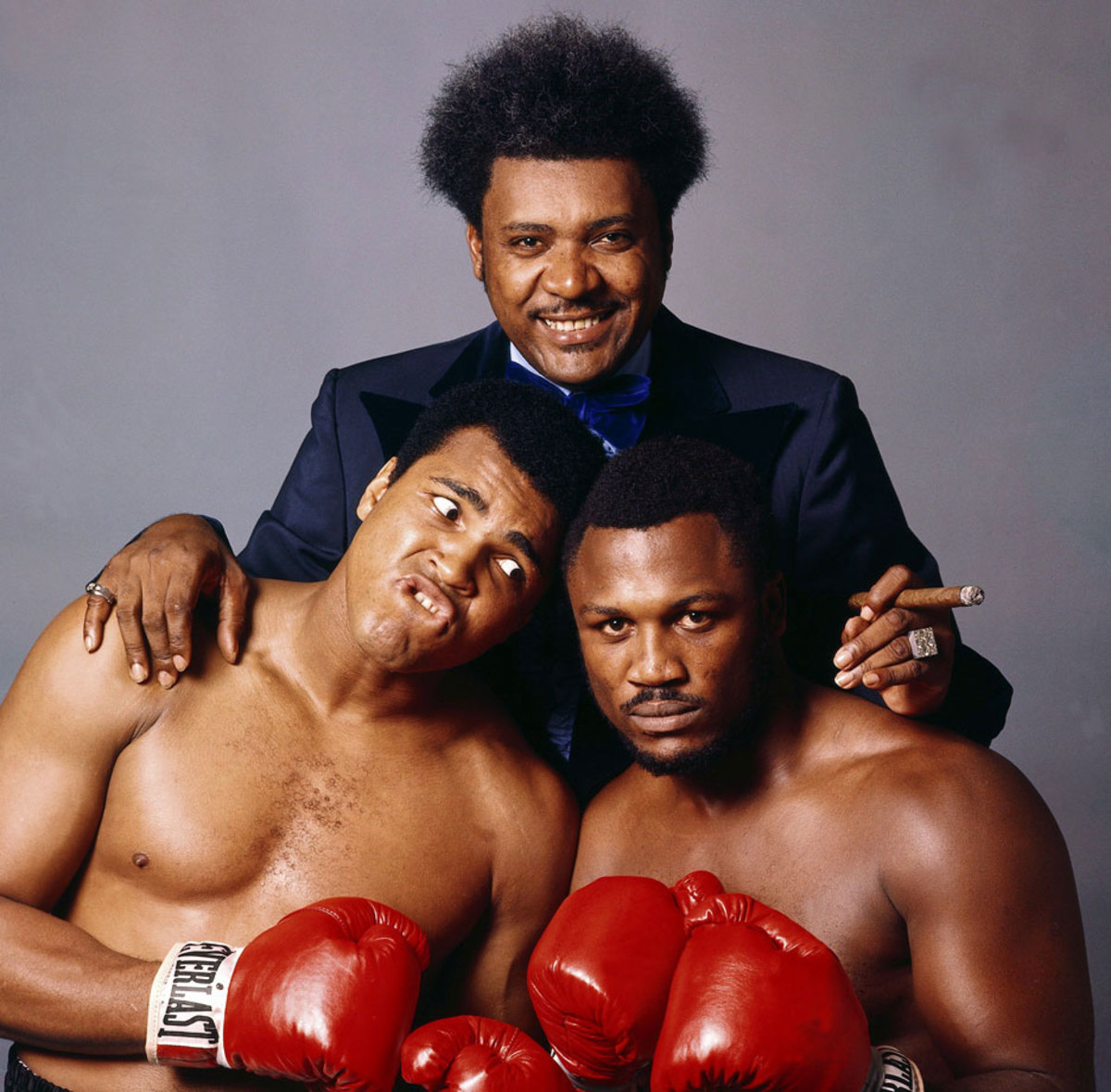
Along with Don King and Joe Frazier, Ali sat for a portrait leading up to the Thrilla in Manila. Ali verbally abused Frazier during the buildup to the fight, telling the media that "it will be a killa and a thrilla and a chilla when I get the gorilla in Manila."
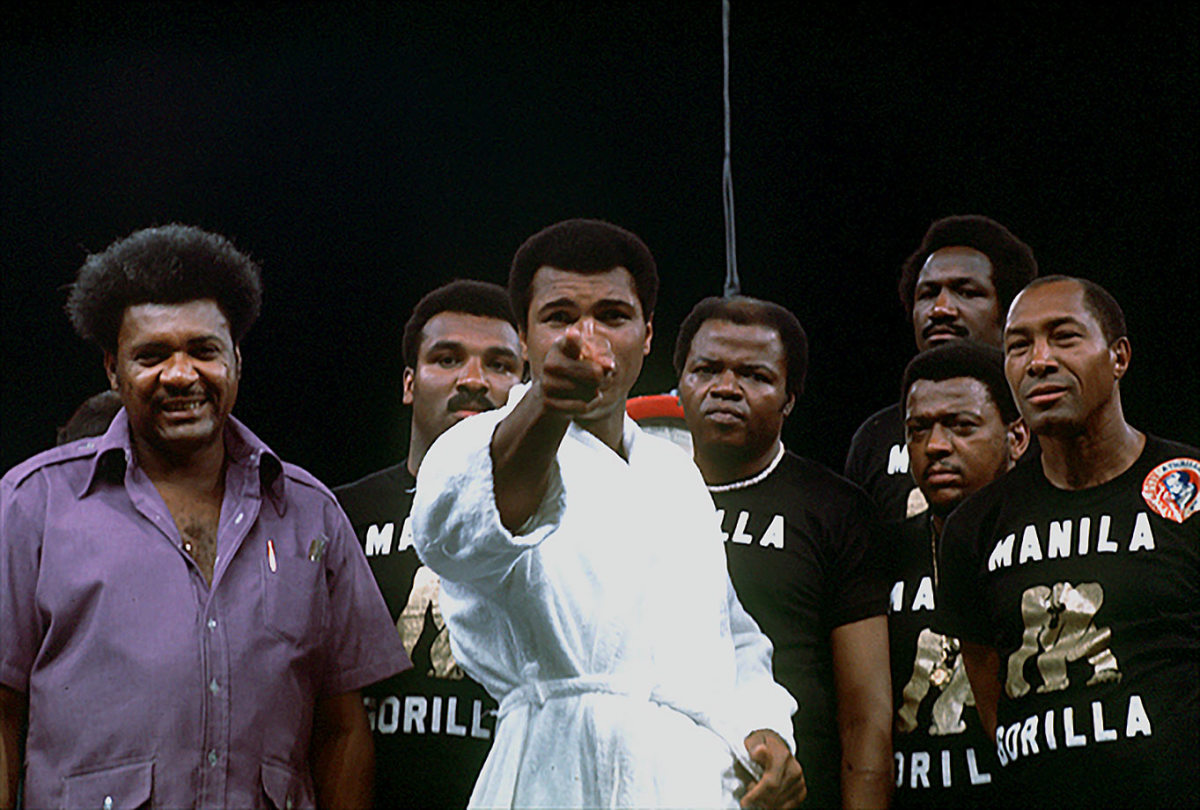
Ali points at the camera with Don King and his training staff behind him before the weigh-in for the Thrilla in Manila in October 1975. Philippine president Ferdinand Marcos offered to sponsor the bout and hold it in Metro Manila to divert attention from the turmoil in the country that had forced the imposition of martial law in 1972.
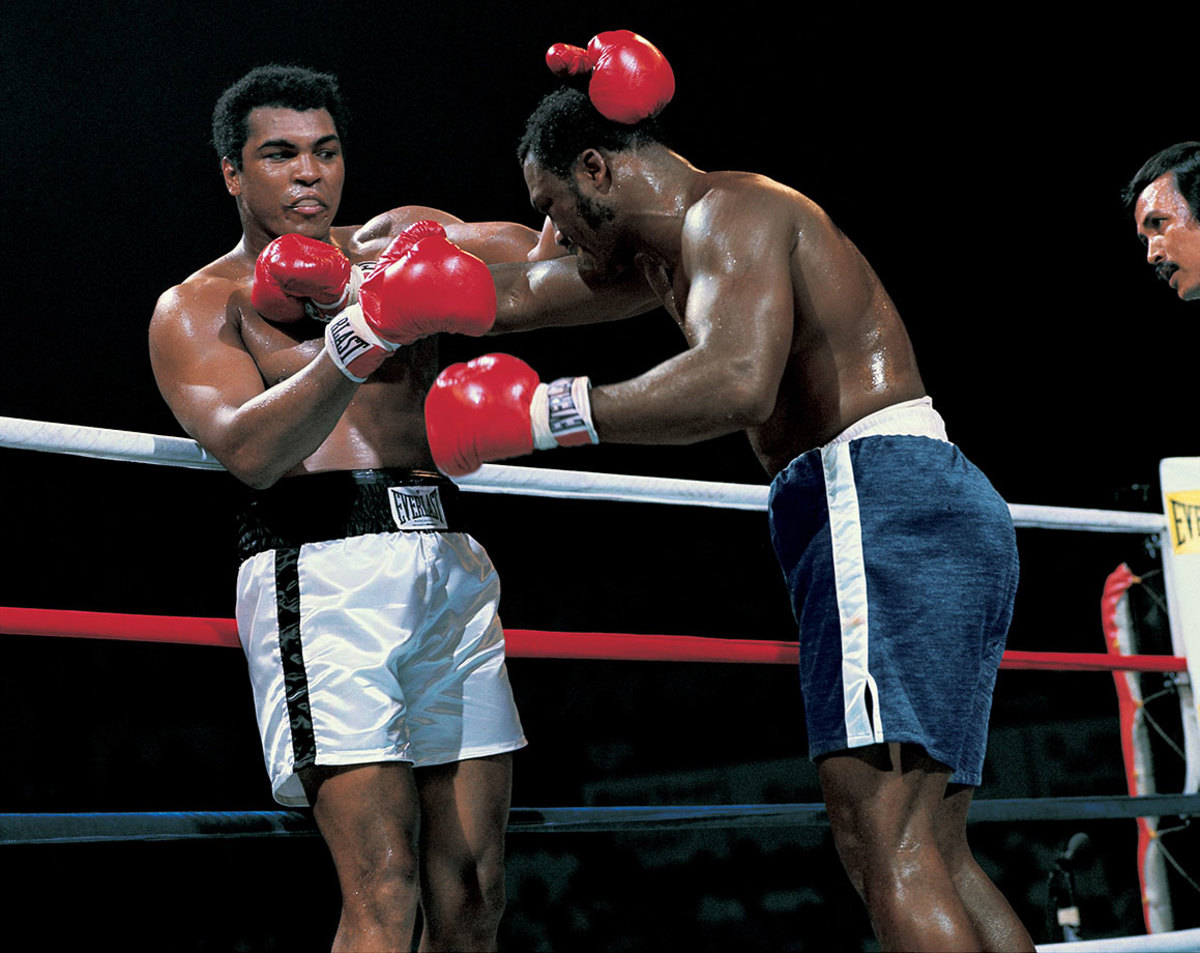
Wrapping up Joe Frazier proved more difficult than Ali expected, having thought Frazier would represent an easy payday and be unable to live up to his billing. The fight turned out to be a brutal affair.
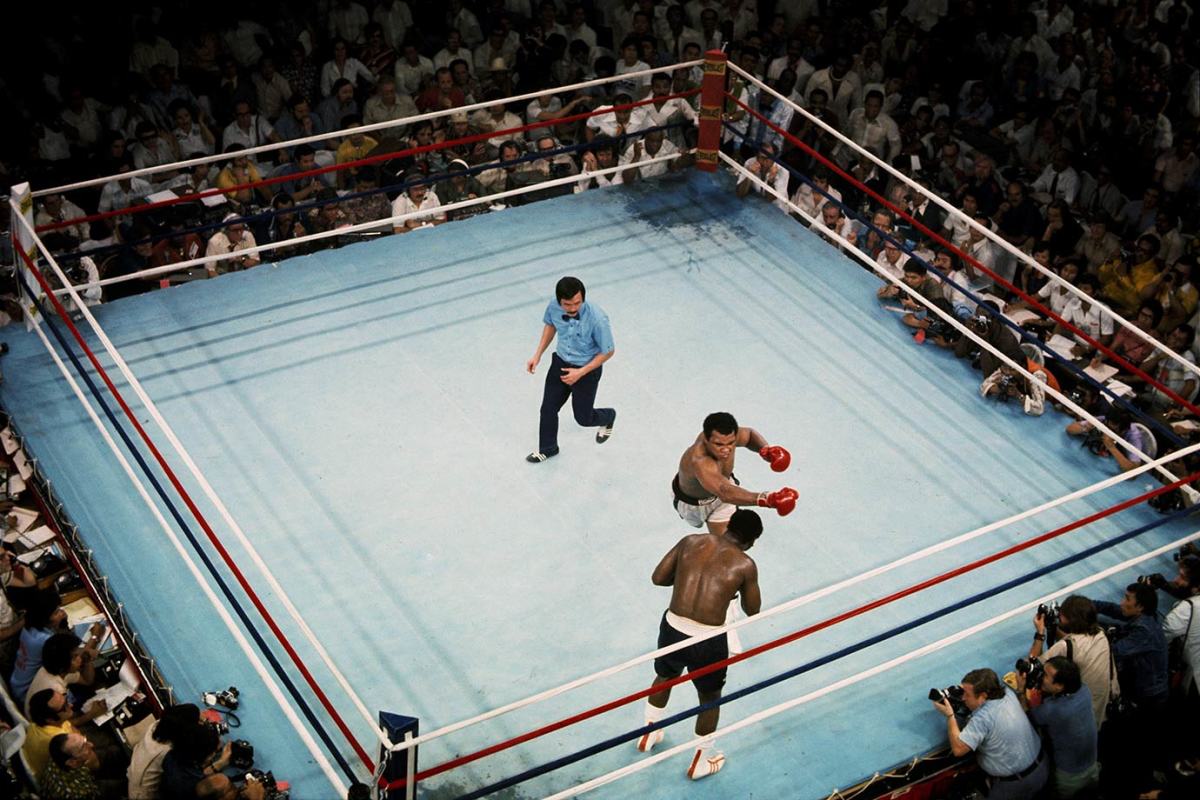
Frazier faces an Ali right hook in their fight in Quezon City, Philippines. The two fighters traded vicious blows during their 14 rounds. "Man, I hit him with punches that'd bring down the walls of a city," Frazier said. Ali withstood the blows to win by TKO in the 15th round.
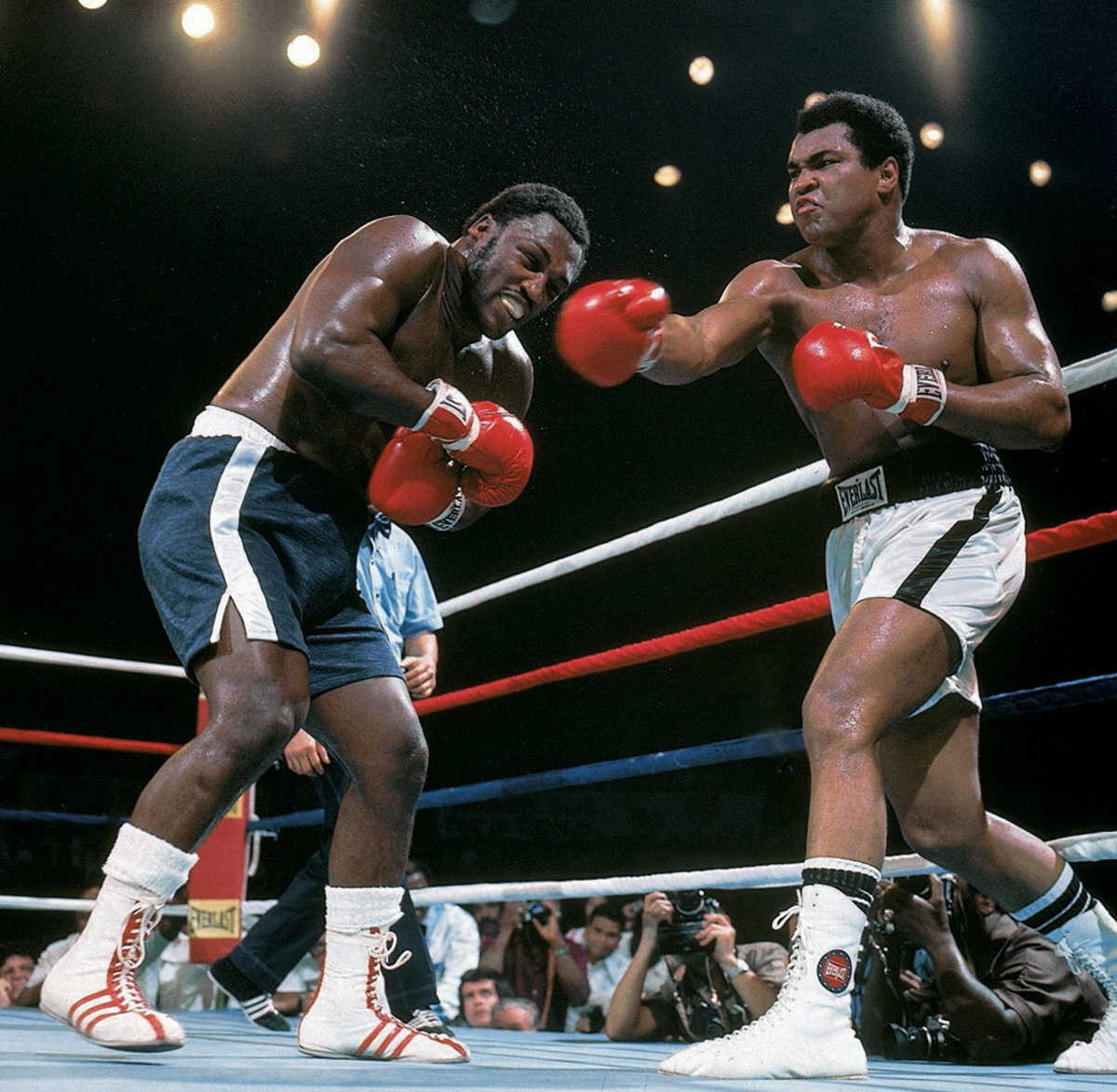
The third fight between Ali and Frazier, Ali won the bruising battle between the two powerful punching heavyweights when Frazier's trainer, Eddie Futch, stopped the fight before the 15th round.
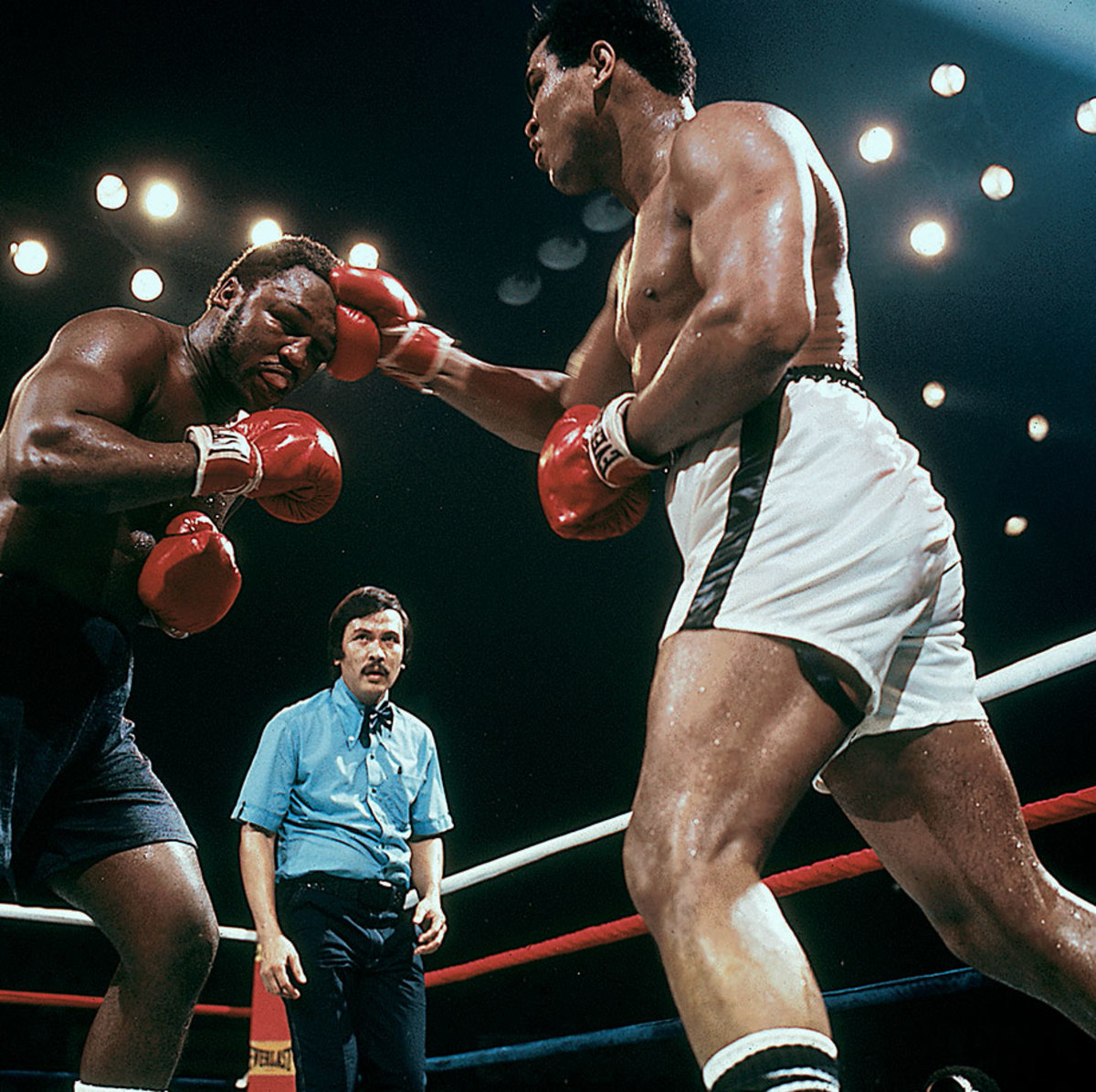
A back and forth exchange, Ali controlled the early rounds of the Thrilla in Manila before Frazier fought back with powerful hooks. Ali finished strong, regaining momentum in the later rounds.
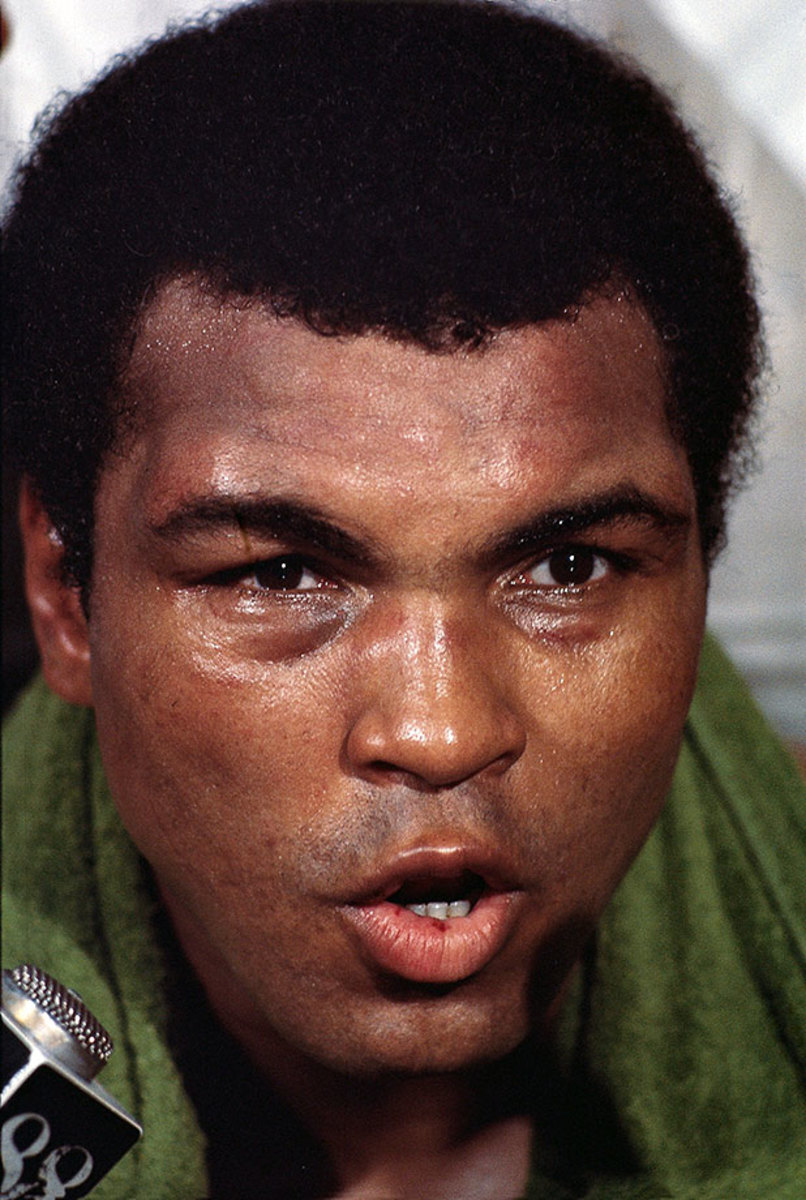
Ali speaks to the press after winning the Thrilla in Manila bout with Frazier.
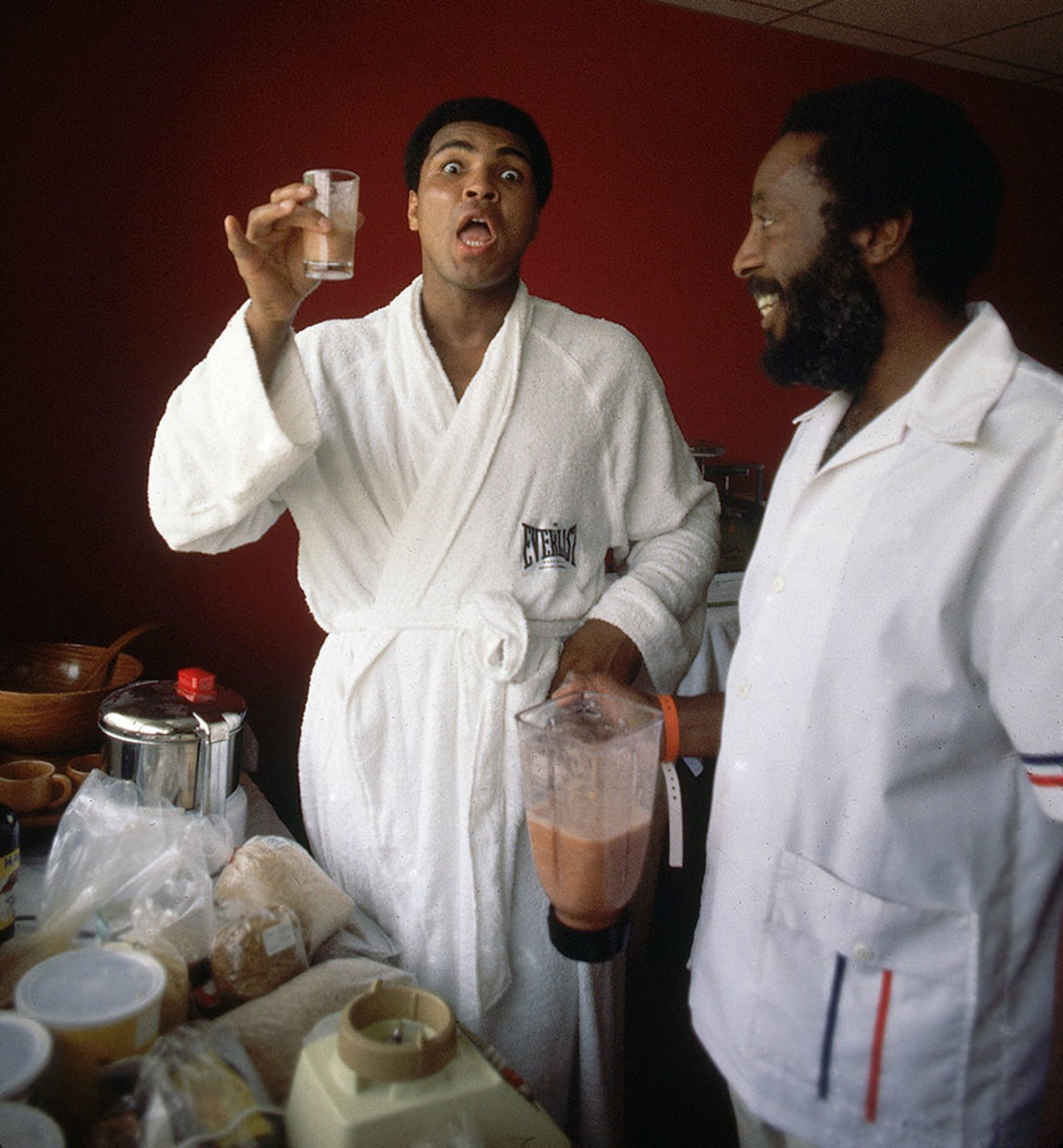
Ali holds a drinking concoction given to him by Dick Gregory, an advocate of a raw fruit and vegetable diet, in 1976.
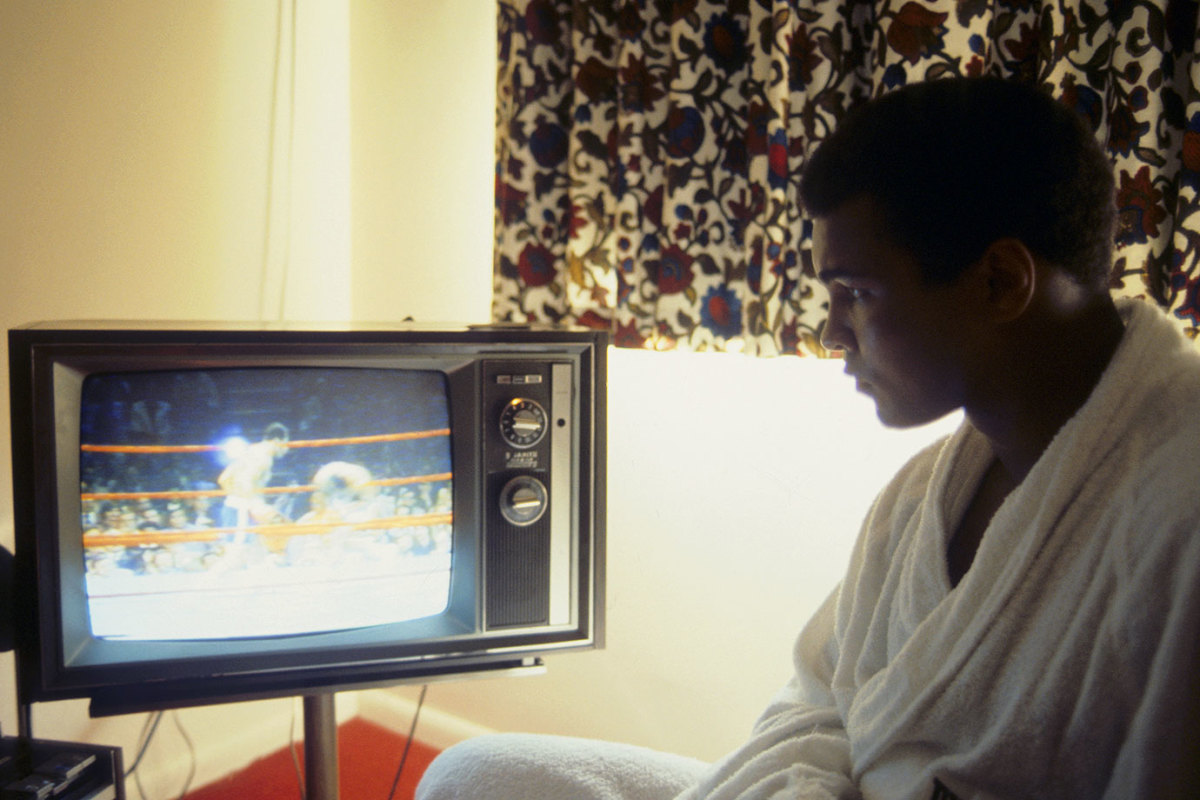
Before his 1976 fight against Ken Norton at Yankee Stadium, Ali watches a fight on television from his hotel room. A police strike at the time of the fight created a dangerous environment outside the stadium that all but eliminated walk-up sales.
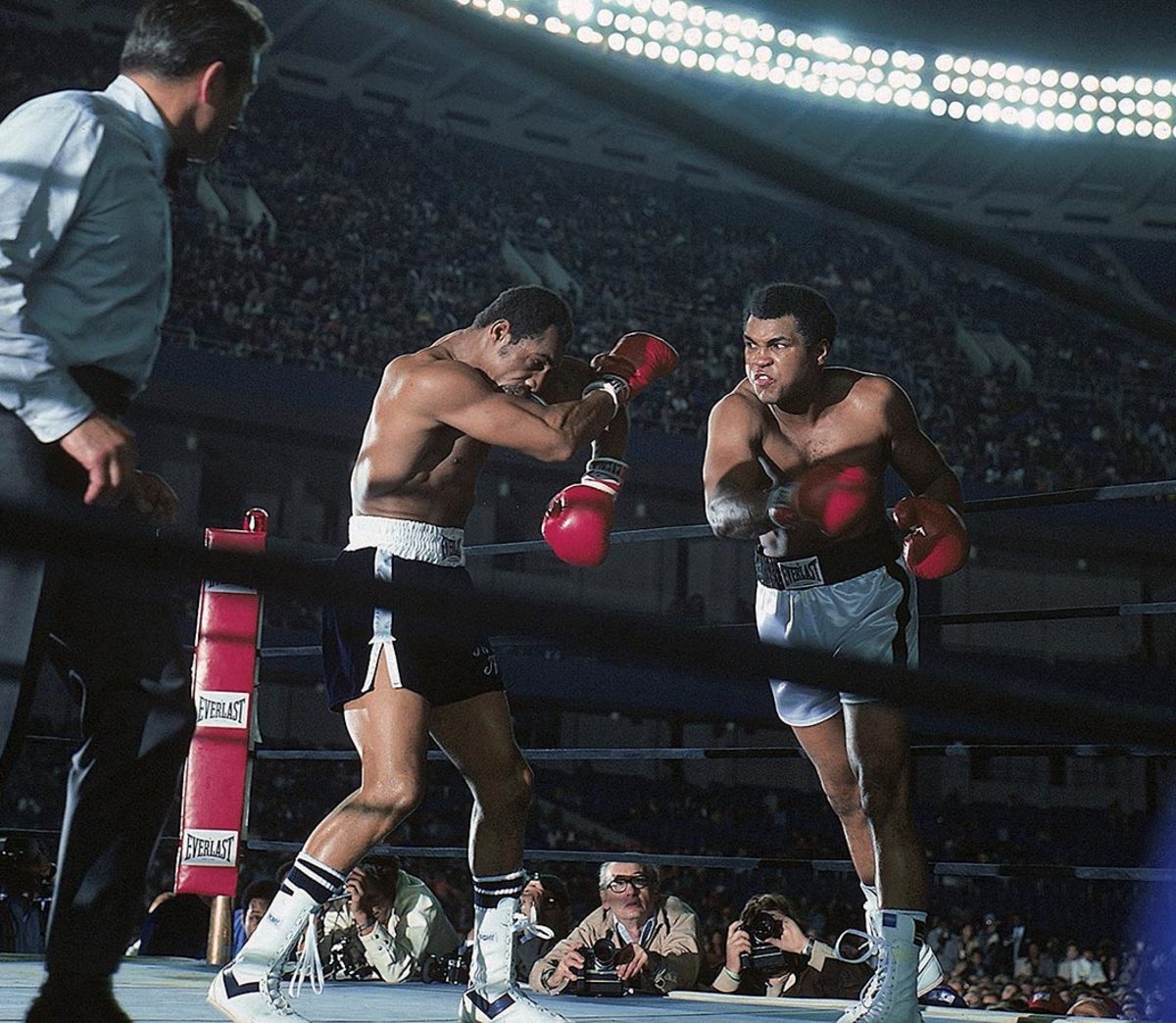
Norton takes a right hook during the heavyweight title fight against Ali. The bout, which Ali won by a unanimous, but controversial, decision, was the last boxing match at Yankee Stadium until 2010.
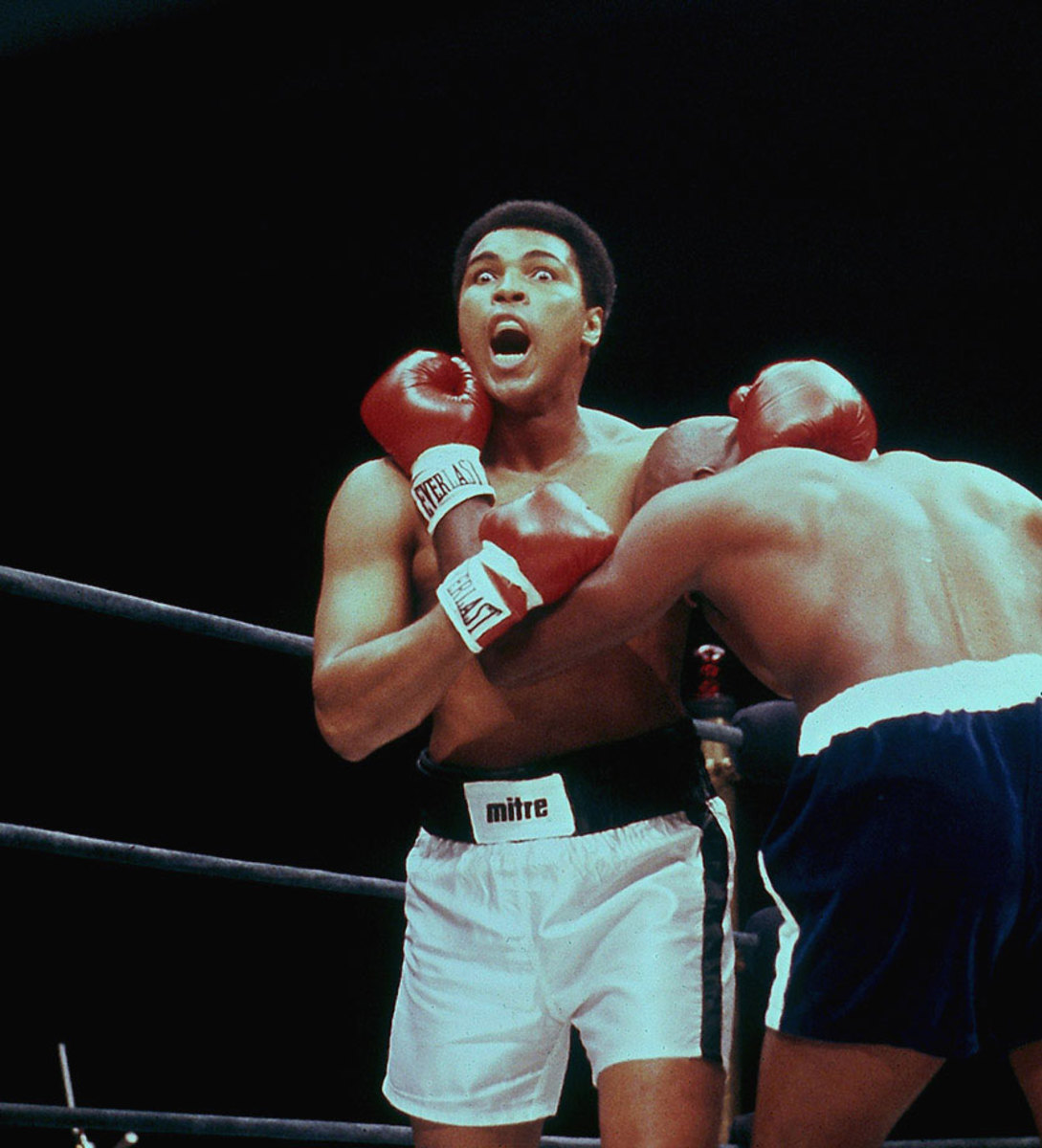
Ali makes a face during his fight with Earnie Shavers in 1977 at Madison Square Garden. Hurt badly by Shavers in the second round, Ali rebounded and outboxed Shavers throughout to build a lead on points before Shavers came on again in the later rounds. Seemingly exhausted going into the 15th and final round, Ali remained victorious by producing a closing flurry that left Shavers wobbling at the bell and the Garden crowd once again in delirium over his Ali magic.
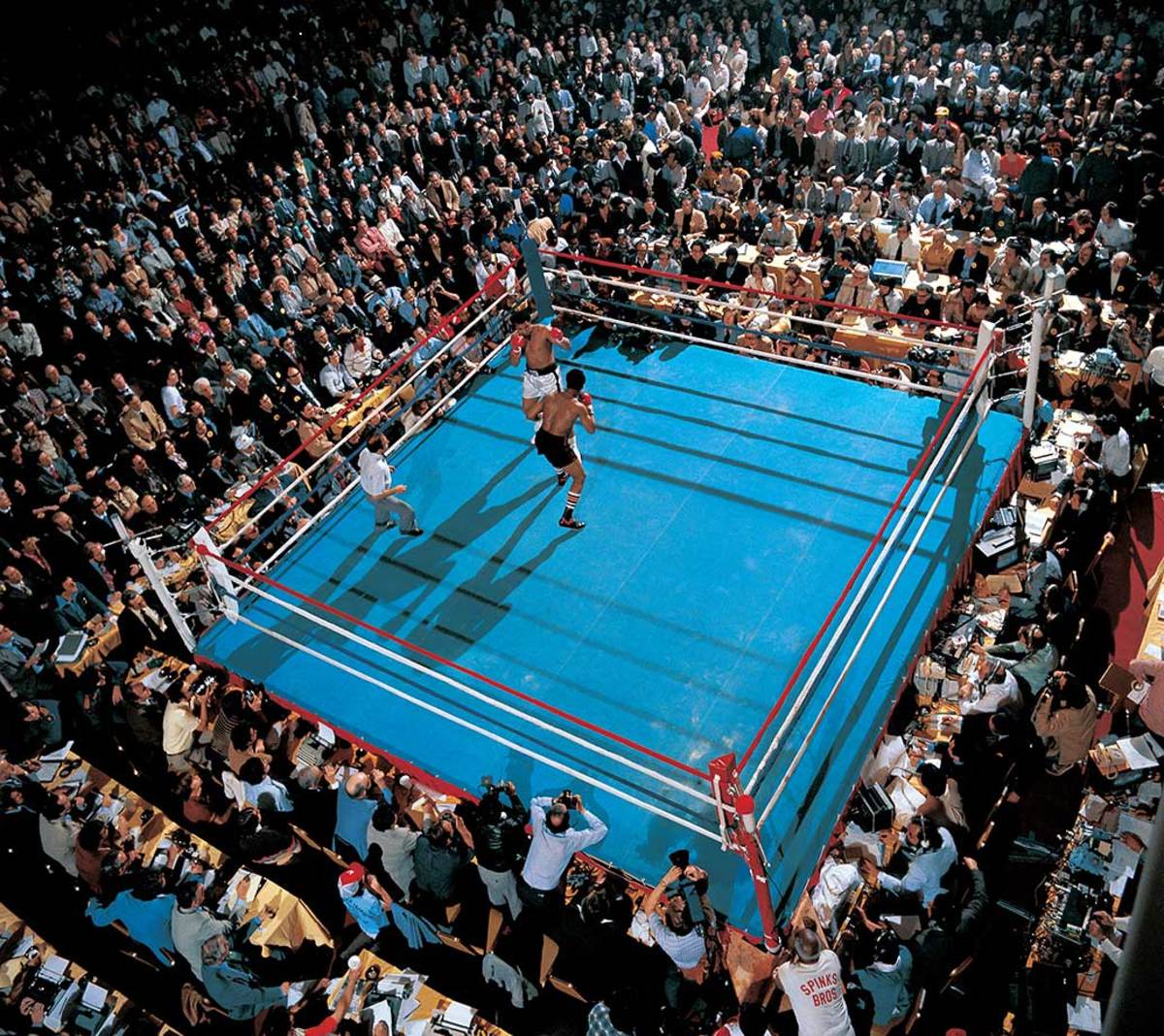
Ali squares off with Leon Spinks at the Las Vegas Hilton Hotel in February 1978. Spinks won the fight in a split decision, ending Ali's 3.5-year reign as the heavyweight champion. It was the only time in Ali's career that he lost his championship title in the ring.
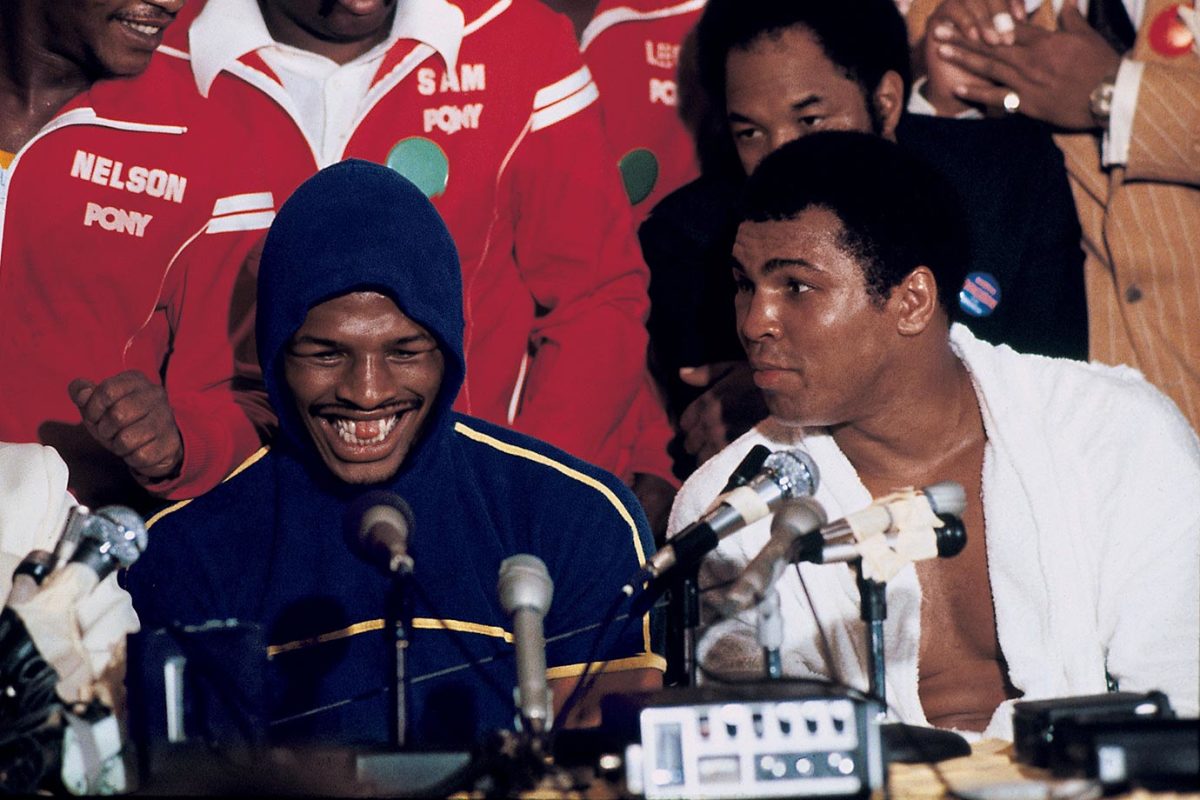
Leon Spinks took center stage over Ali at the press conference after their fight. The victorious Spinks and his gap-toothed grin were featured on the Feb. 19, 1978 cover of Sports Illustrated.
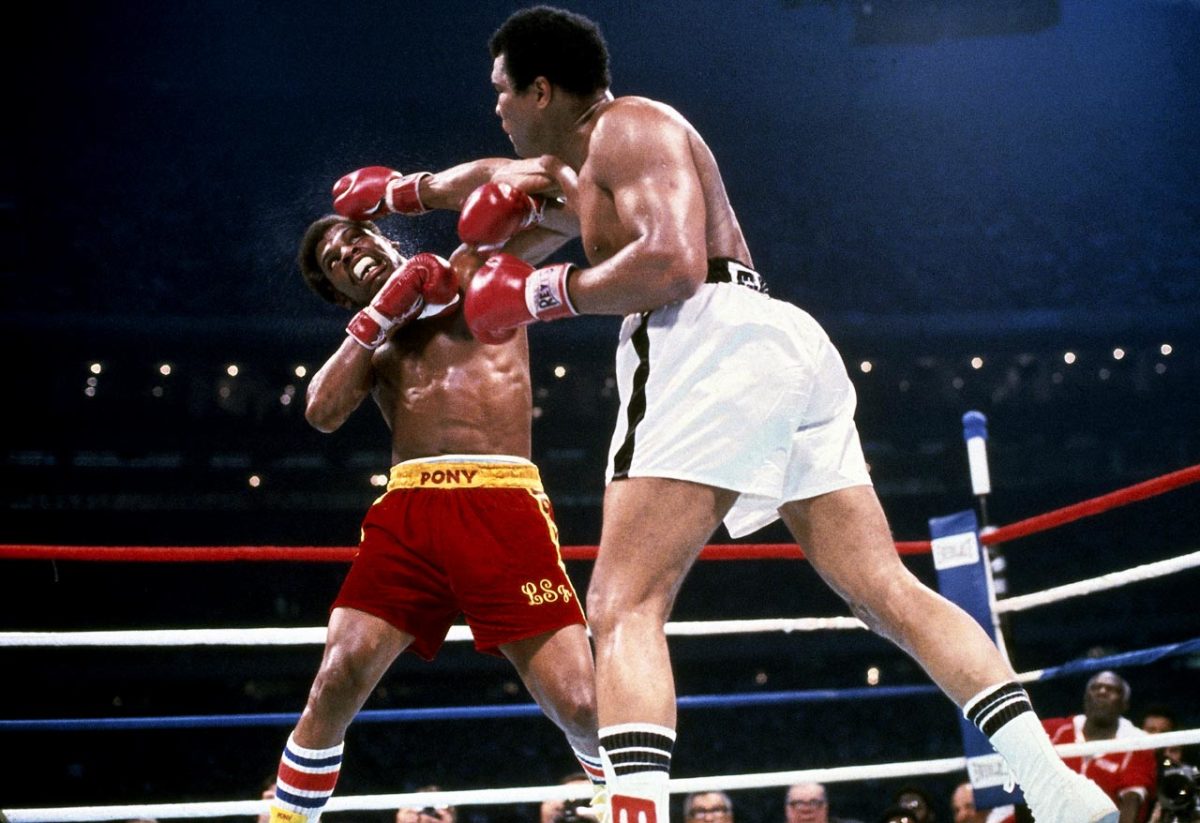
Ali lands a straight right hand to the head of Spinks in the rematch of their title bout in 1978. Ali won on a 15 round decision.
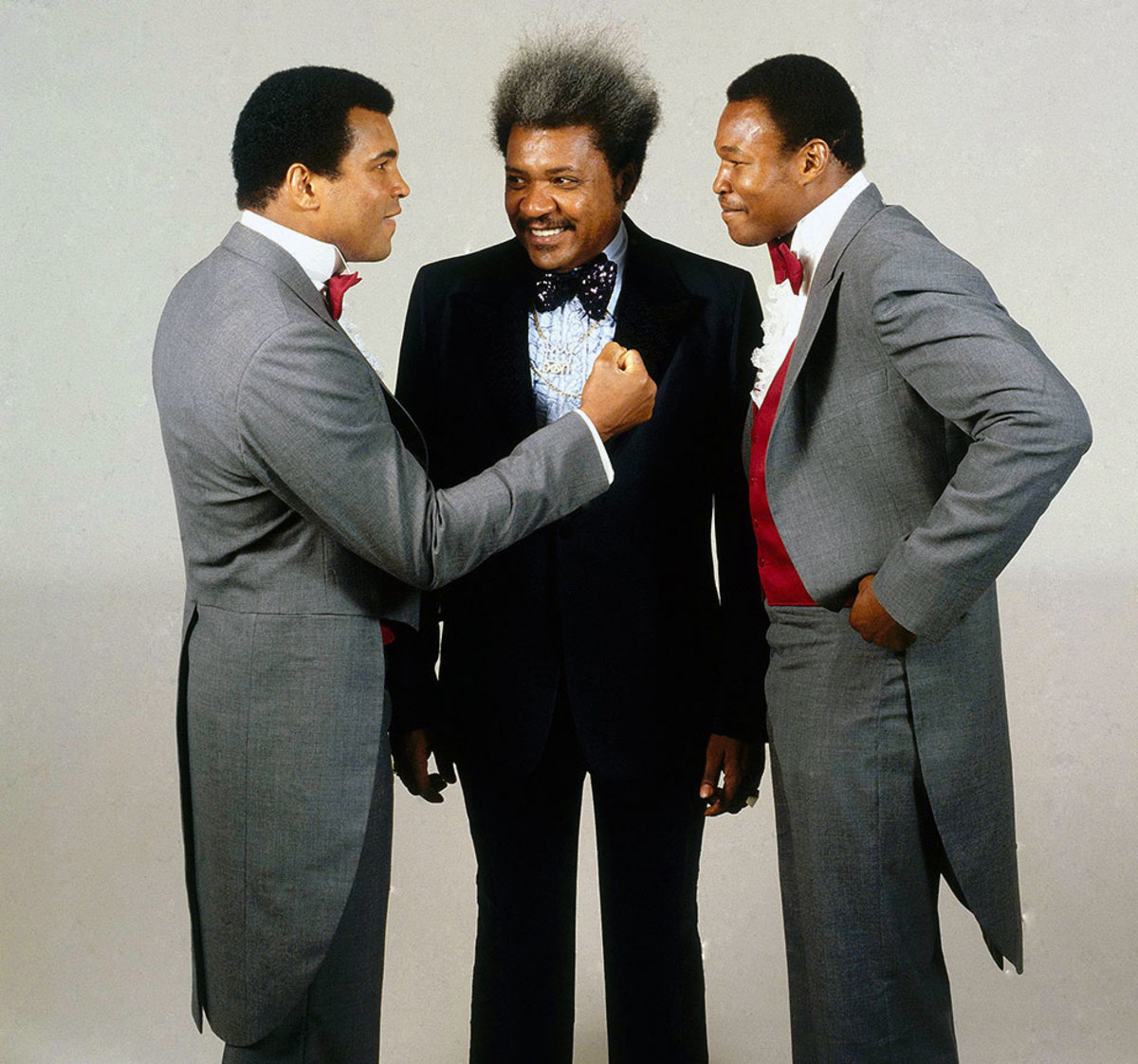
Don King pulled the strings again when Ali faced Larry Holmes before their November 1980 fight. King became a key figure in Ali's career, promoting his biggest fights, the Thrilla in Manila and the Rumble in the Jungle.
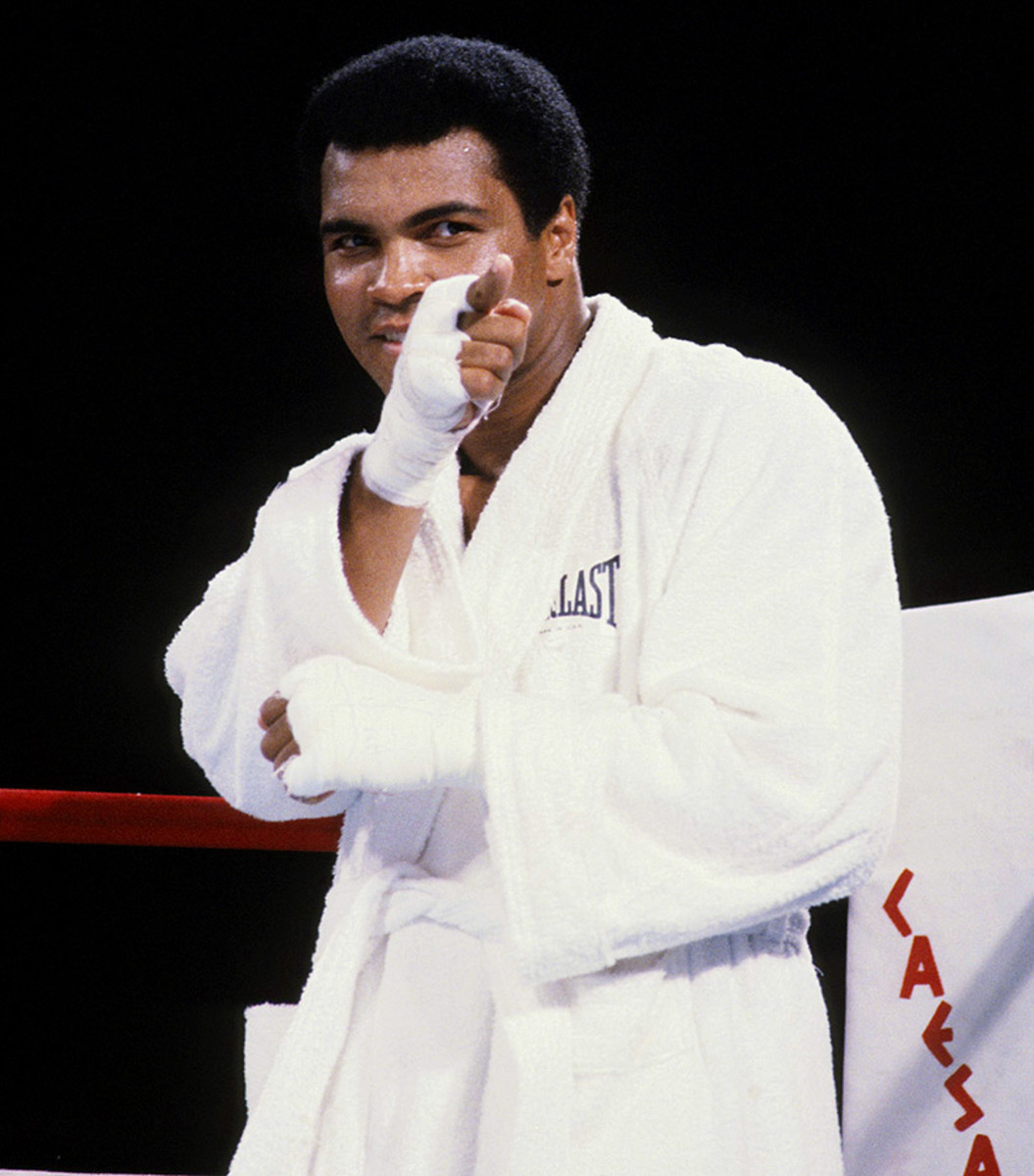
Ali points at Larry Holmes before their bout at Caesars Palace in 1980.
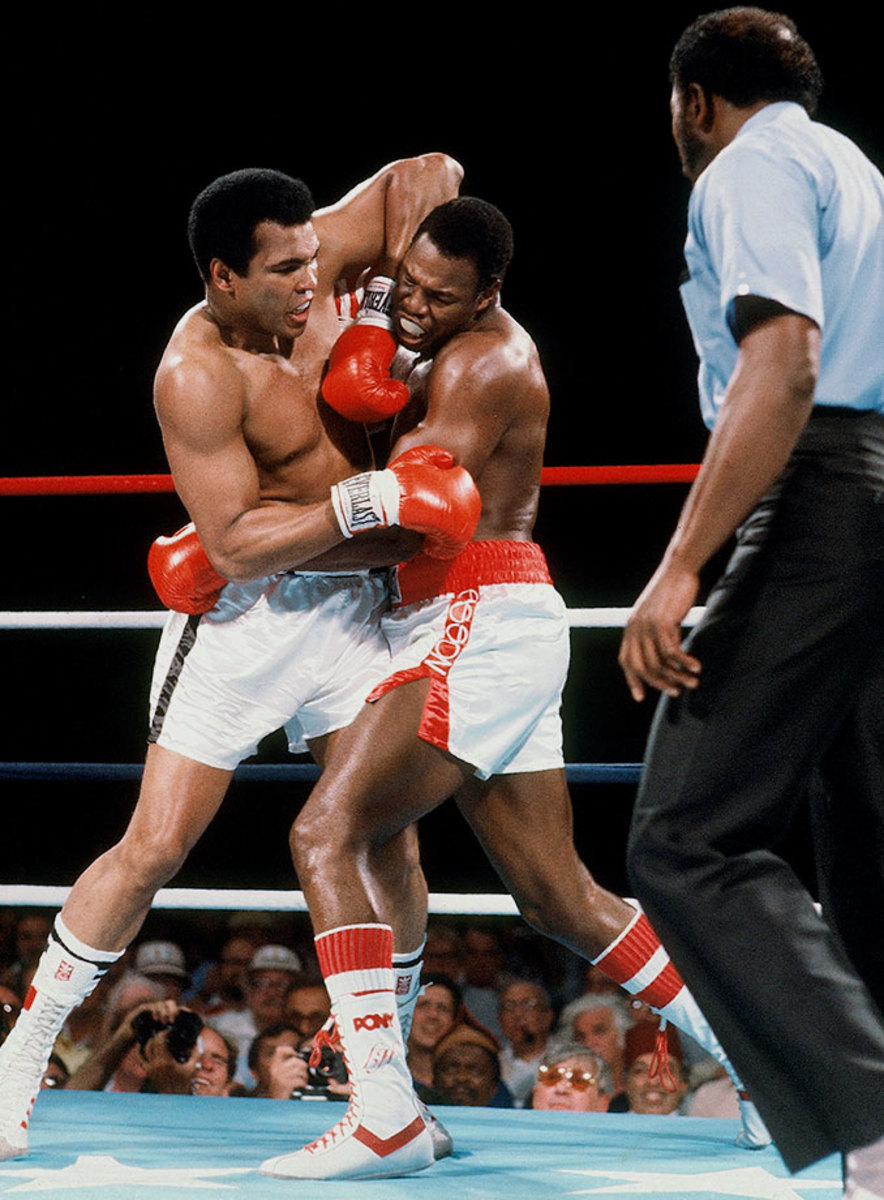
Ali grapples with Holmes during their bout in 1980. Trainer Angelo Dundee stopped the fight in the 11th round, marking the fight as Ali's only career loss by knockout.
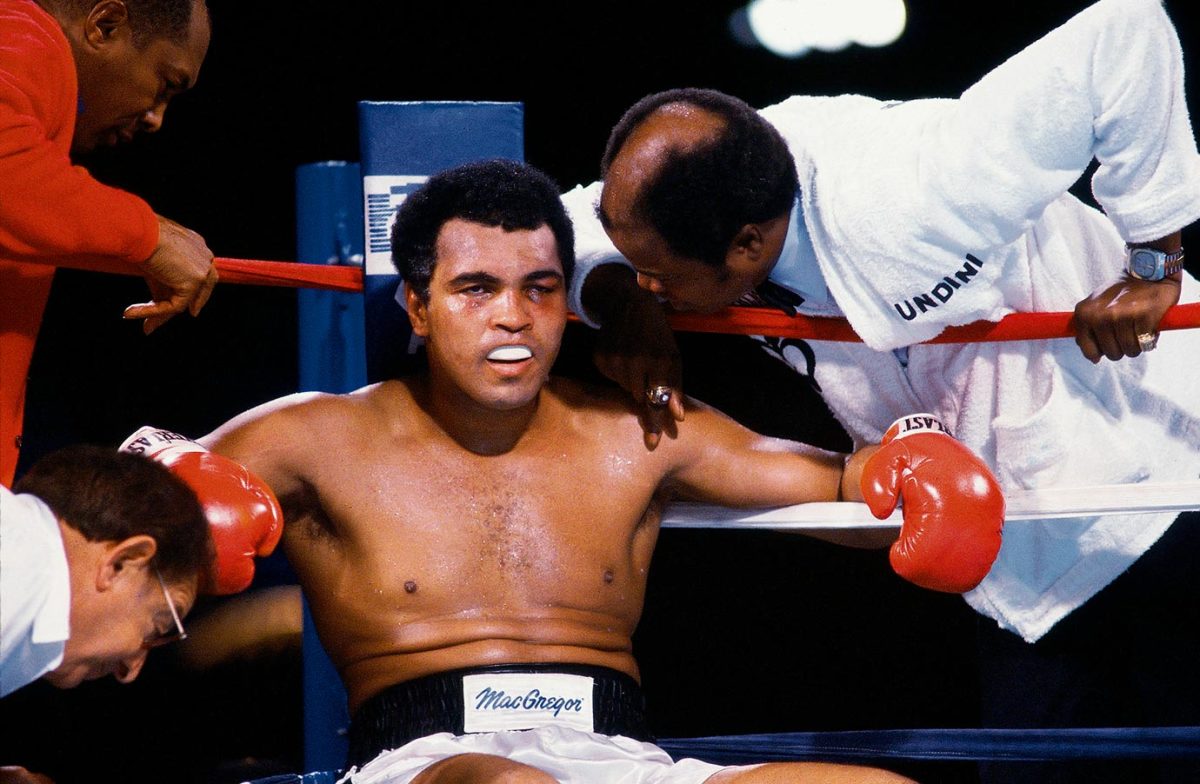
Drew Bundini Brown leans in to speak to Ali, who returned to fight Holmes after a brief retirement. By this time, Ali had already begun developing a vocal stutter and trembling hands and taken thyroid medication to lose weight that left him tired and short of breath.
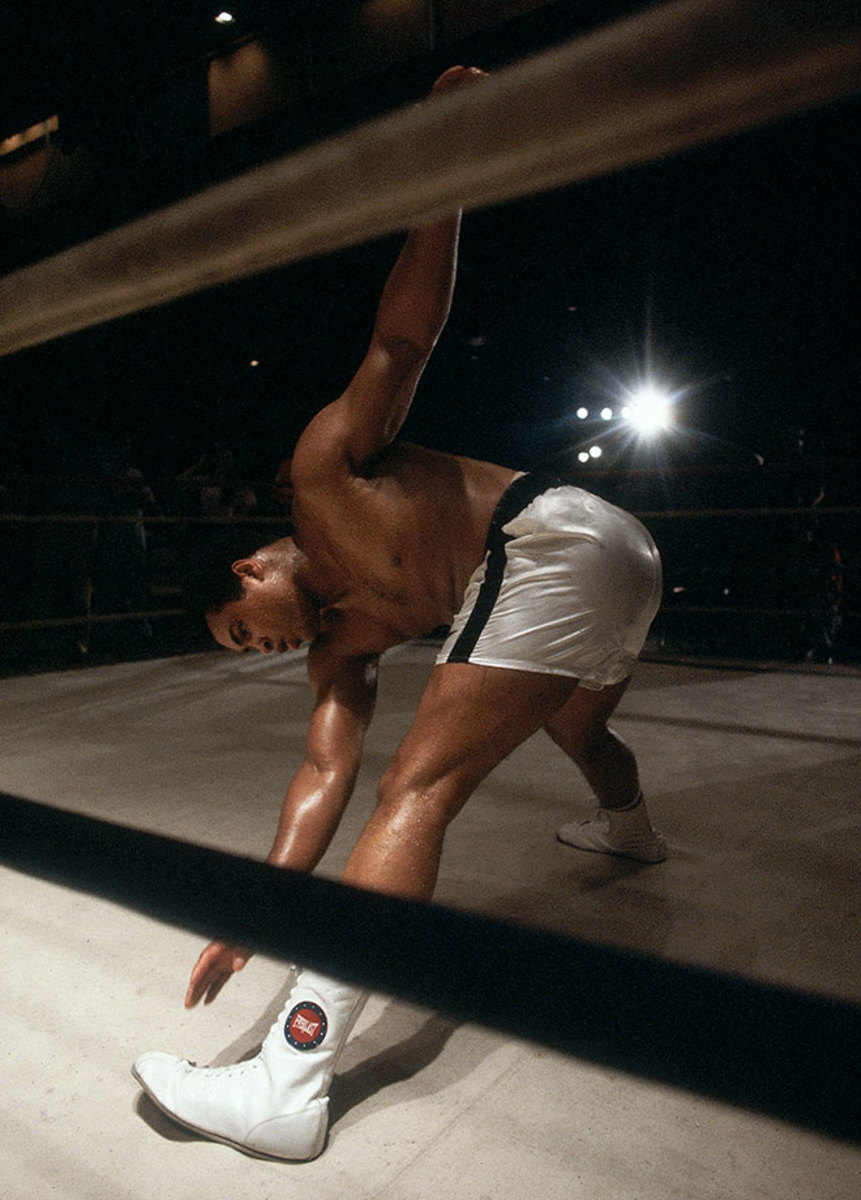
Ignoring pleas for his retirement, Ali stretches before a fight against Trevor Berbick in Nassau, Bahamas. Ali lost to Berbick in a unanimous decision and retired after the bout, the 61st of his career.
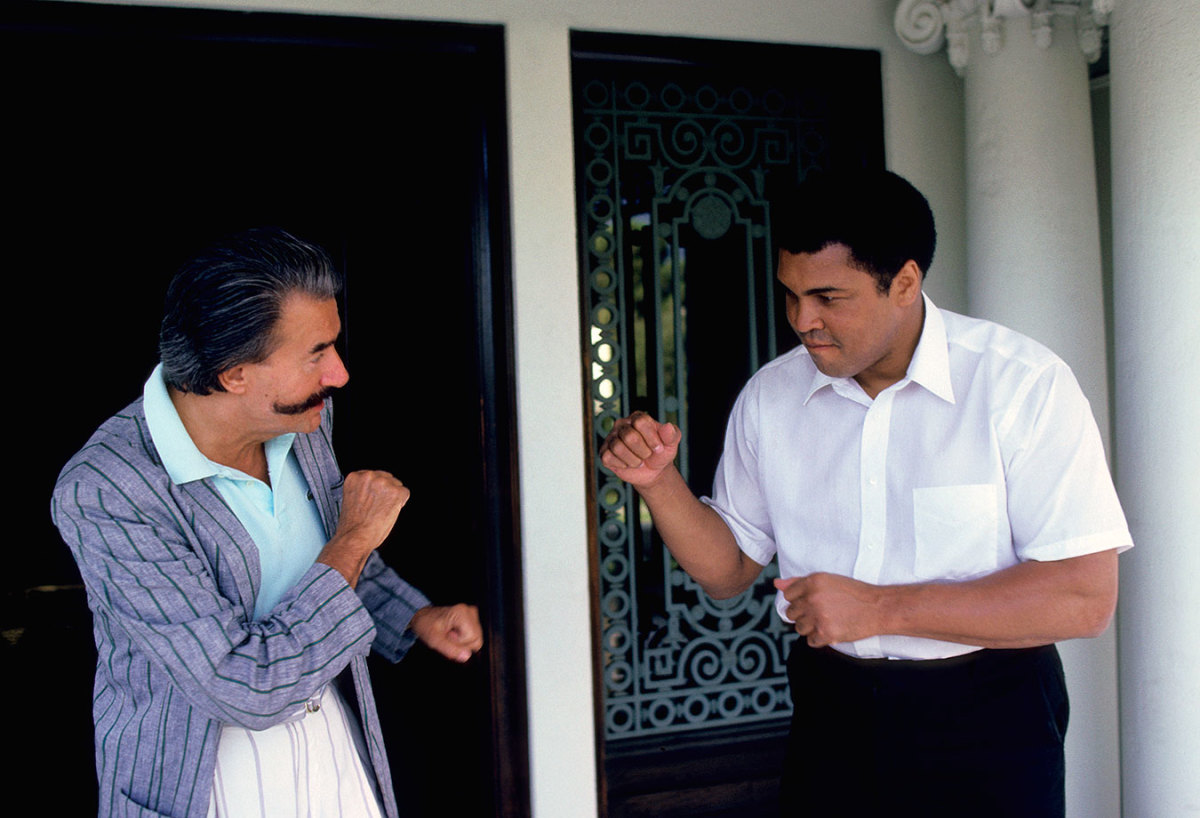
Ali pretends to spar with artist LeRoy Neiman at his home in Los Angeles. Neiman met Ali in 1962 and made many paintings and sketches from throughout Ali's life.
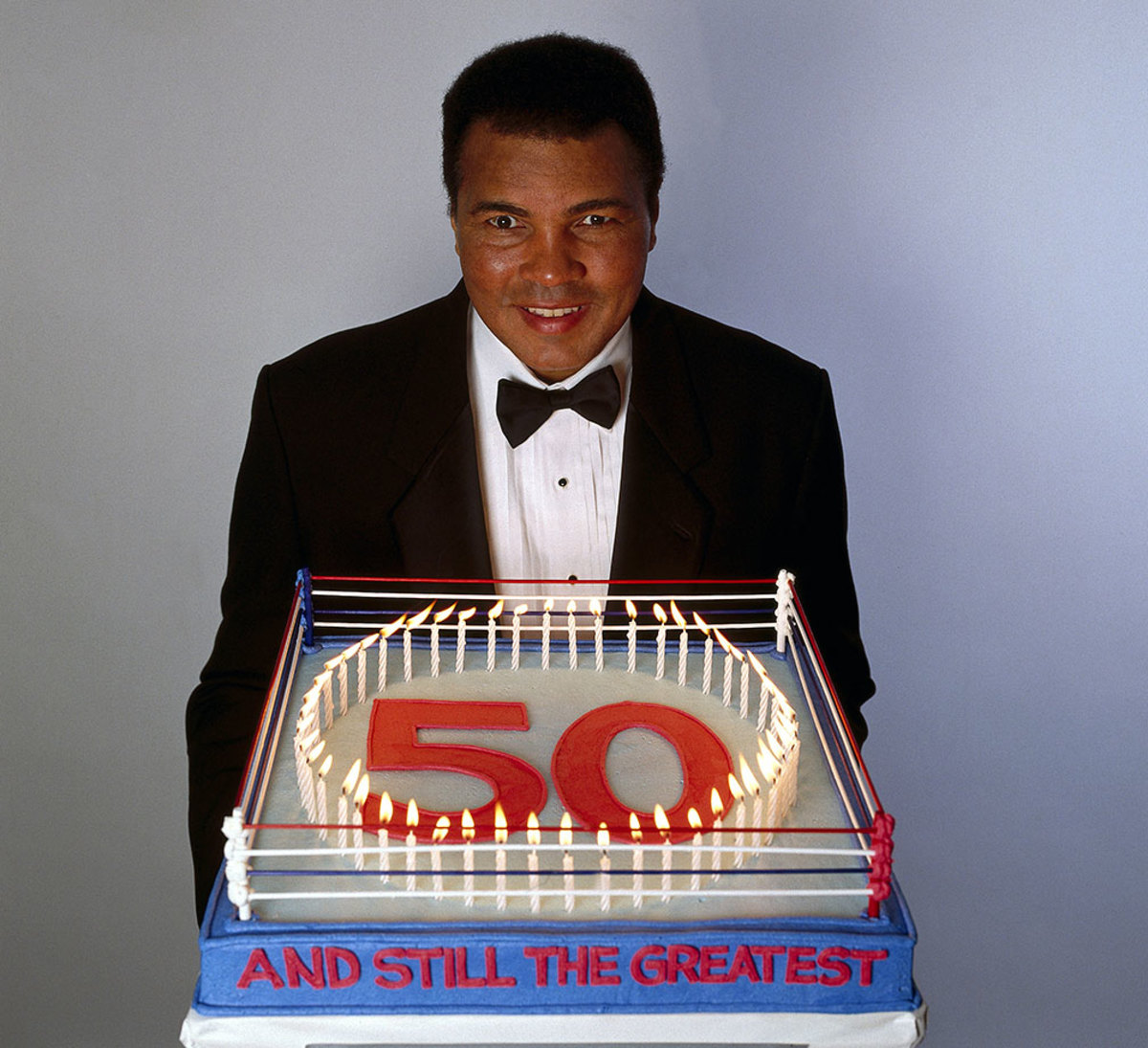
Cake in hand, Ali poses for a 50th birthday portrait in 1991. Although diagnosed with Parkinson's syndrome seven years earlier, Ali was still active, traveling to Iraq during the Gulf War to meet with Saddam Hussein in an attempt to negotiate the release of American hostages.
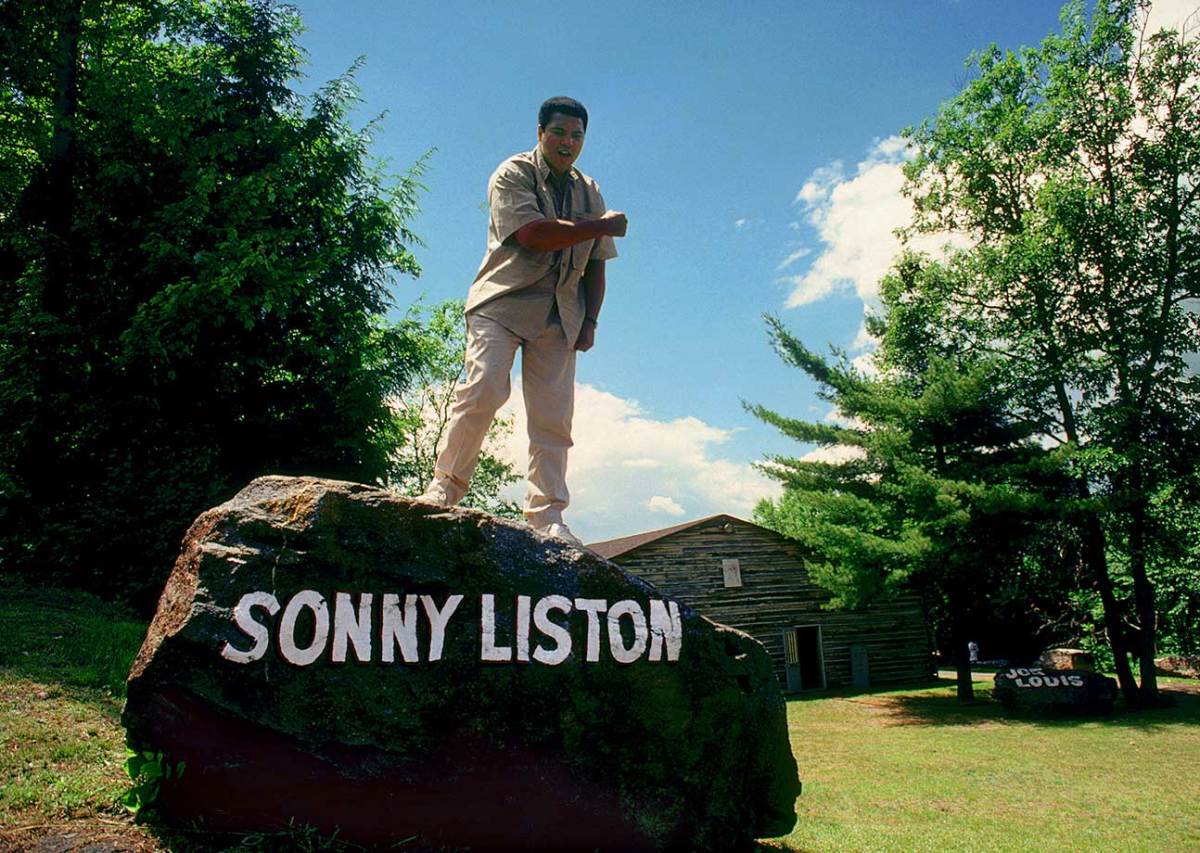
The same year, Ali stands atop of the Sonny Liston rock at his old training camp cabin. Ali and his father painted the names of famous boxers he admired on 18 boulders at the camp.
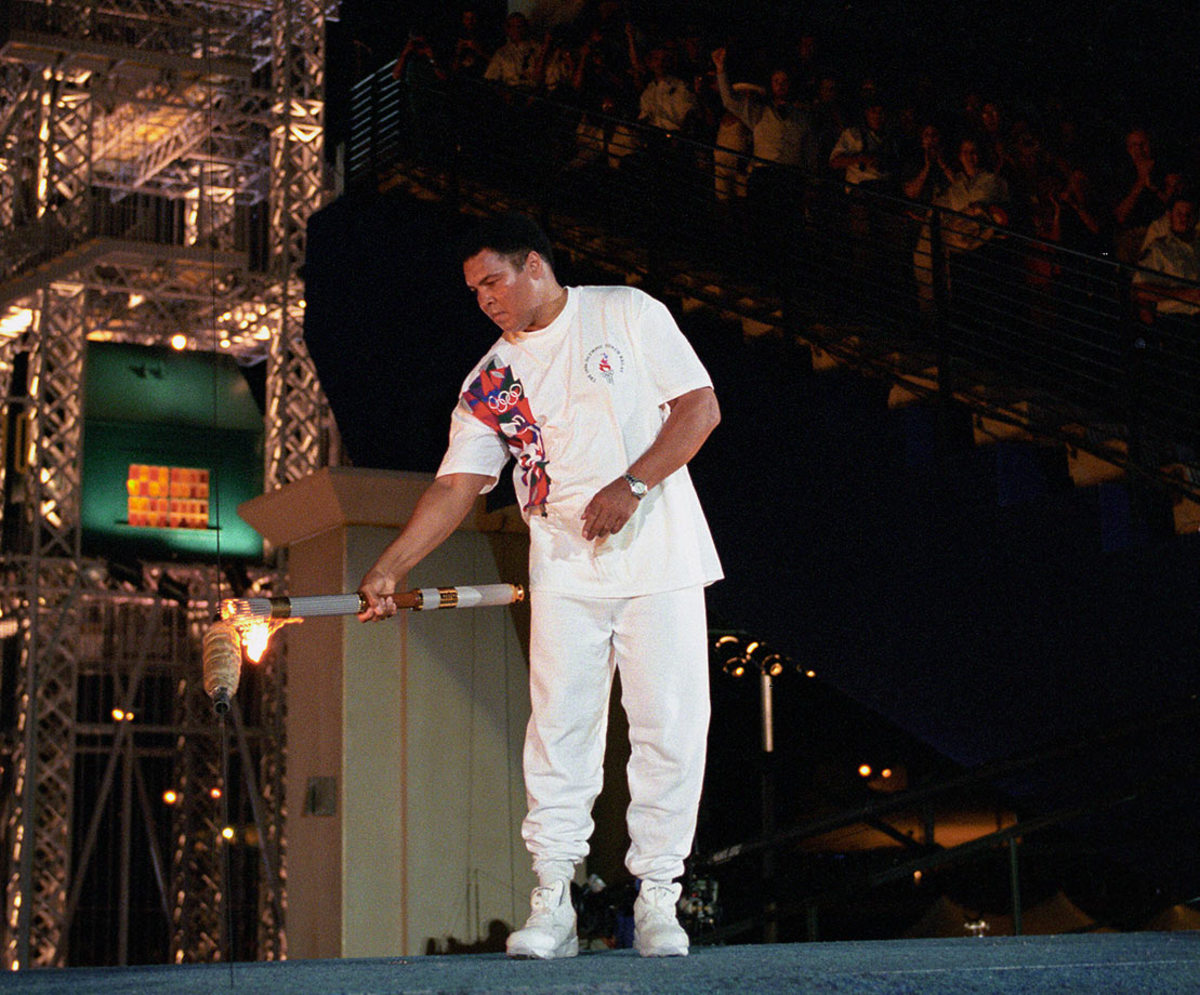
Ali carries the Olympic torch inside Centennial Olympic Stadium at the 1996 Atlanta Olympics. Despite trembling hands, Ali had the honor to light the Olympic flame in the stadium.
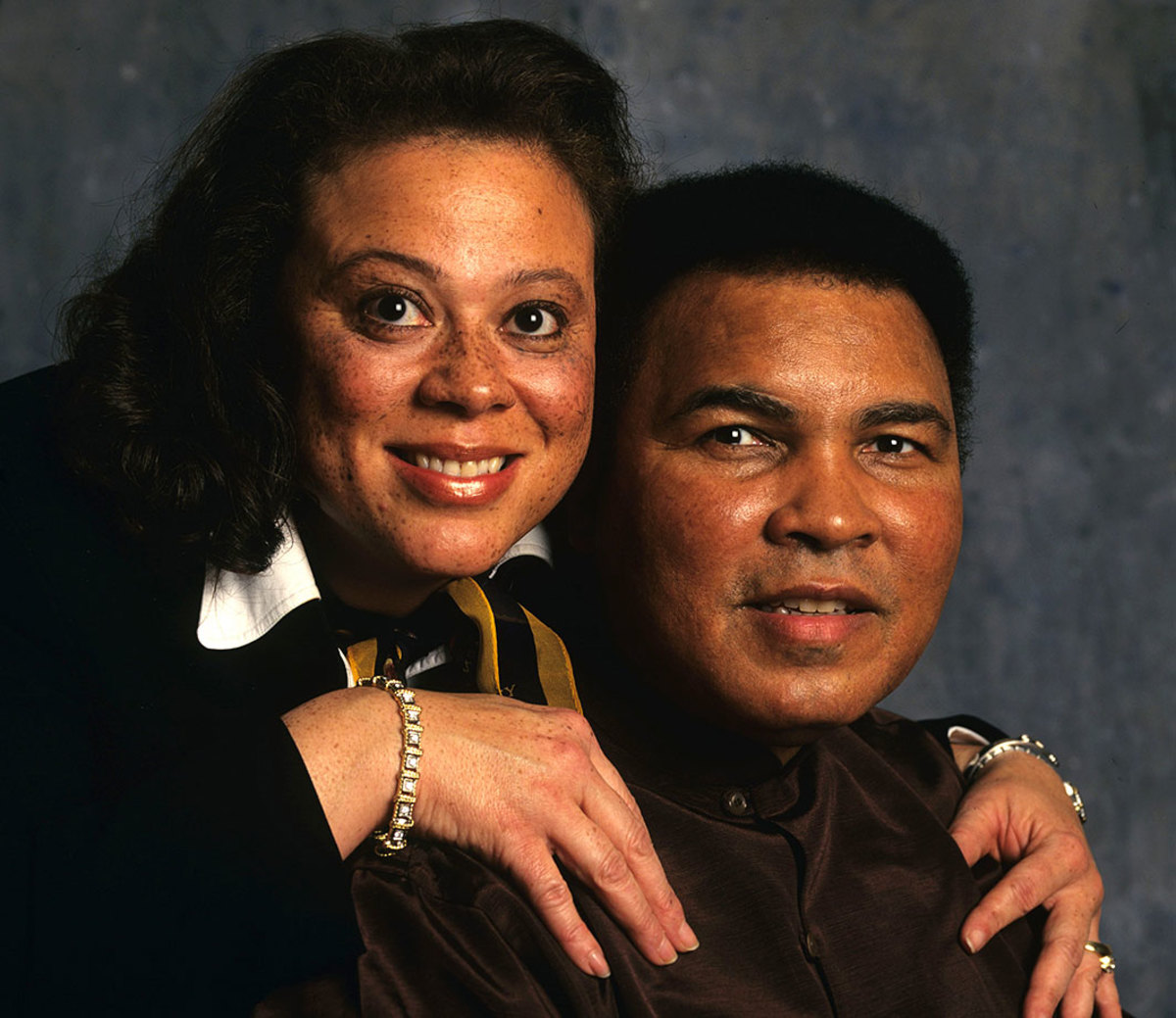
Husband and wife pose for a portrait during a photo shoot in 1997. Muhammad and Lonnie married in 1986 and have an adopted son together, Asaad Amin Ali.
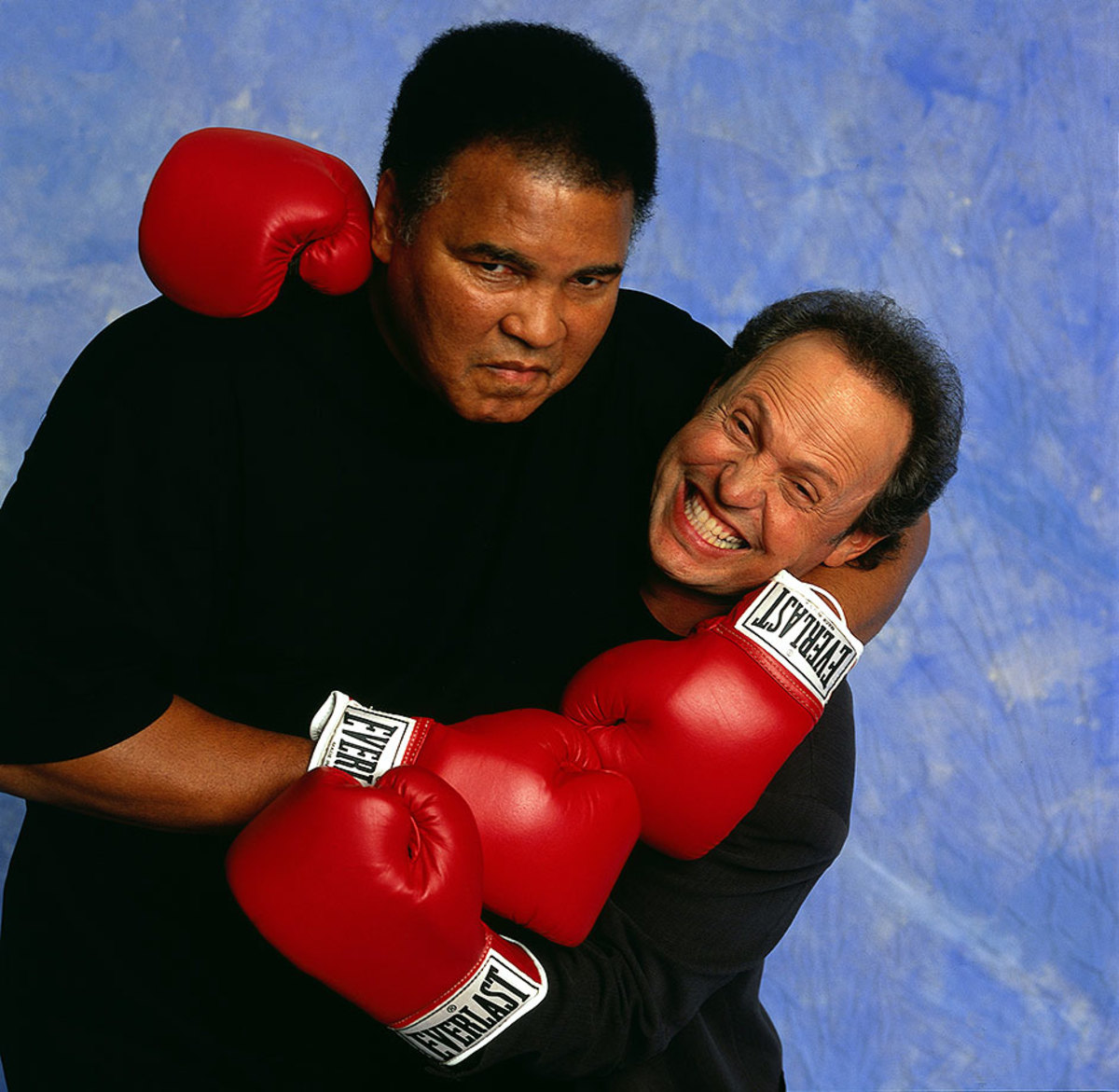
Ali messes around with actor Billy Crystal during a photo shoot in 2000. Crystal's impression of Ali was notorious, and he performed at a tribute to the boxer on his 50th birthday in December 1991.
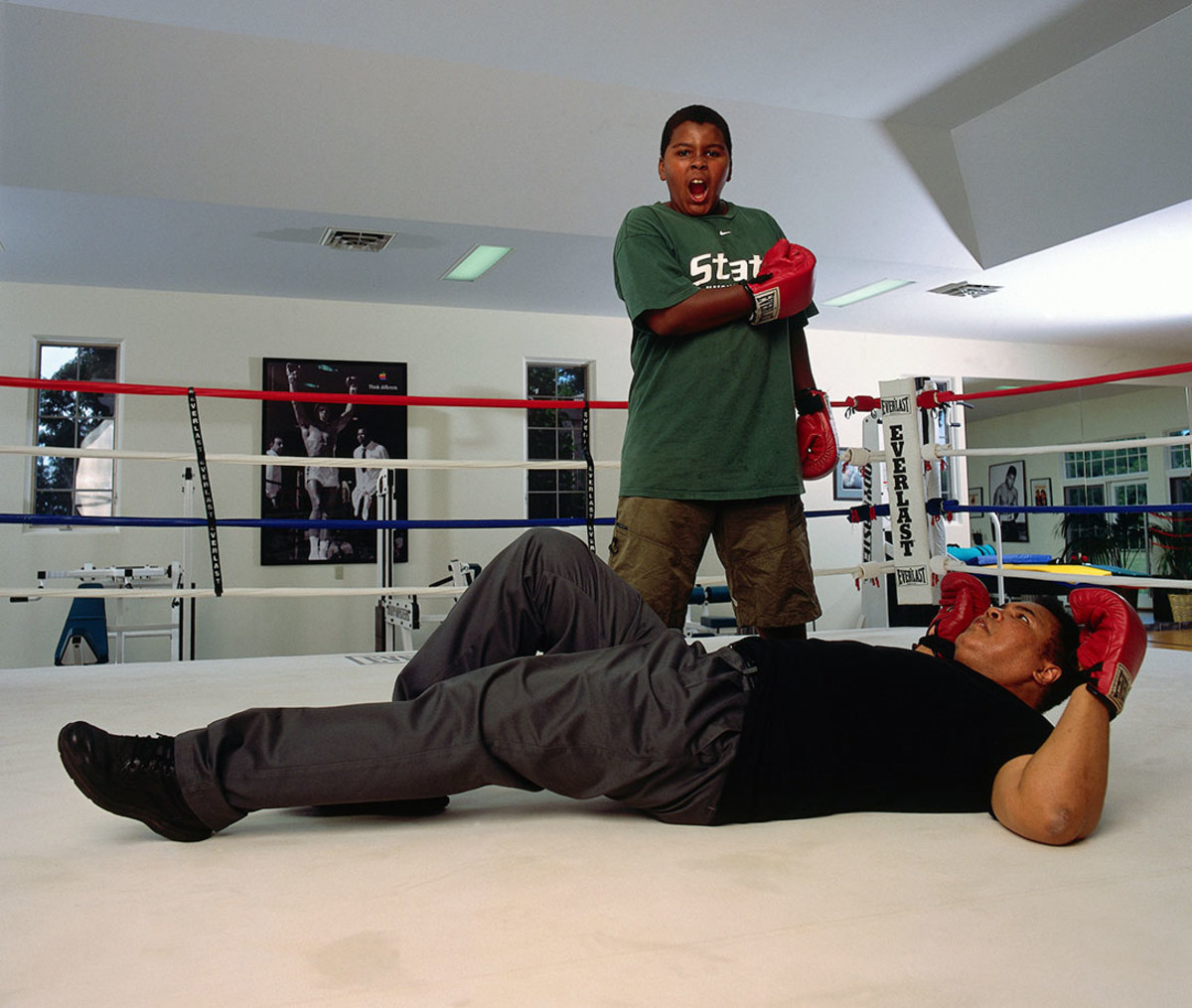
Ali lies on the canvas as his son, Assad Amin Ali, stands over him invoking memories of Ali's victory over Sonny Liston during a photo shoot in the gym at his farm on Kephart Road near Berrien Springs in 2001.
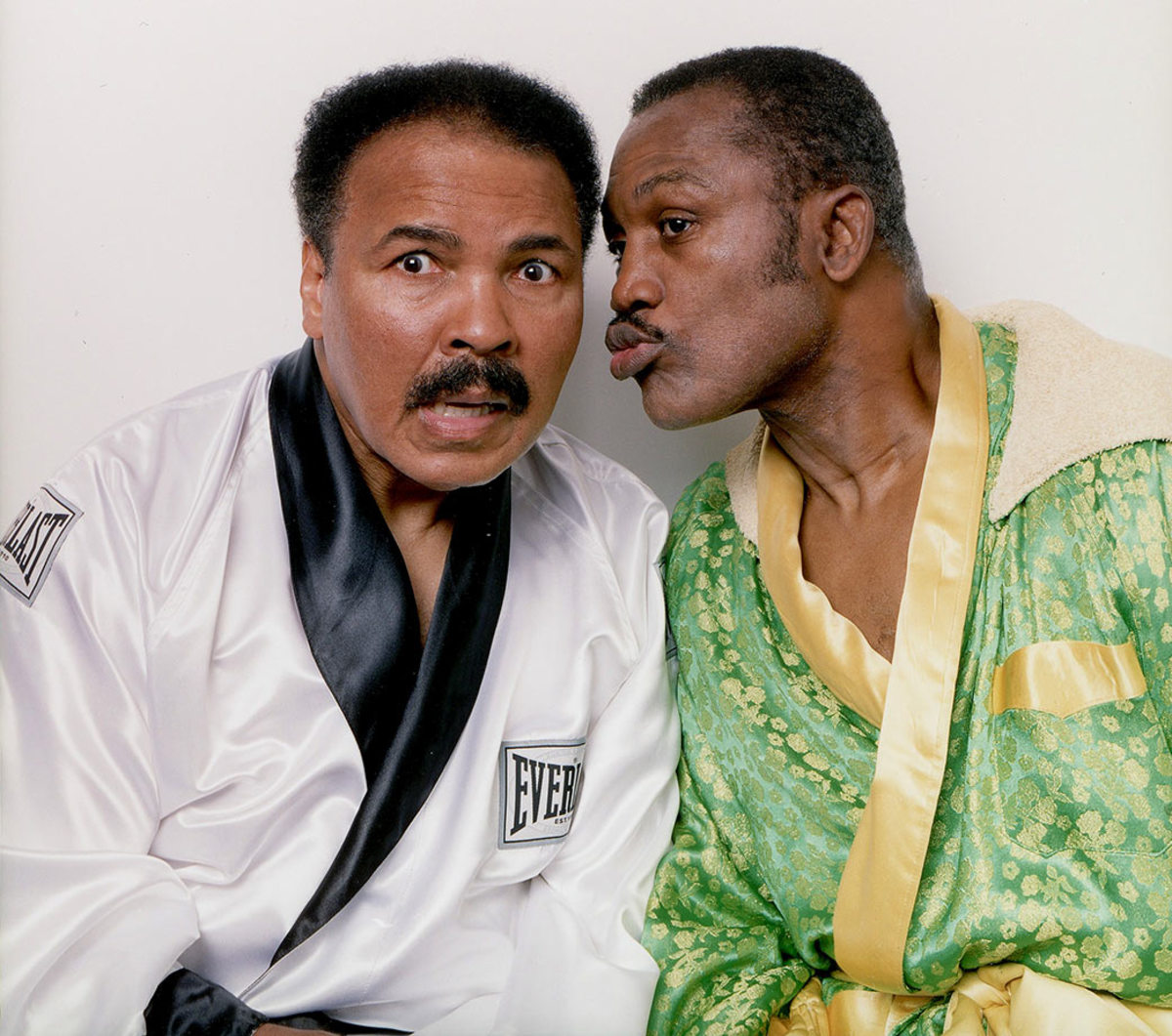
Fierce rivals in the ring, Ali and Joe Frazier pose for a portrait in the boxing robes they wore the night of their first bout at Frazier's Gym in 2003. Ali said after Frazier's death in 2011 that he was "a great champion."
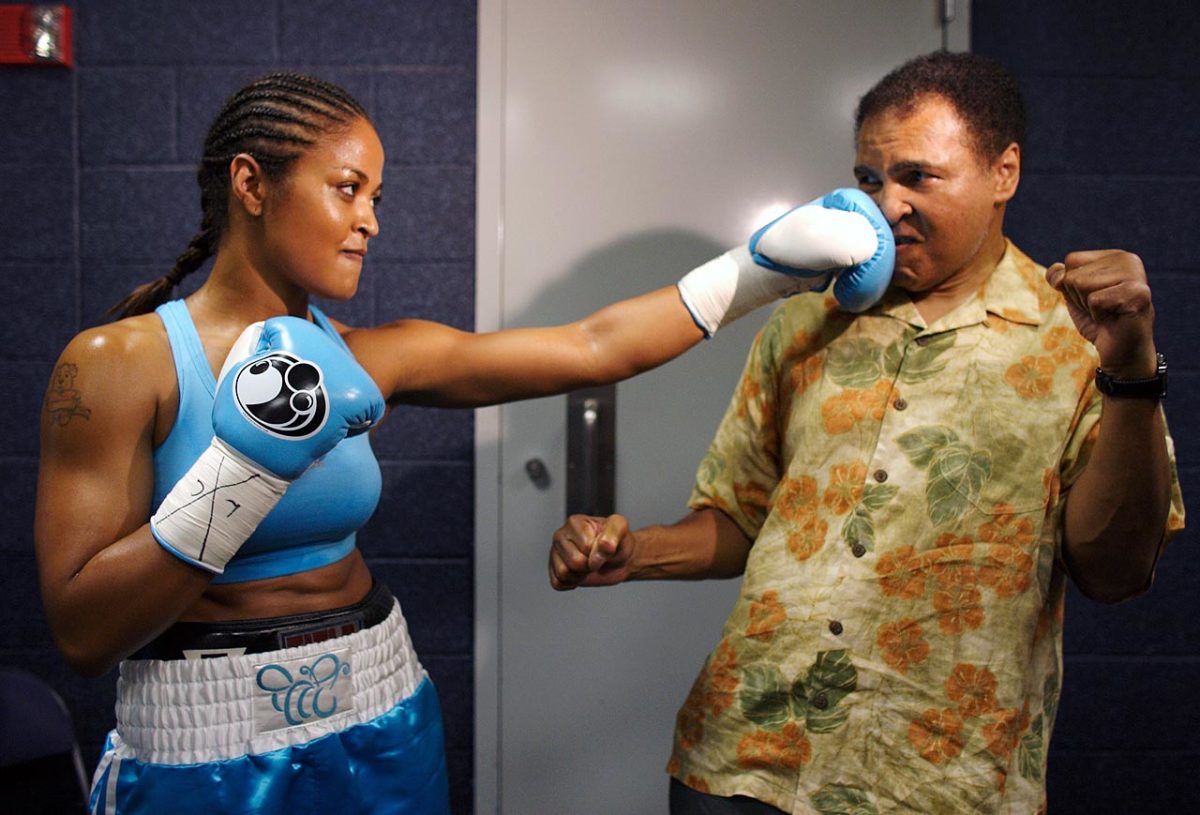
Ali takes a punch from his daughter Laila Ali while sparring before her fight against Erin Toughill in 2005. Laila retired from her own successful boxing career with a professional record of 24-0.
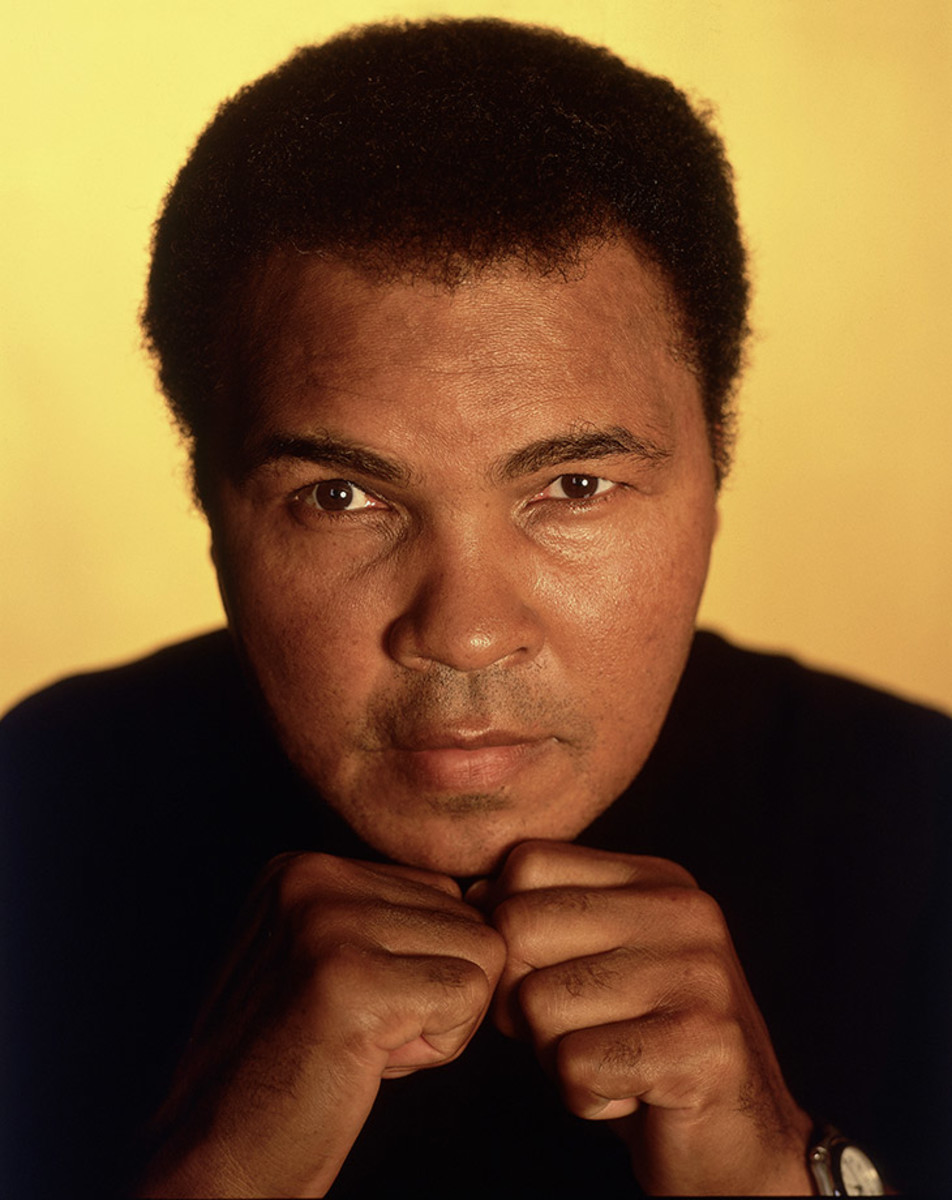
Ali poses with his fists up for a portrait in 2005.
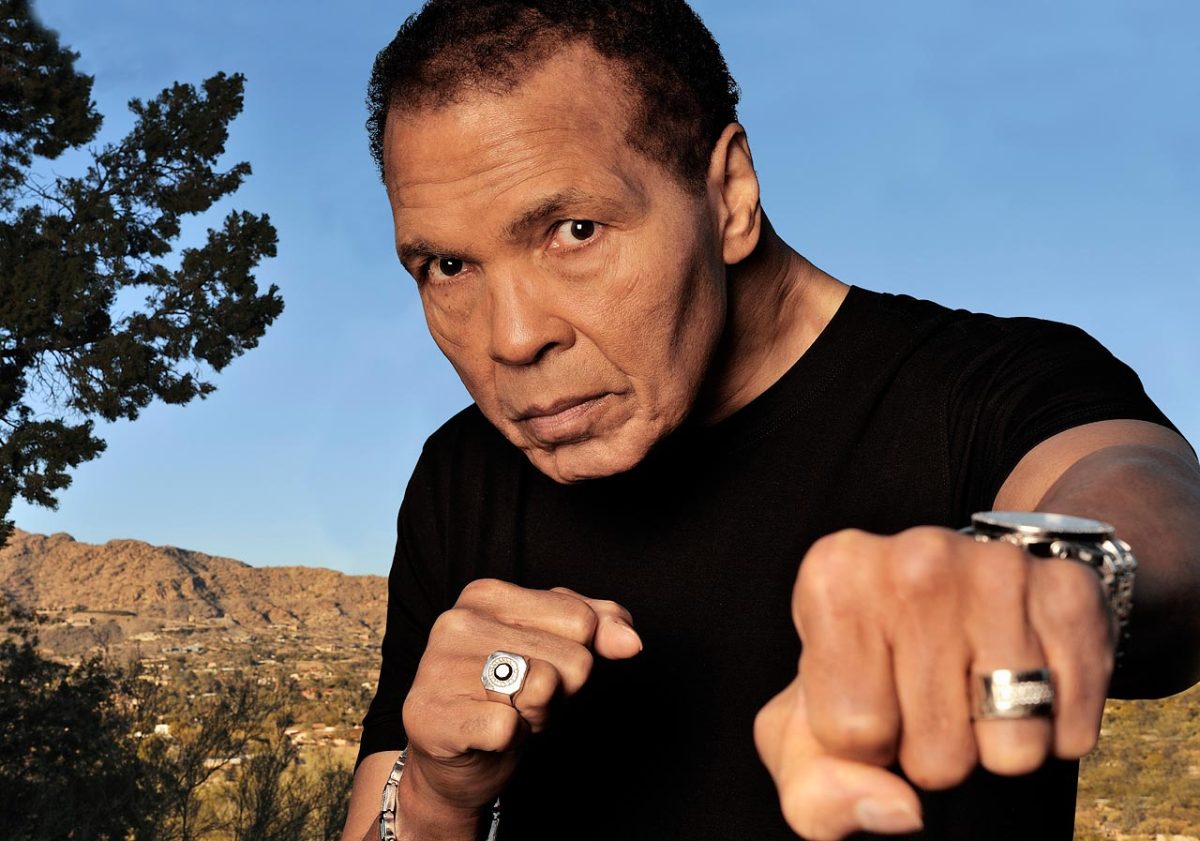
Ali poses with an extended punch in a 2012 photo shoot at his home in Paradise Valley, Ariz., to mark his 70th birthday.
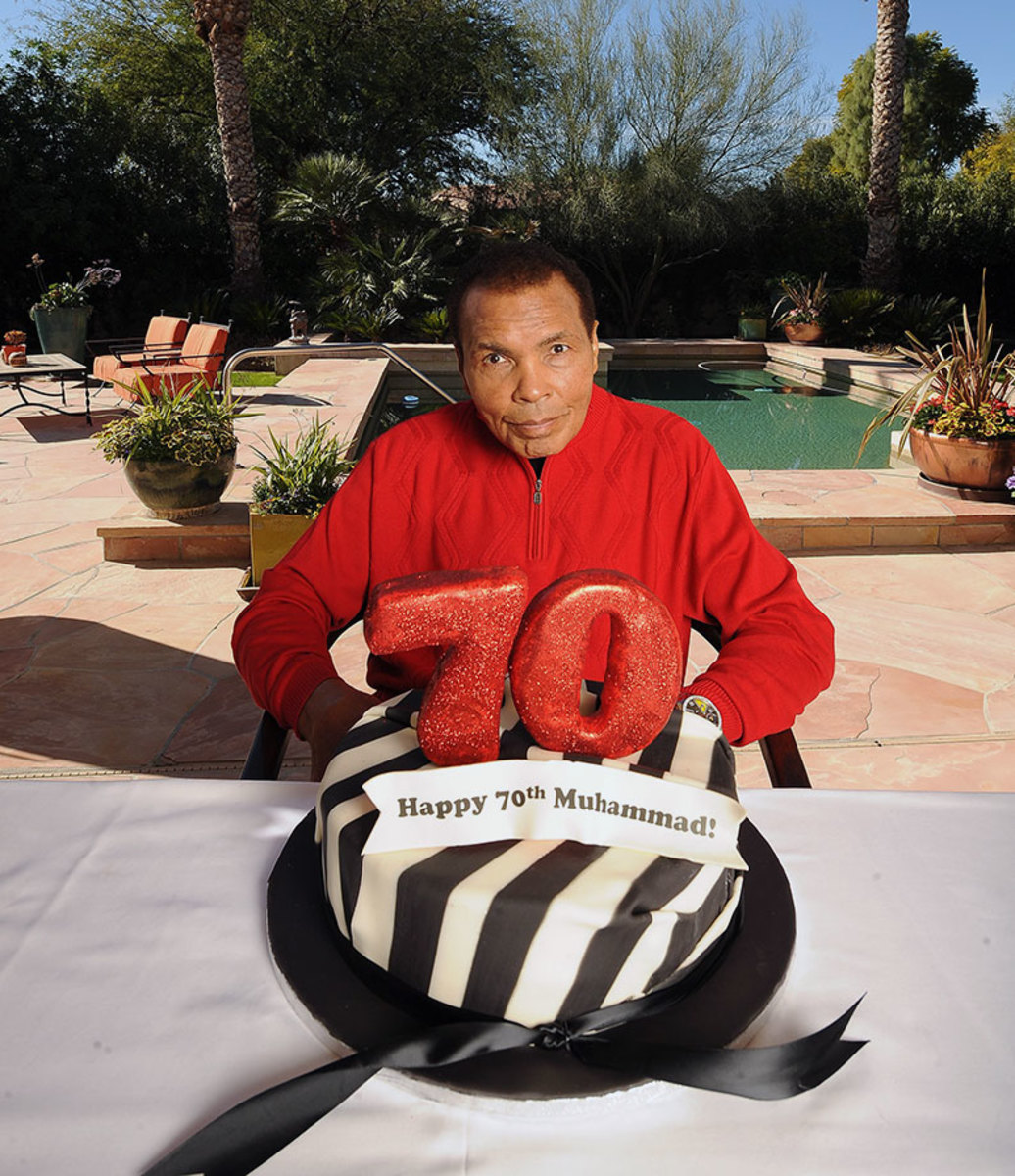
Ali sits in front of a 70th birthday cake in January 2012 at his Arizona home. Later that year he appeared at the opening ceremonies for the 2012 Olympics in London to escort the Olympic flag into the stadium, 52 years after he won gold in Rome.
